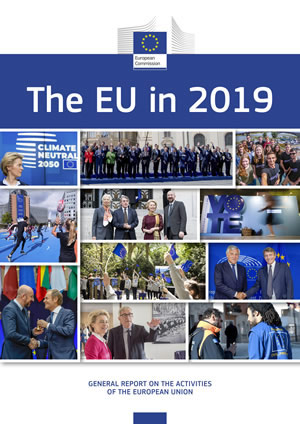
The EU in 2019 [Updated: 10/03/2020 09:56]
Find out everything you need to know about the European Union’s achievements in 2019.
The General Report on the Activities of the European Union brings you up to date on how the EU delivered on the 10 priorities set by the Juncker Commission.
As well as the results of the European elections, find out about the changes at the top of the EU institutions, including the first actions of the new European Commission, which took office in December.
You can find information on these and many more issues in The EU in 2019.
Foreword

Ursula von der Leyen, President of the European Commission.
I am delighted to present this report on the activities of the European Union in 2019. I took office as President of the European Commission on 1 December 2019, so I would like to pay tribute to my predecessor, Jean-Claude Juncker, under whose watch most of the achievements highlighted in this report took place.
At the European elections last May, Europeans showed us clearly that they want the Union to lead the way and to take real action. This is why, even before the end of the year, I proposed the European Green Deal as the first initiative of the new Commission. It is our commitment to making Europe the world’s first climate-neutral continent by 2050. It is good for people, for the planet and for the economy.
I hope that, like me, you find much to inspire in this report. The vast range of actions and initiatives that it describes demonstrates, once again, how much we can achieve together.
Long live Europe.

Ursula von der Leyen
The EU in 2019:
a year of change
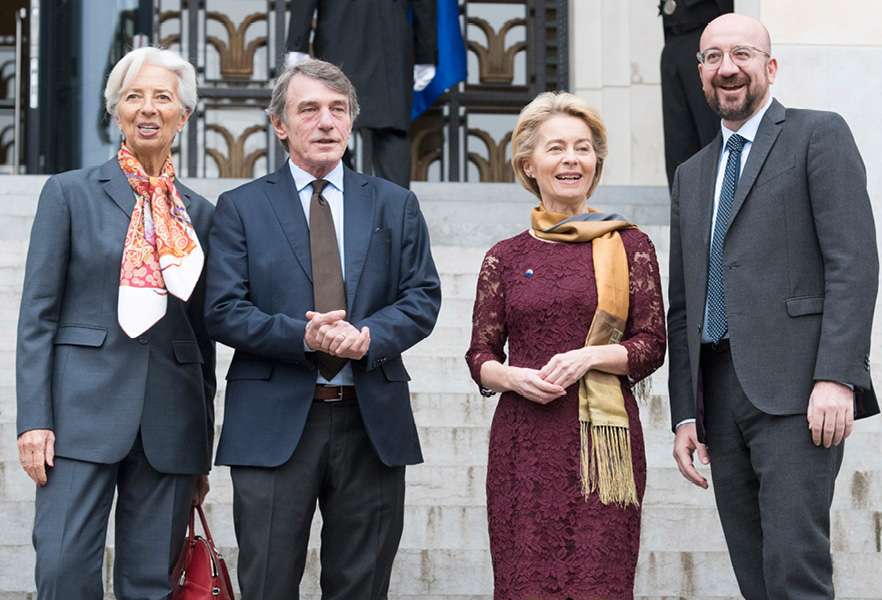
The new EU leaders. Christine Lagarde, President of the European Central Bank, David Sassoli, President of the European Parliament, Ursula von der Leyen, President of the European Commission, and Charles Michel, President of the European Council, attend the ceremony to mark the start of the new European Commission and the 10th anniversary of the Treaty of Lisbon at the House of European History, Brussels, Belgium, 1 December 2019.
2019 brought the Juncker Commission to a close, ending a 5-year cycle that saw significant improvement in the European economy, steps taken to fulfil the EU’s commitments under the Paris Agreement on climate change, a focus on improving democracy and transparency, and the challenge of the United Kingdom’s withdrawal from the EU. European elections were held in May and the highest voter turnout in 25 years saw over 200 million people cast their votes in the largest transnational democratic exercise in the world.
David Sassoli became President of the European Parliament on 3 July 2019, Charles Michel took over from Donald Tusk as President of the European Council on 1 December and Ursula von der Leyen became President of the European Commission on the same date.
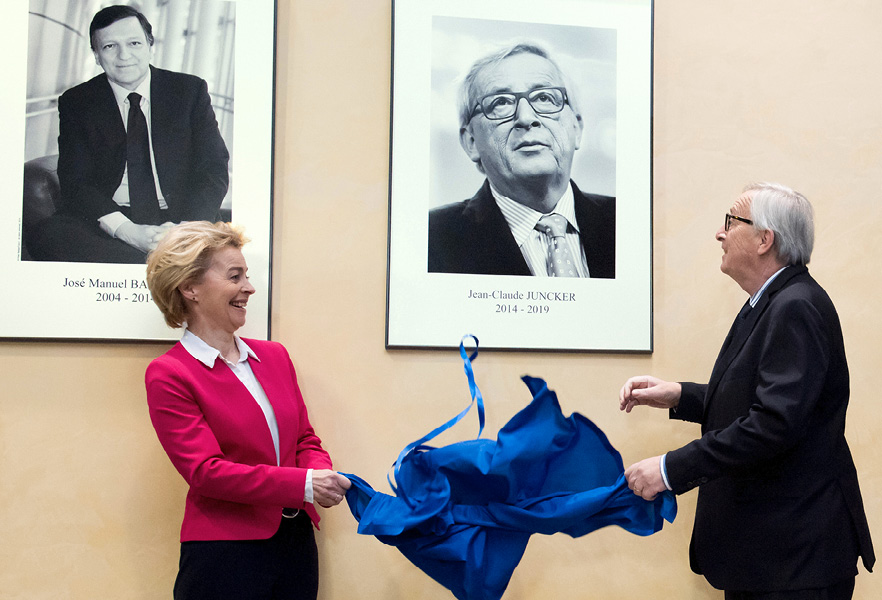
Ursula von der Leyen, President of the European Commission, and Jean-Claude Juncker, former President of the European Commission, unveil his portrait in the Presidents Gallery of the European Commission Berlaymont headquarters, Brussels, Belgium, 3 December 2019.
European Parliament elections
From 23 to 26 May 2019, elections were held across the 28 Member States of the EU to choose the people’s representatives to the European Parliament. A total of 751 Members of the European Parliament (MEPs) were elected, and shifts in voter preferences changed the political distribution of seats.
For the first time in decades, a majority of eligible voters across the EU cast a vote. This was also the first time since 1979 (the first direct elections to the European Parliament) that the overall voter turnout increased, from 42.6 % in 2014 to 50.7 %. There was also a high level of mobilisation among younger voters, with a 14 % increase in voters aged 16 or 18 to 24 and a 12 % increase in voters aged 25 to 39.
The Eurobarometer survey following the elections showed that people were motivated to vote primarily because of concerns about the economy and climate change.
The European Parliament and the European Commission worked closely together ahead of the elections, both at EU level and on the ground in Member States, to mobilise citizens and empower them to take informed decisions on Europe’s future. Building on this experience, on 5 December both institutions signed an agreement on joint communication at the service of citizens and democracy in order to deepen their cooperation beyond the elections.

‘This time I’m voting’, a campaign launched by the European Parliament in collaboration with other EU institutions, encourages the public to take the future of the European project into their own hands.© European Parliament, 2019

Voter turnout in the last four European Parliament elections was 45.5 % in 2004, 43 % in 2009, 42.6 % in 2014 and 50.7 % in 2019. Source: European Parliament in collaboration with Kantar.
European Parliament 2019-2024
The European People’s Party remained the biggest group in Parliament, winning 182 seats out of 751, closely followed by the Progressive Alliance of Socialists and Democrats, with 154 seats. Despite holding on to their top spots, both groups lost voters to the right and the left sides of the spectrum. Renew Europe, The Greens/European Free Alliance and Identity and Democracy all made significant gains compared to the previous parliamentary elections. The total number of female MEPs reached 40.4 %, the highest level since European elections began in 1979.
On 1 July, the outgoing European Parliament held the last session of its eighth term, and the new Parliament met for its constituent session in Strasbourg the following day.
During the first plenary session of the new Parliament, MEPs elected their new president and vice-presidents. On 3 July, the long-serving Italian MEP David Sassoli was elected president. The 14 vice-presidents were elected on the same day and hail from six political groups and 10 Member States.
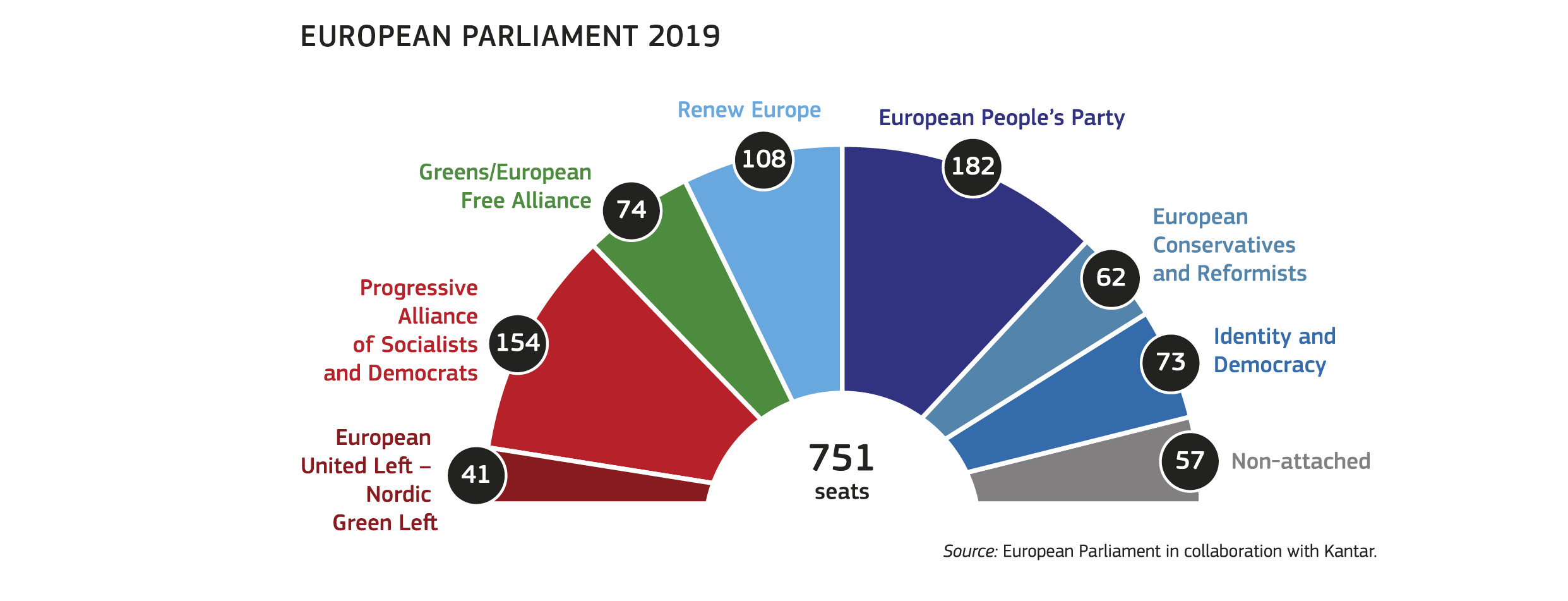
In 2019, the European Parliament was composed of 751 Members of the European Parliament divided into seven political groups. These were, from left to right politically: the European United Left ‒ Nordic Green Left, with 41 seats; the Progressive Alliance of Socialists and Democrats, with 154 seats; the Greens/European Free Alliance, with 74 seats; Renew Europe, with 108 seats; the European People’s Party, with 182 seats; the European Conservatives and Reformists, with 62 seats; and Identity and Democracy, with 73 seats. In addition, non-attached members held 57 seats. Source: European Parliament Copyright: European Union
Citizens voted in these European elections based on a very strong support for the EU and with a much stronger belief that their voice counts in the EU
David Sassoli, President of the European Parliament
European Council
First elected on 1 December 2014, Donald Tusk ended his second term as President of the European Council 5 years later. On 2 July 2019, EU leaders elected Charles Michel to replace him. He took up his post on 1 December.
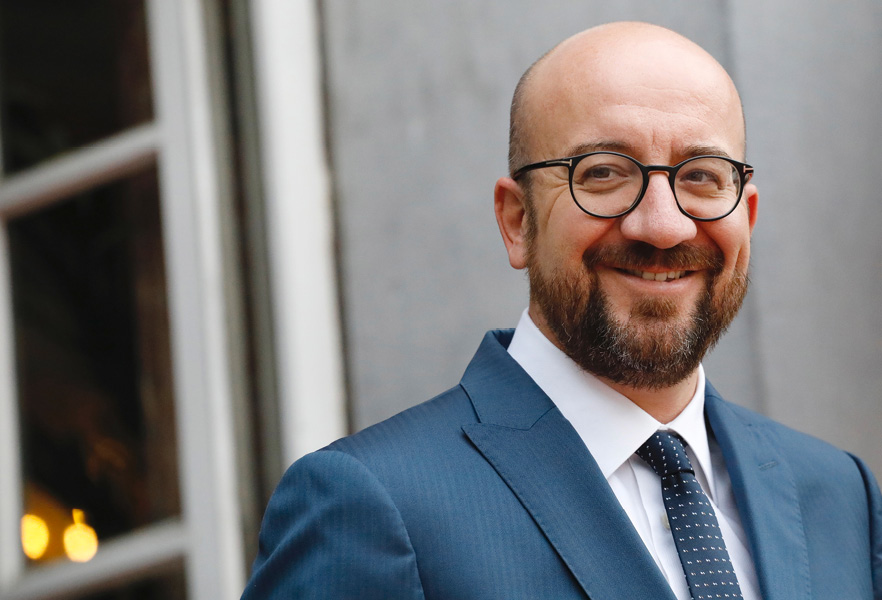
Charles Michel, President of the European Council.
European Commission
In June, EU leaders proposed Ursula von der Leyen as their candidate for President of the Commission. The following month, she presented her political priorities to guide the Commission’s work over the next 5 years.

The College of Commissioners for the term 2019 to 2024 is composed as follows. Ursula von der Leyen, President of the European Commission; Frans Timmermans, Executive Vice-President for the European Green Deal; Margrethe Vestager, Executive Vice-President for A Europe Fit for the Digital Age; Valdis Dombrovskis, Executive Vice-President for An Economy that Works for People; Josep Borrell Fontelles, High Representative/Vice-President for A Stronger Europe in the World; Maroš Šefčovič, Vice-President for Interinstitutional Relations and Foresight; Věra Jourová, Vice-President for Values and Transparency; Dubravka Šuica, Vice-President for Democracy and Demography; Margaritis Schinas, Vice-President for Promoting our European Way of Life; Johannes Hahn, Commissioner for Budget and Administration; Phil Hogan, Commissioner for Trade; Mariya Gabriel, Commissioner for Innovation, Research, Culture, Education and Youth; Nicolas Schmit, Commissioner for Jobs and Social Rights; Paolo Gentiloni, Commissioner for Economy; Janusz Wojciechowski, Commissioner for Agriculture; Thierry Breton, Commissioner for Internal Market; Elisa Ferreira, Commissioner for Cohesion and Reforms; Stella Kyriakides, Commissioner for Health and Food Safety; Didier Reynders, Commissioner for Justice; Helena Dalli, Commissioner for Equality; Ylva Johansson, Commissioner for Home Affairs; Janez Lenarčič, Commissioner for Crisis Management; Adina Vălean, Commissioner for Transport; Olivér Várhelyi, Commissioner for Neighbourhood and Enlargement; Jutta Urpilainen, Commissioner for International Partnerships; Kadri Simson, Commissioner for Energy; Virginijus Sinkevičius, Commissioner for Environment, Oceans and Fisheries. Source: European Commission Copyright: European Union

The College of Commissioners for the term 2019 to 2024 is composed as follows. Ursula von der Leyen, President of the European Commission; Frans Timmermans, Executive Vice-President for the European Green Deal; Margrethe Vestager, Executive Vice-President for A Europe Fit for the Digital Age; Valdis Dombrovskis, Executive Vice-President for An Economy that Works for People; Josep Borrell Fontelles, High Representative/Vice-President for A Stronger Europe in the World; Maroš Šefčovič, Vice-President for Interinstitutional Relations and Foresight; Věra Jourová, Vice-President for Values and Transparency; Dubravka Šuica, Vice-President for Democracy and Demography; Margaritis Schinas, Vice-President for Promoting our European Way of Life; Johannes Hahn, Commissioner for Budget and Administration; Phil Hogan, Commissioner for Trade; Mariya Gabriel, Commissioner for Innovation, Research, Culture, Education and Youth; Nicolas Schmit, Commissioner for Jobs and Social Rights; Paolo Gentiloni, Commissioner for Economy; Janusz Wojciechowski, Commissioner for Agriculture; Thierry Breton, Commissioner for Internal Market; Elisa Ferreira, Commissioner for Cohesion and Reforms; Stella Kyriakides, Commissioner for Health and Food Safety; Didier Reynders, Commissioner for Justice; Helena Dalli, Commissioner for Equality; Ylva Johansson, Commissioner for Home Affairs; Janez Lenarčič, Commissioner for Crisis Management; Adina Vălean, Commissioner for Transport; Olivér Várhelyi, Commissioner for Neighbourhood and Enlargement; Jutta Urpilainen, Commissioner for International Partnerships; Kadri Simson, Commissioner for Energy; Virginijus Sinkevičius, Commissioner for Environment, Oceans and Fisheries. Source: European Commission Copyright: European Union
On 16 July, the European Parliament elected Ursula von der Leyen as the next President of the European Commission, the first time a woman has been chosen for this post. In consultation with national leaders, she put together a College of Commissioners, nominated by 26 Member States, with a strong emphasis on creating a gender-balanced team that includes 12 women, including von der Leyen.
Following the hearings for each Commissioner-designate and a parliamentary debate, the Parliament approved von der Leyen’s College of Commissioners in a plenary vote on 27 November. The new Commission took office on 1 December.
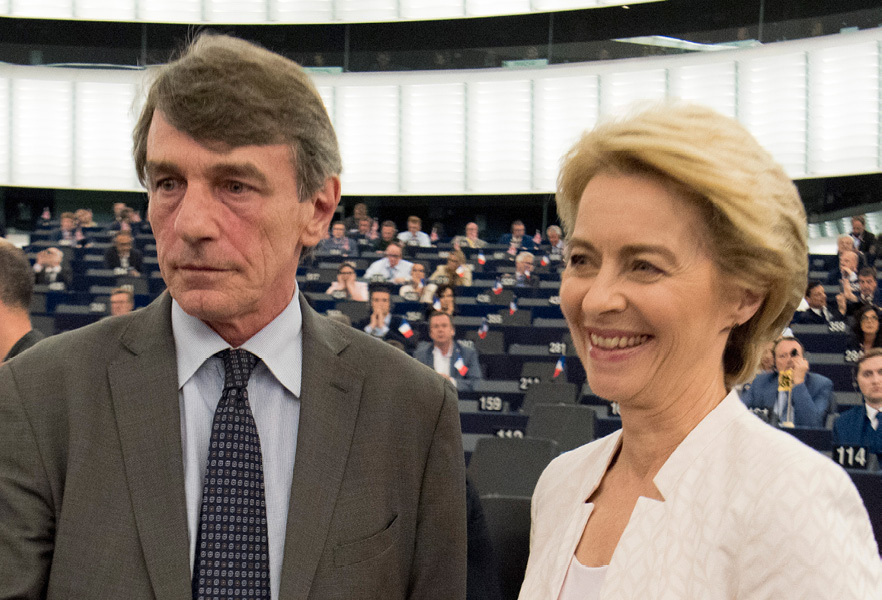
David Sassoli, President of the European Parliament, and Ursula von der Leyen, President-elect of the European Commission, at a plenary session of the European Parliament, Strasbourg, France, 16 July 2019.
European Central Bank
The outgoing President of the European Central Bank, Mario Draghi, completed his 8-year term on 31 October 2019. The former Director of the International Monetary Fund, Christine Lagarde, took over on 1 November. She is the first woman to head the bank.

Christine Lagarde, President of the European Central Bank.
© European Union, 2019; European Central Bank
First European Chief Prosecutor
In September, the European Parliament and the Council of the European Union appointed Laura Codruţa Kövesi as the first European Chief Prosecutor. She heads the independent European Public Prosecutor’s Office, protecting taxpayers’ money by investigating fraud and other criminal offences against the EU budget.
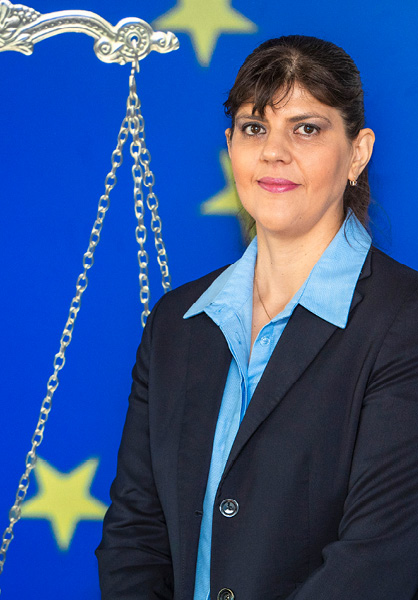
Laura Codruţa Kövesi, the first European Chief Prosecutor.
How the new European Commission will work
The new European Commission has set six priorities for 2019 to 2024:
- a European Green Deal;
- an economy that works for people;
- a Europe fit for the digital age;
- promoting our European way of life;
- a stronger Europe in the world;
- a new push for European democracy.
President von der Leyen appointed eight vice-presidents to the College, including the High Representative of the Union for Foreign Affairs and Security Policy, Josep Borrell Fontelles. Three of these will also serve as executive vice-presidents, each in charge of one of the top three political guidelines in the president’s agenda, alongside their own portfolio.
Executive Vice-President Frans Timmermans is coordinating the European Commission’s work on the European Green Deal, with Climate Action as his portfolio. Alongside her work as Commissioner for Competition, Executive Vice-President Margrethe Vestager is in charge of the priority ‘A Europe fit for the digital age’. Executive Vice-President Valdis Dombrovskis has become Commissioner for Financial Services and is in charge of delivering on the priority ‘An economy that works for people’.
Aside from working on the six priorities, President von der Leyen has stated that she will preside over a College that is committed, that understands Europe and that listens to what Europeans want. A major goal of the new Commission is to make life easier for people and for businesses. When the Commission creates new laws and regulations, it will operate the ‘one in, one out’ policy to cut bureaucracy for citizens.
European Green Deal
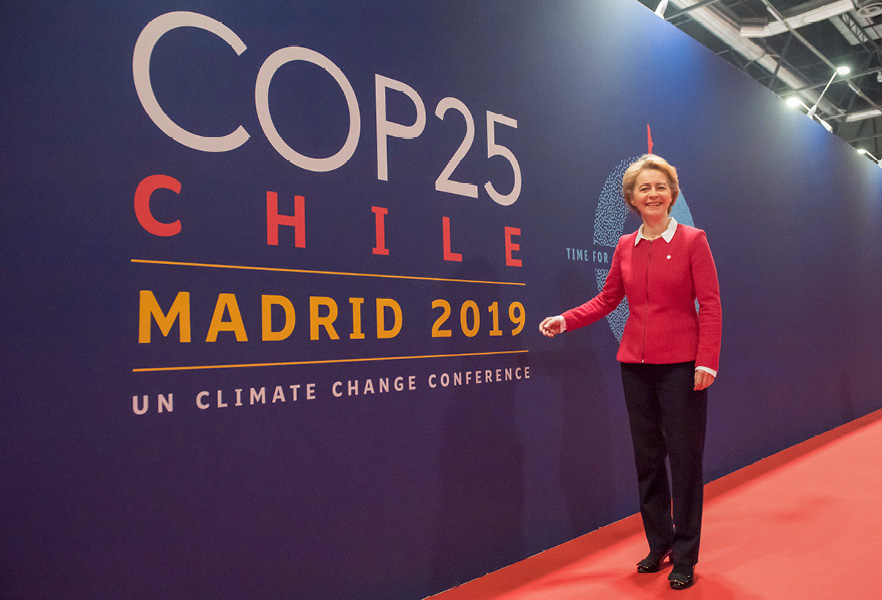
Our goal is to reconcile the economy with our planet, to reconcile the way we produce and the way we consume with our planet and to make it work for our people. Ursula von der Leyen, President of the European Commission, Brussels, Belgium, 11 December 2019.
Ursula von der Leyen, President of the European Commission, Brussels, Belgium, 11 December 2019.
The first and most important of the six priorities, the European Green Deal, was presented by President von der Leyen on 11 December 2019, less than 2 weeks after the Commission took office. This flagship policy, which seeks to make Europe the world’s first climate-neutral continent by 2050, comprises an extremely ambitious set of measures that should enable European citizens and businesses to benefit from the sustainable green transition.
The European Green Deal is a comprehensive response to the immediate climate emergency threatening the planet. It is also a unique opportunity for the EU to become the front-runner in the global green transition. However, going green does not mean sacrificing growth. The Green Deal future-proofs the EU economy from resource depletion and sets out how the EU can achieve its climate-neutrality goal – while creating jobs, improving people’s health and quality of life, caring for nature and leaving no one behind.
Committing to change
The first-ever European climate law will make this transition irreversible. This will anchor in legislation Europe’s political ambition of becoming the first climate-neutral continent. The Green Deal will underpin all future EU policy and ensure the EU remains at the forefront of European and global action on sustainability.
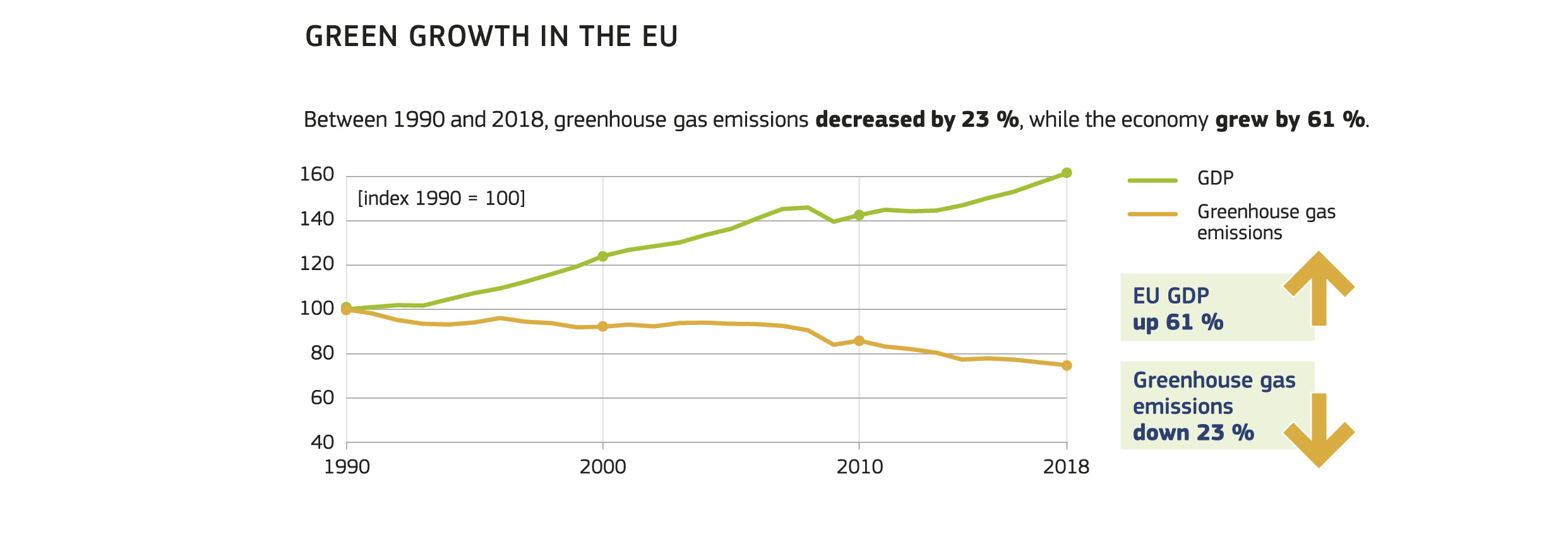
Between 1990 and 2018, greenhouse gas emissions decreased by 23 %, while the economy grew by 61 %.

The European Union has committed to becoming climate neutral by 2050, protecting human life, animals and plants by cutting pollution, and helping companies become world leaders in clean products and technologies, all of this while ensuring a just and inclusive transition. Ursula von der Leyen, President of the European Commission, said, The European Green Deal is our new growth strategy. It will help us cut emissions while creating jobs. Frans Timmermans, Executive Vice-President of the European Commission, echoed, We propose a green and inclusive transition to help improve people’s well-being and secure a healthy planet for generations to come. This commitment is also rooted in the conviction of most Europeans; 93 % of Europeans see climate change as a serious problem and claim to have taken at least one action to tackle climate change. 79 % agree that taking action on climate change will lead to innovation. Source: European Commission
The deal will have an impact on all areas of the EU economy, including heavy emitters like the transport sector, construction, energy and agriculture and industries such as steel, cement, information technology, textiles and chemicals.
Its comprehensive nature means the focus is on prevention and not just cure. Existing policies, like mitigating the impact of industry through recycling, will be bolstered by policies to reduce the waste or harm created in the first instance, starting with the manufacturing process.
As well as cutting emissions, the Green Deal will form Europe’s new growth strategy, creating jobs thanks to a new EU industrial strategy that will enable Europe’s businesses to innovate and develop new technologies.

The European Union will be climate neutral in 2050. The Commission will propose a European climate law turning the political commitment into a legal obligation and a trigger for investment. Reaching this target will require action by all sectors of our economy. The energy sector will be decarbonised as it currently accounts for more than 75 % of the EU’s greenhouse gas emissions. Buildings will be renovated to help people cut their energy bills and energy use, as 40 % of our energy is consumed by buildings. European industry, which currently uses only 12 % of recycled material, will be encouraged to innovate and become a global leader in the green economy. And in the transport sector, which represents 25 % of our emissions, cleaner, cheaper and healthier forms of private and public transport will be rolled out. Source: European Commission
Investing in the green transition
Meeting the objectives of the European Green Deal will require significant investment. Financing will need to come from both the private and the public sectors – the European Commission will lead the way with a Sustainable Europe Investment Plan to help meet investment needs. At least 25 % of the EU’s long-term budget should be dedicated to climate action, and the European Investment Bank will provide further support.
While fighting climate change is a common endeavour, not all regions and Member States start from the same point. A Just Transition Mechanism will support regions that rely heavily on activities that are very carbon intensive and will support citizens most vulnerable during the transition by, for example, providing access to reskilling programmes and employment opportunities in new economic sectors.

The European Green Deal aims to transform the European Union’s economy for a sustainable future. It will finance this transition by increasing the European Union’s climate ambition for 2030 and 2050, supplying clean, affordable and secure energy, mobilising industry for a clean and circular economy, and building and renovating in an energy- and resource-efficient way. It will ensure that the transition is just and that no one is left behind by mobilising research and fostering innovation. This will mean a zero-pollution ambition for a toxic-free environment, preserving and restoring ecosystems and biodiversity, and a new ‘from farm to fork’ approach for a fair, healthy and environmentally friendly food system. In addition, it will accelerate the shift to sustainable and smart mobility. Finally, the European Union will act as a global leader in climate-related issues and will work towards a real European Climate Pact. Source: European Commission Copyright: European Union

To achieve European Green Deal diplomacy and global leadership on climate issues, the next steps to take will be the proposal of a European climate law and the introduction of industrial and circular economy strategies in March 2020, and the increase of existing European Union 2030 climate targets to at least 50 % in summer 2020. Source: European Commission
The future of Europe
In Sibiu, Romania, on 9 May, the EU-27 leaders (from all Members States except for the United Kingdom) reflected on the next Strategic Agenda, which sets priorities and guides the work of the European Union for 2019-2024. Leaders also adopted the Sibiu Declaration, highlighting the unity between Member States shortly before the European Parliament elections. The Sibiu meeting marked the culmination of the process of reflection on the future of Europe with a renewed commitment to an EU that delivers on the issues that really matter to its citizens.
The first steps on ‘the road to Sibiu’ were taken in September 2016, when President Juncker announced a positive agenda for Europe, starting the reflection process on the future of Europe at 27. Following this, EU leaders adopted two important declarations on the path ahead: in Bratislava, Slovakia, in September 2016 and in Rome, Italy, in March 2017.
In March 2017, ahead of the 60th anniversary of the Treaty of Rome, the Commission published the White Paper on the Future of Europe. It outlined five possible scenarios for the EU’s future at 27. This was the starting point for a wide-ranging debate on the future of Europe, which inspired the main policy priorities of the Strategic Agenda. The Commission strongly promoted grassroots participation, developed new formats of citizens’ dialogues and consultations, made the debate more flexible and interactive, brought it online and reached out to a wider and more diverse audience. Hundreds of thousands of people of different nationalities, ages and religions and from across the political spectrum took part in close to 1 800 town-hall-style debates in city halls, universities and other places all across our Union. More than 80 000 people responded to the online questionnaire on the future of Europe, drafted by a panel of 96 European citizens.
In addition, the Commission published several reflection papers that looked in depth at specific issues to further feed the debate. The last of these reflection papers, on sustainable development, was published on 30 January 2019. In preparation for Sibiu, the Commission also published its own policy recommendations for the EU’s Strategic Agenda, centred on five themes: protective Europe, competitive Europe, fair Europe, sustainable Europe and influential Europe. Throughout the reflection process, EU leaders regularly met to discuss the burning issues of the day, issues that are of interest to Europeans.
Having listened to citizens’ views and concerns, the EU’s Strategic Agenda builds on the progress our Union has made in recent years. Formally adopted by leaders at the June 2019 European Council, it focuses on four main priorities: protecting citizens and freedoms; developing a strong and vibrant economic base; building a climate-neutral, green, fair and social Europe; and promoting European interests and values on the global stage. The agenda is the EU’s response to citizens on how to address the challenges we face and harness the opportunities before us as we look to the future.
Commission President Ursula von der Leyen has announced a Conference on the Future of Europe to give Europeans their say on how their Union should be run and what it should deliver on. It will start in 2020 and will run for 2 years, bringing together people of all ages from across the EU as well as representatives of civil society, Member States and European institutions.
Chapter 1
A new boost for jobs, growth and investment

© Fotolia
In 2019, the European economy enjoyed its seventh consecutive year of growth and looked set to continue expanding in 2020 and 2021. Labour markets remained strong, with employment reaching a record high and unemployment falling to 6.3 %, its lowest level since the start of the century. Public debt levels fell for the fifth year in a row, as governments benefited from low interest rates, and appeared on track to diminish even further.
The global economy, however, took a turn for the worse and a high degree of uncertainty about policies in many Member States hurt the manufacturing sector. As a result, the prospects for economic growth in Europe weakened and the economy looked to be facing a prolonged period of more subdued growth and inflation.
The EU’s focus on economic growth, job creation and investment was evident throughout the year and across its full range of activities, especially in the European Semester, its annual cycle of economic policy coordination, and its monitoring of public finances.
The EU maximised the use of its budget to stimulate investment through innovative programmes such as the Investment Plan for Europe. By October, the number of small and medium-sized enterprises (SMEs) that had benefited from the plan since its launch reached almost 1 million, and the total amount of investment mobilised surpassed €439.4 billion.
Investment for jobs and growth
The Investment Plan for Europe
The Investment Plan aims to remove obstacles to investment, provide visibility and technical assistance to investment projects and make smarter use of financial resources. A look at the 2019 results shows that it has had a meaningful macroeconomic impact and has brought tangible benefits to people and businesses.
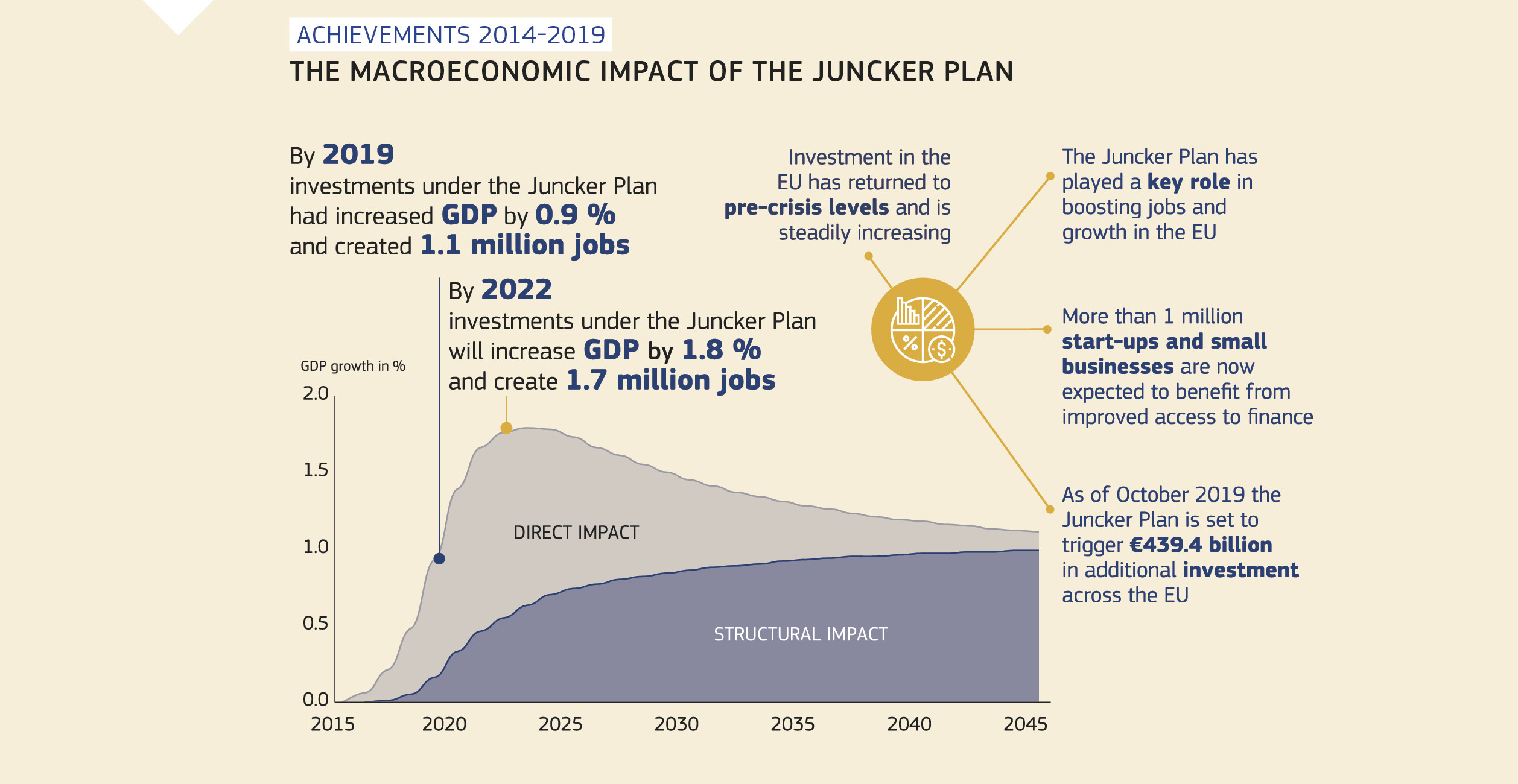
The macroeconomic impact of the Juncker Plan has been one of the significant achievements of the period between 2014 and 2019. By 2019, investments under the Juncker Plan had increased gross domestic product by 0.9 % and created 1.1 million jobs. By 2022, investments under the Juncker Plan will increase gross domestic product by 1.8 % and will create 1.7 million jobs. Investment in the European Union has returned to pre-crisis levels and is steadily increasing. The Juncker Plan has also played a key role in boosting jobs and growth in the European Union, and more than 1 million start-ups and small businesses are now expected to benefit from improved access to finance. As of October 2019, the Juncker Plan is set to trigger 439.4 billion euro in additional investment across the European Union. Source: European Commission
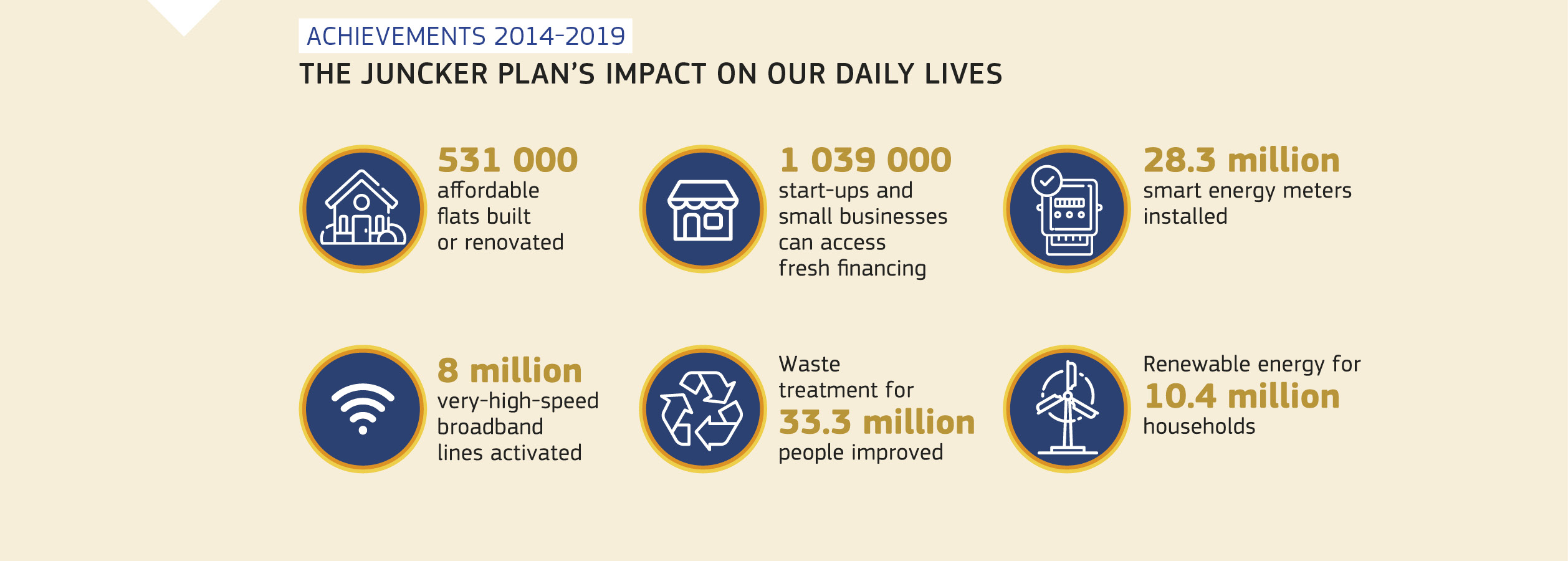
The Juncker Plan has resulted in: 531 000 affordable flats built or renovated; 1 039 000 start-ups and small businesses with access to fresh financing; 28.3 million smart energy meters installed; 8 million very-high-speed broadband lines activated; better waste treatment for 33.3 million people; and renewable energy now available for 10.4 million households. Source: European Commission
Since the start of its mandate, the Juncker Commission (November 2014-November 2019) placed social priorities at the core of its action and at the heart of the debate on the future of Europe. There has been significant progress: with more than 241 million people currently working, around 14 million more compared to 2014, the employment rate has never been higher (73.9 %) and the unemployment rate is its lowest since 2000. Although it is also too high, youth unemployment has fallen significantly, from a peak of 24.1 % in 2013 to 14.3 % in November 2019.

The biggest share of investment funds (30 %) was directed to smaller companies, followed by 26 % to research, development and innovation, 18 % to the energy sector, 11 % to the digital sector, 7 % to transport, 4 % to social infrastructure, and another 4 % to the environment and to resource efficiency. Total investment related to European Fund for Strategic Investments approvals amounted to 439.4 billion euro. Included within that is 81 billion euro of approved European Fund for Strategic Investments financing (made up of 58.8 billion euro approved by the European Investment Bank and 22.2 billion euro approved by the European Investment Fund), of which 62.6 billion euro has already been signed. The total target for 2020 amounts to 500 billion euro. As regards European Fund for Strategic Investments investment relative to gross domestic product, Bulgaria, Estonia, Greece, Spain, Lithuania, Poland and Portugal have had high levels of investment. Ireland, France, Italy, Latvia, Hungary, Finland and Sweden were in the second band, Following with fewer investments are Belgium, Czechia, Denmark, Croatia, the Netherlands, Romania and Slovenia. Finally, the last band is made up of Germany, Cyprus, Luxembourg, Malta, Austria, Slovakia and the United Kingdom. All figures are based on approved operations as of 15 October 2019. Thanks to these investments, 531 000 affordable flats have been built or renovated, waste treatment has improved for 33.3 million people and renewable energy has reached 10.4 million households. Source: European Investment Bank, European Investment Fund, European Commission
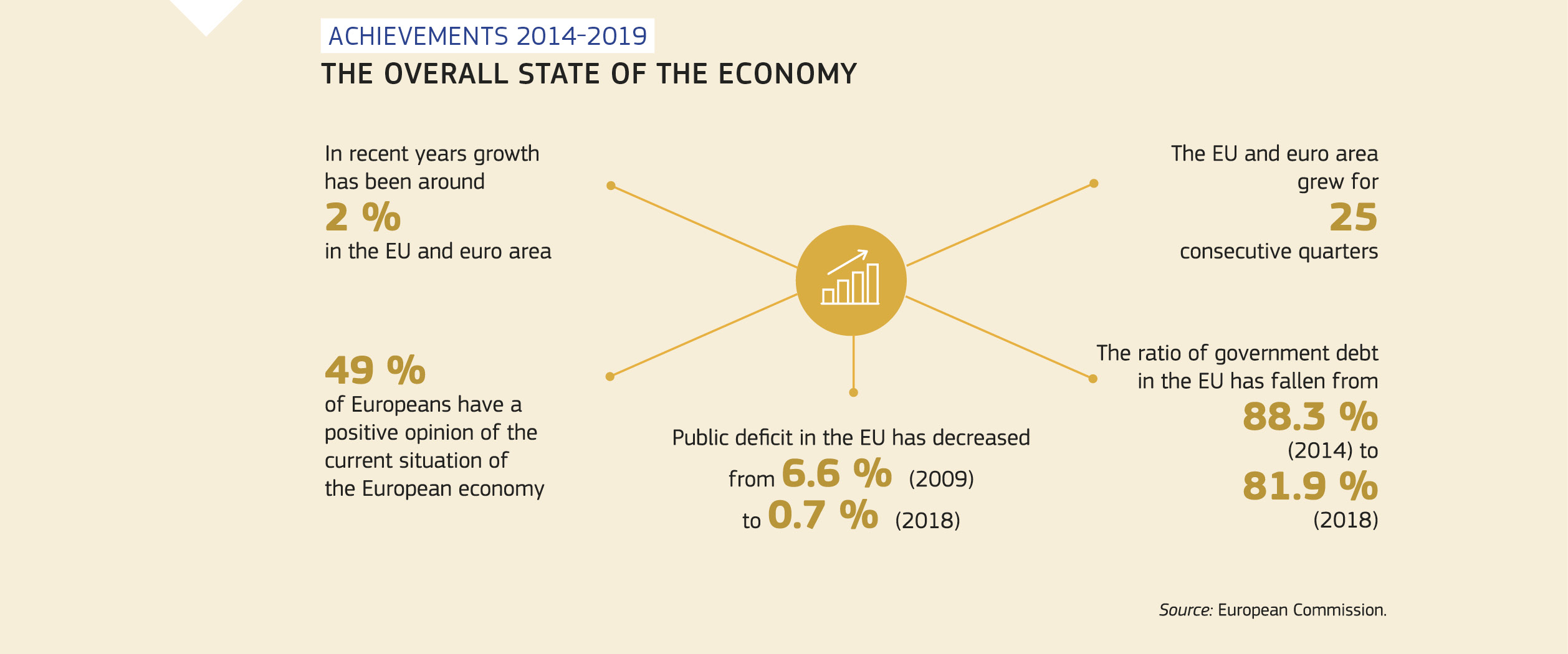
In recent years, growth has been around 2 % in the European Union and the euro area, and they have both now grown for 25 consecutive quarters. 49 % of Europeans have a positive opinion of the current situation of the European economy. Public deficit in the European Union has decreased from 6.6 % in 2009 to 0.7 % in 2018, and the ratio of government debt in the European Union has fallen from 88.3 % in 2014 to 81.9 % in 2018. Source: European Commission
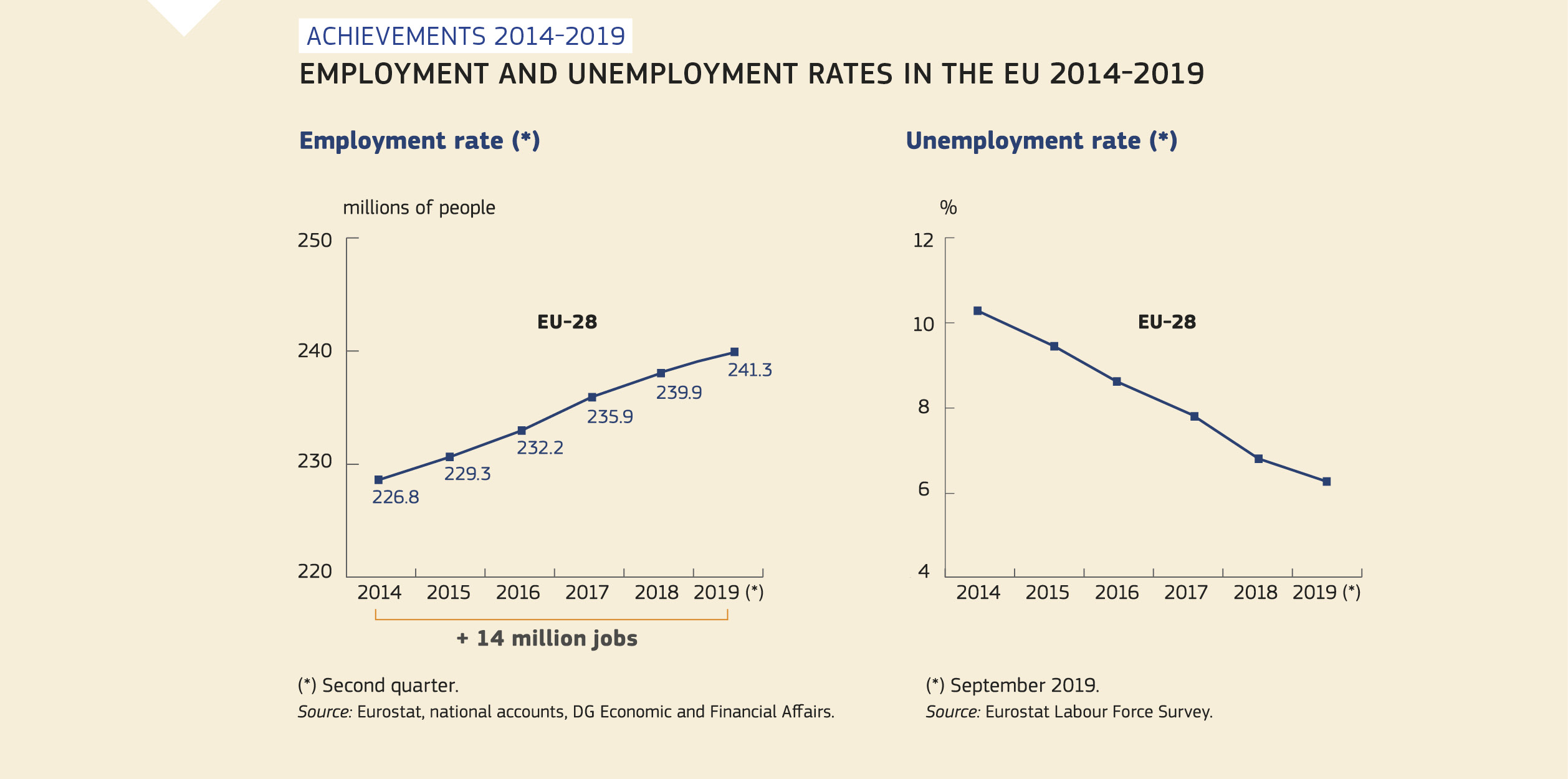
The employment rate since 2014 in the European Union has risen consistently, with 226.8 million people employed in 2014, 229.3 million employed in 2015, 232.2 million employed in 2016, 235.9 million employed in 2017, 239.9 million employed in 2018, and 241.3 million employed by the second quarter of 2019. Since 2014, 14 million jobs have been added to the economy. Source: Eurostat, national accounts, Directorate-General for Economic and Financial Affairs. At the same time, the level of unemployment declined just as steadily from slightly above 10 % in 2014 to slightly above 6 % by September 2019. Source: Eurostat Labour Force Survey.
Economic and fiscal policy
The European Semester
The European Semester is the annual cycle of economic and social policy coordination between the Member States to boost economic growth and job creation. As part of this process, each year the European Commission proposes to the Council a set of recommendations to Member States. For the first time, and following Greece’s exit from its economic adjustment programme in August 2018, the recommendations were addressed to all 28 Member States.
The overall objective of the Commission’s proposals this year was to encourage Member States to increase their growth potential by modernising their economies and strengthening their resilience. Given the current favourable economic conditions and global uncertainties, all Member States were urged to prioritise reforms that promote sustainable growth that works for everyone, together with well-targeted investment strategies and responsible fiscal policies. The recommendations were adopted by the Council in July.
The content of these recommendations reflects the overall priorities set out in the Annual Growth Survey and the recommendation on the economic policy for the euro area. They draw on the detailed analysis of the country reports published in February 2019 and on the assessment of the national programmes presented in April. The Alert Mechanism Report identified 13 Member States for an in-depth review to assess whether they were affected, or at risk of being affected, by imbalances. The reviews found that 10 Member States were experiencing imbalances and three were experiencing excessive imbalances.
The country-specific recommendations include a stronger focus on identifying and prioritising investment needs at national level and on paying special attention to regional and territorial disparities. This is in line with the thorough analysis of investment needs and bottlenecks identified for each Member State in the reports and should serve to prioritise the use of EU funds in the next long-term EU budget (2021-2027).
The recommendations recognise that to meet current and future challenges, our increasingly digitalised and globalised economies require smarter investments in infrastructure, innovation, education and skills, as well as extra measures to provide sustainable and inclusive social welfare systems for our ageing populations.
The Semester also reflected principles enshrined in the European Pillar of Social Rights: equal opportunities and access to the labour market; fair working conditions; and social protection and inclusion. All Member States received a recommendation on skills, and many received recommendations to implement labour market reforms. Further recommendations focused, for example, on the need for policies to empower disadvantaged groups such as low-skilled workers, younger people, older people, persons with disabilities and people with a migrant background. Although social protection systems are improving, there are still some gaps in coverage and obstacles to access.
Public finances
Healthy public finances are an essential basis for economic stability and sustainable growth. Lowering debt and deficits is important to ensure governments have a fiscal buffer to use to cushion the effects of a downturn. While public debt continues to decline in the EU, progress has been uneven and levels remain too high in several Member States.
Macroeconomic stability is a prerequisite for growth, so the EU has rules and procedures to detect debt and deficits and prevent them from threatening growth in the Member States. Imbalances in the euro area continued to attenuate in 2019, and further policy action is needed. In February, the Commission’s analysis showed that 10 Member States were experiencing imbalances, while those in Greece, Italy and Cyprus were deemed excessive.
In its proposals for country-specific recommendations to each Member State, the Commission sets targets to help them reach their medium-term budgetary objectives. Member States that can afford to do so should use fiscal and structural policies to increase quality public investment, particularly in areas that improve economic growth potential such as education and skills, infrastructure and innovation.
In June, the Commission recommended to the Council an end to Spain’s Excessive Deficit Procedure, meaning that the country’s deficit had been brought to below 3 % of its gross domestic product (GDP) in a durable manner. As a result, there were no Member States left in the corrective arm of the EU’s deficit rules, compared to the 24 in 2011.
At the same time, the Commission looked at several Member States’ compliance with the EU’s public debt and deficit rules to assess whether the opening of an Excessive Deficit Procedure was warranted. The Commission concluded that Belgium, France and Cyprus were in compliance but that an Excessive Deficit Procedure was warranted in the case of Italy. However, with the additional fiscal effort announced by the Italian authorities in July, the Commission concluded that it was no longer necessary to propose the opening of such a procedure.
The Commission also addressed a warning to Hungary and Romania for veering too far from their medium-term budgetary targets and recommended that they take action to meet them. Greece, meanwhile, was considered to have made a reasonable start on its post-programme reforms, although the implementation of some seemed to have slowed and there was a risk that certain commitments might not be met.
Tax avoidance reduces national revenues, disrupts fair competition and negatively impacts growth. As the European Semester is about coordinating national policies to ensure convergence and a strong, competitive and social Europe, fighting aggressive tax planning and working towards tax coordination is essential to protect Europe’s citizens and its competitiveness. As a result, the Commission issued country-specific recommendations to several Member States and to the euro area as a whole to address the issue of aggressive tax planning.
The Capital Markets Union
Stable and efficient capital markets are essential for growth, jobs and investment. The Capital Markets Union (CMU), which comprises a mix of regulatory and non-regulatory reforms to better connect savings to investment, is an integral part of the EU’s strategy for promoting these areas.
The CMU aims to strengthen Europe’s financial system by providing alternative sources of financing and more opportunities for retail and institutional investors. This means more funding opportunities for companies, especially SMEs and start-ups such as venture capital and capital markets. A strong CMU is also necessary to complement the Banking Union in order to strengthen the Economic and Monetary Union and the international role of the euro.
There is a strong focus on sustainable finance, as the financial sector begins to help sustainability-conscious investors to choose suitable projects and companies. The CMU helps to channel investment in this direction, thereby contributing to the EU’s energy, climate and environment agenda.
With 11 out of 13 proposals now agreed, the CMU is set to become a true driver of investment, providing additional sources of financing to EU companies and opportunities for citizens to save for their future. Six proposals are to make the most of the Single Market through new European products, labels and passports; five are to simplify the rules for companies and investors and make them more proportionate; and two are to enhance the supervision of capital markets.
In April, the Parliament and the Council agreed on targeted amendments to two key pieces of financial services legislation: the market abuse regulation and the prospectus regulation. The amendments to the rules on market abuse strike a better balance between cutting red tape for small businesses and safeguarding market integrity and investor protection.
The proposed changes to the prospectus regulation will give issuers in SMEs access to growth markets to produce a lighter prospectus when transferring to a regulated market (i.e. a main stock exchange), which can lead to significant cost saving for growing businesses of this nature.
Another milestone towards achieving the CMU was the introduction of the Pan-European Personal Pension Product (PEPP), a voluntary scheme for saving for retirement to be offered by a broad range of financial providers across the EU. It will complement existing public and occupational pension systems alongside existing national private pension schemes. The regulation was adopted on 14 June and will become applicable in 2 years, when the first such products should come on the market.
The PEPP will offer consumers more choice, the benefit of greater competition, enhanced transparency and flexibility in product options. Mobile citizens will be able to continue contributing to the same product regardless of where they reside in the European Union.
As of 31 July, new rules entered into force to foster a cross-border distribution of investment funds. The updated framework makes this distribution simpler, quicker and cheaper and will ultimately increase competition between investment funds. Investors will enjoy more choice and better value, as well as a higher level of protection.
An agreement was also reached on a directive that will help viable companies in financial difficulties to be restructured efficiently and will allow honest entrepreneurs to benefit from a second chance after overcoming bankruptcy.
In March, the European Parliament and the European Council also agreed on new rules that will make it easier to finance small businesses through capital markets. The rules will cut red tape for businesses trying to access ‘SME growth markets’, a new category of trading venue dedicated to small issuers, by introducing a more proportionate approach to support their listing.
Boosting research, innovation and technology
Scientific excellence and breakthrough innovation
In 2019, the EU’s Horizon 2020 programme launched €11 billion worth of funding to support research and innovation.
Given the growing economic importance of breakthrough and disruptive innovation, and based on the early success of the pilot phase of the European Innovation Council, the remaining 2 years of this pilot phase will see significant expansion. Over €2 billion of funding was approved for 2019-2020, covering the whole innovation chain: from ‘pathfinder’ projects to support advanced technologies from the non-conventional research base, to ‘accelerator’ funding to help start-ups and SMEs develop and scale up innovations to the stage where they can attract private investment.

The total budget for Horizon 2020 from 2014 to 2020 is 77 billion euro, of which 11 billion euro worth of calls were launched in 2019. Some examples of European Union funding under this programme include: 206 million euro to transform energy-intensive sectors into competitive, low-carbon and circular industries, lowering their environmental footprint; 132 million euro to promote Europe’s lead in the next generation of batteries, supporting a low-carbon and resilient future; 135 million euro for actions contributing in different ways to the European Union’s plastics strategy; 396 million euro to promote artificial intelligence, which is at the core of today’s most promising breakthroughs; and 116 million euro to develop new capabilities for fighting and preventing cybercrime.

The first photo ever taken of a black hole, published on 10 April 2019 by Event Horizon Telescope, a global team including EU-funded researchers.
The EU in space
To ensure that the EU remains a world leader in space technology and to promote a competitive space industry in Europe, in 2019 the European Parliament and the Council of the European Union reached a partial provisional agreement on the EU’s space programme for 2021-2027.

European Union investment in space totalled 4.6 billion euro from 2007 to 2013, 11.1 billion euro from 2014 to 2020, and is planned to reach 16 billion euro for the period 2021 to 2027. Figures are in current prices. Source: European Commission Copyright: European Union
With a proposed budget of €16 billion, the programme would bring all of the EU’s support for space under the one roof and would increase current funding levels by more than a third. It would build on new needs and available technologies as well as reinforce Europe’s access to space and launch a European approach to supporting an innovative and competitive space industry.
Galileo, Europe’s global radio navigation satellite system, is the most accurate global satnav system available. In September, the number of Galileo users, including users of Galileo-enabled smartphones or tablets, reached an estimated 1 billion worldwide. The Copernicus programme, the world’s biggest provider of Earth observation data, helps to monitor climate change and manage border security and large disasters throughout the world. Every day, Copernicus delivers 12 terabytes of data, which are fully, openly and freely available for use by people and businesses, representing a goldmine for big data and cloud processing. Since 2019, Copernicus has enabled improved transfers of data, particularly of images, and allows users to discover, download and process its data more easily thanks to new upgrades to the Data and Information Access Services.
EU defence and industry
Three out of four EU citizens want to see greater security (Eurobarometer, November 2018). The EU has therefore stepped up its ambition and commitment towards a Defence Union. Activated in December 2017, the Permanent Structured Cooperation brings together 25 participating Member States that are willing to make more binding commitments to work together on security and defence and to take part in the most demanding missions. A total of 34 projects have already been launched, including on military mobility, maritime surveillance and cybersecurity. The Commission participates as an observer at the invitation of participating Member States.
The two pilot programmes of the European Defence Fund, with a combined budget of €590 million, were delivered as planned just as the Preparatory Action on Defence Research (2017-2019) entered its final year. The European Defence Industrial Development Programme (2019-2020) co-funds the cooperative development of defence capabilities; its work programme was agreed in March and calls for proposals were published in April.
Investing in regions, cities and rural areas
Throughout 2019, cohesion policy continued to support jobs and growth with thousands of investments, big and small, across the EU. Over the past 5 years, 1 million businesses have been supported, leading to hundreds of thousands of new jobs. Millions of people have received help for training, education or job seeking, their households have been connected to better broadband and they have benefited from improved transport infrastructure and health-sector innovations.
The European Regional Development Fund has also supported two Member States and 10 EU regions in industrial transition: Lithuania, Slovenia, North and East Finland (Finland), Norra Mellansverige (Sweden), Greater Manchester (United Kingdom), Sachsen (Germany), Wallonie (Belgium), Piemonte (Italy), Cantabria (Spain) and Hauts-de-France, Centre-Val de Loire and Grand Est (France). Each of these 12 pilot schemes will receive a €300 000 EU grant to help achieve industrial transition and design development strategies based on their areas of comparative strength, so-called smart specialisation assets.
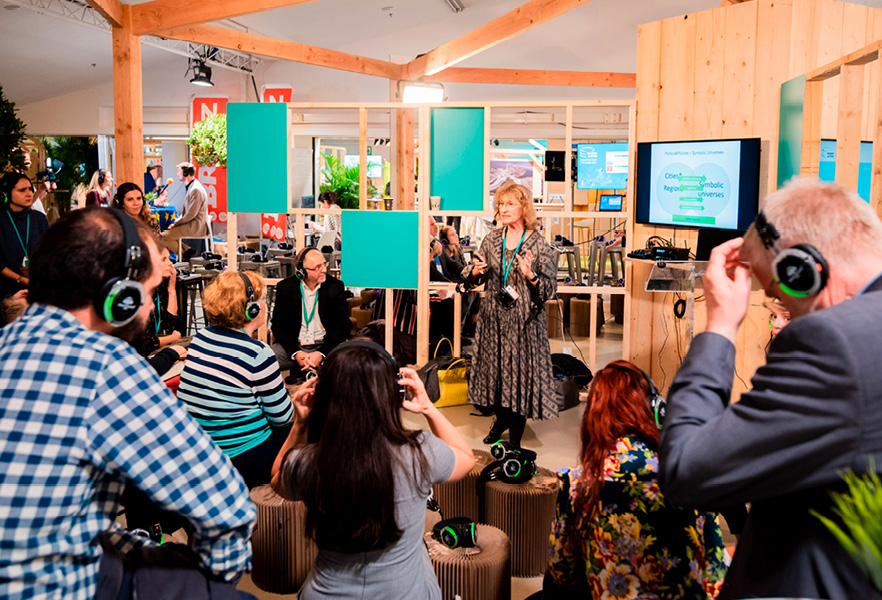
A discussion session during the European Week of Regions and Cities, Brussels, Belgium, 9 October 2019.
Cohesion policy funds are also being invested in innovative start-ups. For instance, thanks to €32.5 million from the European Investment Fund, announced in April, the Venture Capital Fund in Croatia will invest in new projects with high growth potential in the country. More than 100 start-ups should benefit from better access to finance.
On a bigger scale, that same month the Commission announced €4 billion of funding from the European Regional Development Fund and the Cohesion Fund for 25 large infrastructure projects in 10 Member States. The projects cover a wide range of themes, from cross-border gas pipelines between Bulgaria and Greece to water management in Malta, research facilities at a university in Germany and modernised railway lines in northern Portugal. With national co-financing, the total investment in these projects amounts to €8 billion.
Agriculture and rural development
The Common Agricultural Policy continued to contribute to growth and investment by supporting viable food production, sustainable management of natural resources, modernisation of rural infrastructure and social inclusion. By the end of the third quarter of 2019, the European Agricultural Fund for Rural Development (EAFRD) had provided support for Rural Development Programmes 2014-2020 worth €8 billion. The funding went to enhancing farm viability and competitiveness of all types of agriculture and promoting innovative farm technologies and sustainable management of forests.
Rural development policy also aims to protect the environment and mitigate and adapt to climate change. Farmers could receive financial support for joining schemes to develop environmentally friendly farm-management practices, create favourable conditions for biodiversity or recreate wetlands for soil carbon sequestration. Overall, EAFRD support for the restoration, preservation and enhancement of ecosystems related to agriculture and forestry amounted to almost €27 billion. Another €2 billion was spent to promote resource efficiency and the shift towards a low-carbon and climate-resilient economy in the agriculture, food and forestry sectors. The EAFRD also provided almost €5 billion to promote social inclusion, poverty reduction and economic development in rural areas.
To help farmers strengthen their position in an increasingly market-oriented agri-food sector, the Commission has been working towards a fairer and more balanced food-supply chain. New rules on unfair trading practices entered into force in April, aiming to protect farmers and agri-food companies from unfair practices. Member States must transpose the rules into national law by May 2021. An initiative to increase agri-food market transparency was also adopted; this will see more information available along the food-supply chain for all market operators.
The Blue Economy
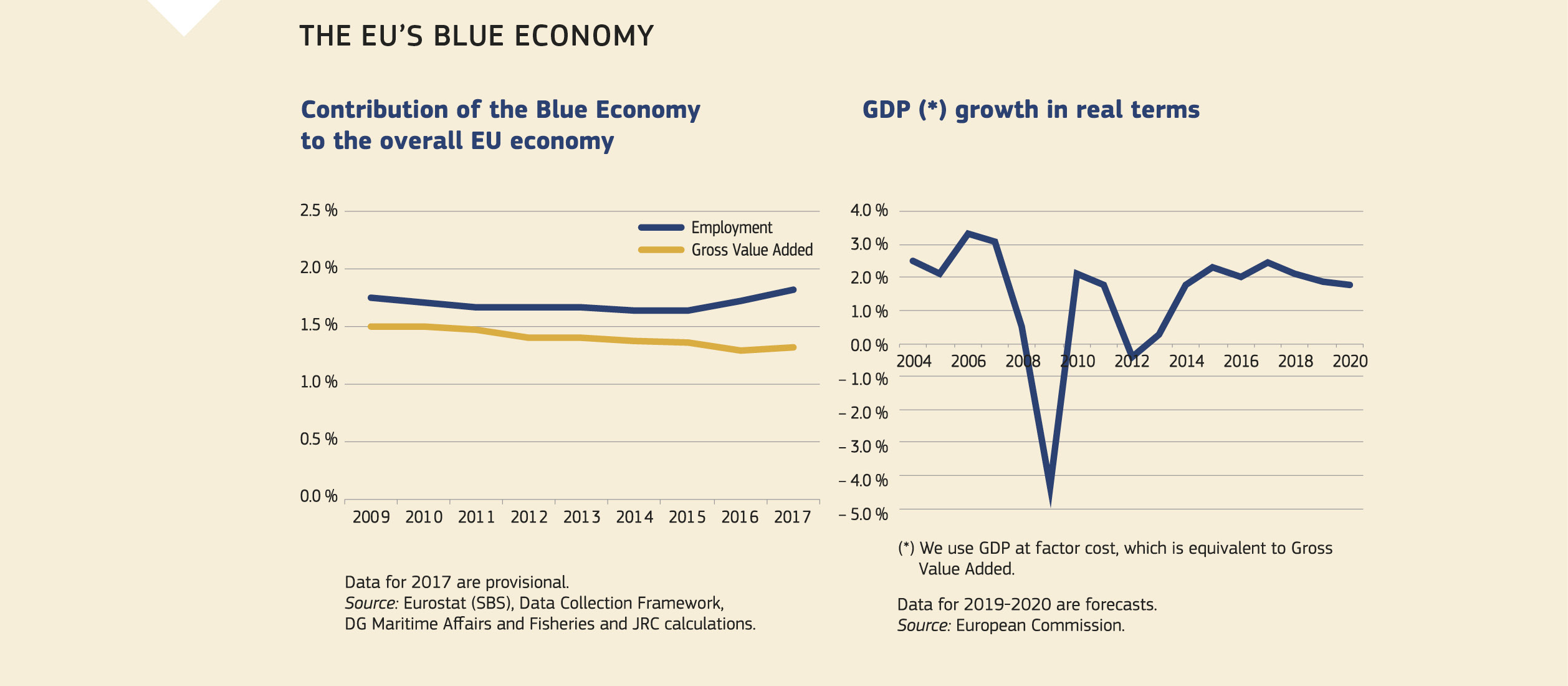
The contribution of the blue economy to the overall European Union economy in terms of Gross Value Added remained relatively stable at around 1.5 % between 2009 and 2017 with a slight downward trend since 2011. In the same period, employment in the blue economy as a contribution to the overall European Union economy remained between 1.5 % and 2 %, with a marked period of growth since 2015. Data for 2017 are provisional. Source: Eurostat (Structural Business Statistics), Data Collection Framework, Directorate-General for Maritime Affairs and Fisheries, and Joint Research Centre calculations. In terms of gross domestic product growth in real terms, where gross domestic product is at factor cost and therefore equivalent to Gross Value Added, growth fluctuated between 2004 and early 2020. After gross domestic product grew to over 3 % between 2004 and 2006, the 2008 financial crisis resulted in a sharp drop, to ‒ 5 % in 2009. An equally rapid rise brought gross domestic product growth of the blue economy back to 2 % in 2010, only to then go down again to just below 0 % in 2012. From 2012 to 2014, growth was stable and led to values around 2 %, where it stabilised until the beginning of 2020, except for slight fluctuations. Data for 2019-2020 are forecasts. Source: European Commission.
The EU’s Blue Economy, which encompasses all sustainable economic activities related to oceans, seas and coastal areas, continues to grow. According to the second EU Blue Economy Report, published in May, the sector produced gross profits of €74.3 billion in 2017 and employed more than 4 million people. The latest figures indicate high growth rates in both the traditional and emerging Blue Economy sectors. The report aims to help stimulate further growth by providing better data, analysis and knowledge about the sea.

A fisherman catches a spiny lobster, Guilvinec, France, 20 August 2019.
The 2019 annual economic report on the EU fishing fleet, published in August, showed that the sector continued to perform strongly in 2017. This was mainly thanks to sustainable fishing methods as well as higher average fish prices, continued low fuel prices and the improved status of some important stocks. The positive trend is expected to continue.
Transport for a connected Europe
In 2019, 108 projects were selected to receive €538 million in grants from the Connecting Europe Facility (CEF) for safer, smarter and greener transport infrastructure. Of those projects, 39 (€117 million) will reduce the noise generated by freight trains, develop cross-border railway links and upgrade crucial infrastructure in ports. Another €109 million will support multimodal logistics platforms, making it possible to shift freight between different modes of transport. Two other priorities concerned Intelligent Transport Systems for roads (€80 million in funding) and innovation and new technologies (€71 million).
In March, the European Commission, together with the European Investment Bank, launched the new CEF Transport Blending Facility, an innovative financial instrument to support projects contributing to the environmental sustainability and efficiency of the transport sector in Europe. With an initial budget of €200 million, the facility will finance investments in the European Rail Traffic Management System and in alternative fuels infrastructure. Both organisations also joined forces to support investments in transport safety: the Safer Transport Platform will provide easy access to technical and financial advice, in particular for roads.
Investing in businesses
SMEs represent 99 % of all businesses in Europe and are a crucial part of the EU economy. The EU supports them by working to improve the business environment, making it easier to access finance, and by offering different services to help them expand within and beyond the EU.
Particularly through the programme for the competitiveness of small and medium-sized enterprises (COSME), in 2018 the EU helped leverage €10 billion in funding for 140 000 such ventures through a range of financial instruments including the European Fund for Strategic Investments (EFSI).
Investing in people
Reforms to education and training are a high priority in most Member States and featured prominently in the 2019 European Semester. Investing in education and skills is essential to sustain innovation and productivity growth, especially in a rapidly changing world of work with rising skills shortages. Inequality in education outcomes represents a threat to social cohesion and the long-term prosperity of Europe. Equal access to quality education is also essential for disadvantaged groups, and since the world of work is changing quickly, more adults need to be encouraged to continuously improve their skills and embrace lifelong learning. All Member States have received a country-specific recommendation in the area of education and training.
In May, as part of the work to build a European Education Area by 2025, the Council adopted a recommendation on early childhood education and care and the teaching and learning of languages. The following month, under the Erasmus+ programme, the Commission announced the first 17 European Universities alliances involving 114 higher-education institutions in 24 Member States. These alliances will enhance the quality and attractiveness of higher education and boost cooperation between institutions and their students and staff.
The EU also continued to invest in training. Support and co-financing for the Erasmus for Young Entrepreneurs (EYE) programme gives newly established and aspiring entrepreneurs the opportunity to train with an experienced person running an SME in another country. Last year, 1 300 new entrepreneurs took part across Europe and beyond, and 120 stand to benefit from EYE Global, a pilot programme involving Israel, Singapore and two US states, New York and Pennsylvania.

The Youth Guarantee is a political commitment taken by Member States in April 2013 to give every person under the age of 25 a good-quality offer of employment, continued education, apprenticeship or traineeship within a period of 4 months of becoming unemployed or leaving formal education. Launched by the Commission, the guarantee has helped put a dent in youth unemployment. Since 2013, 2.5 million fewer young people have been unemployed and 2 million fewer young people were not in employment, education or training. Since 2014, more than 25 million young people registered, and over 18 million young people took up an offer of employment, education, traineeship or apprenticeship. Source: European Commission Copyright: European Union
With a budget of more than €3.2 billion, the Erasmus+ programme for education, training, youth and sport provided opportunities for around 650 000 young people and 237 000 members of staff from educational institutions and youth organisations. The Youth Employment Initiative made €350 million available to young people living in regions with particularly high youth unemployment.
Connecting people
Around 35 000 young people had the opportunity to explore Europe with a DiscoverEU travel pass, and more than 90 000 people registered with the European Solidarity Corps, with 12 000 of them taking part in solidarity activities across Europe in 2019.
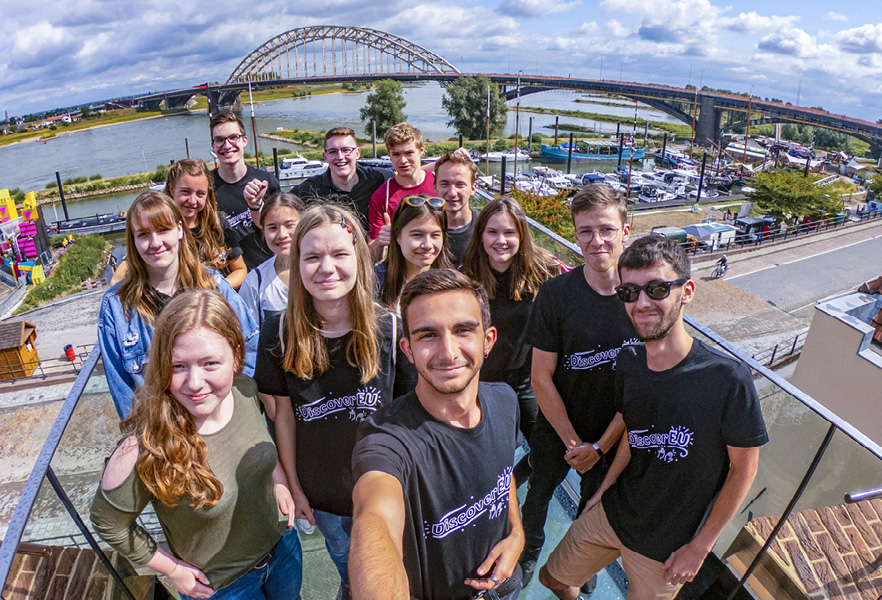
DiscoverEU travellers at the very first DiscoverEU meet-up, Nijmegen, the Netherlands, 12 July 2019.
A healthier Europe
The Commission teamed up with the Organisation for Economic Co-operation and Development and the European Observatory on Health Systems and Policies to work on in-depth studies of health systems in the EU. The State of health in the EU and its Companion report include 30 profiles of national systems and, in 2019, zoomed in on five horizontal themes: vaccination hesitancy; the digital transformation of health promotion and disease prevention; gaps in health system accessibility; task shifting among health workers; and patient access to medicines.
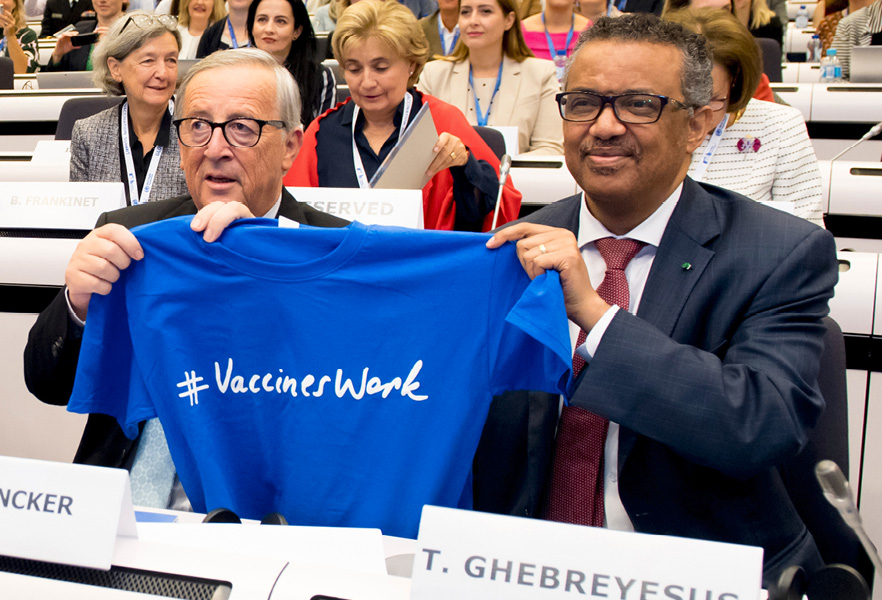
Jean-Claude Juncker, President of the European Commission, holds up a #VaccinesWork shirt with Dr Tedros Adhanom Ghebreyesus, Director-General of the World Health Organization, during the Global Vaccination Summit, Brussels, Belgium, 12 September 2019.
In February, the EU took action to ensure the safety of medicines sold throughout Member States by introducing new verification and safety features on prescription medicines. Since then, manufacturers must put a 2D barcode and an anti-tampering device on boxes of prescription medicines and pharmacies (including online ones) and hospitals must check the authenticity of medicines before dispensing to patients. This is the final step in the implementation of the 2011 falsified medicines directive, which aims to guarantee the safety and quality of medicines sold in the EU.
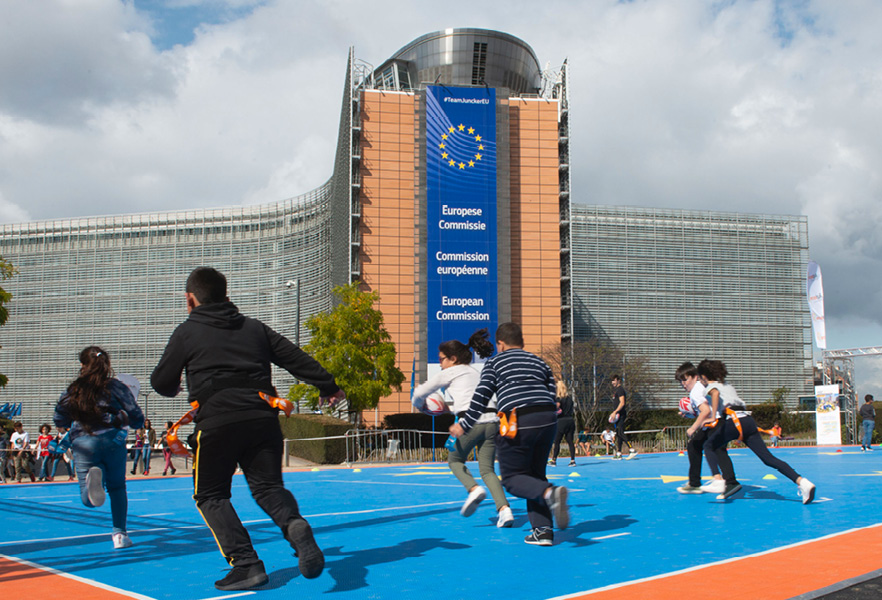
A rugby match for young people organised at the European Commission Berlaymont headquarters as part of the European Week of Sport, Brussels, Belgium, 23 September 2019.
An EU budget focused on delivery and continuity
The EU budget contributed to the strength and resilience of the European economy and to promoting solidarity and security both within and beyond its borders.
Measures to support economic growth and reduce the economic gaps between regions amounted to nearly half of the funds committed (€80 billion). EU funding contributed €12.2 billion to research and innovation under Horizon 2020, including the new European High-Performance Computing Joint Undertaking. The budget increased for education and training (up 17.8 % for Erasmus+ over 2018) and transport and digital infrastructure (37.0 % more for the CEF). Support for agriculture and rural areas remained stable at almost €60 billion, contributing to the fight against climate change and to the promotion of sustainable growth. The 2019 budget provided the necessary flexibility to address the internal aspect of migration issues, with €386.3 million provided to Member States via national operational programmes out of a total of €1.2 billion support from the Asylum, Migration and Integration Fund, along with €442.7 million for border management and €92.7 million for security from the Internal Security Fund. A total of €5 million was allocated to the creation of the new European Public Prosecutor’s Office to prosecute crimes against the EU budget including fraud, money laundering and corruption.
Chapter 2
A connected Digital Single Market

© Fotolia
2019 was another important year in continuing the digital transformation of our economy and society, which is already bringing benefits to consumers and businesses across the EU and beyond. This has been possible thanks to a concerted EU approach.
In May, the cost of calls and texts between Member States became cheaper with the implementation of new rules setting a maximum price for calling or messaging from fixed lines or mobiles. The number of free WiFi hotspots across Europe increased thanks to an EU-funded scheme that offers towns and cities money to cover installation costs.
Other developments laid the groundwork for Europe’s digital future. Products and services using artificial intelligence (AI) are becoming increasingly widespread, and new EU guidelines will help reassure citizens that the technology will assist, rather than replace, humans.
Europe’s ambition to become a world leader in supercomputing received a major boost with the unveiling of eight new supercomputer hosting sites. Concerns about the security of key communication networks and the data they carry were addressed. This included new proposals on strengthening the cybersecurity of 5G networks, a much bigger role for the European Union Agency for Cybersecurity, and the EU-wide rules for the cybersecurity certification of products, processes and services, as well as a commitment to develop new ultra-secure quantum security networks.
New rules on copyright mean that the online work of journalists and creators will be more fairly rewarded and protected.
Safer, cheaper and better connectivity
Connectivity was again a major issue for the EU in 2019. As our economy and society become increasingly digital and more of our time is spent using products and services online, safe, reliable and affordable connectivity is more important than ever.
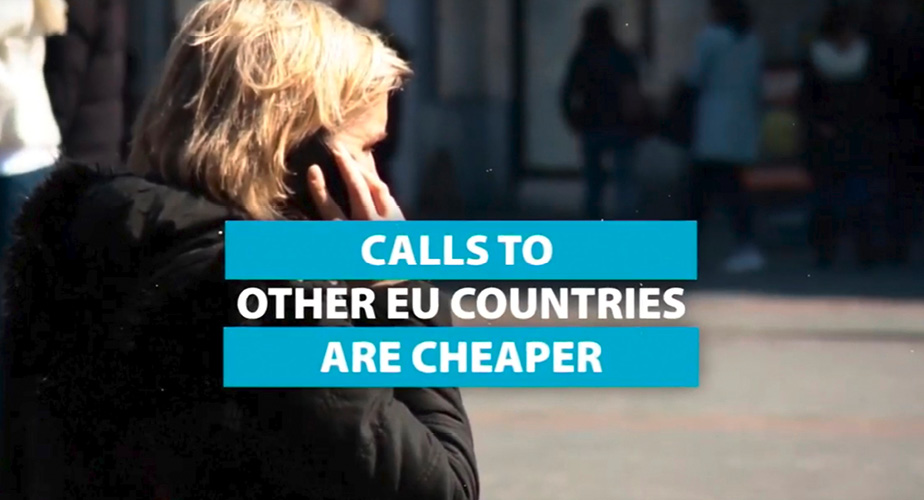
Digital Single Market: cheaper calls to other EU countries. © European Union, 2019
The cost of calling and messaging between Member States and other parts of Europe has varied significantly. On average, the standard price of a fixed or mobile call to a number in another country was three times higher than the standard price of a domestic call, and the standard price of a text message was more than twice as expensive. Price caps introduced in May set the maximum cost of calls from fixed or mobile phones at no more than €0.19 + value added tax (VAT) per minute, while text messages now cost no more than €0.06 + VAT. After the abolition of mobile roaming charges in 2017, the cap on international calls in Europe brings a clear and immediate benefit to consumers and businesses.
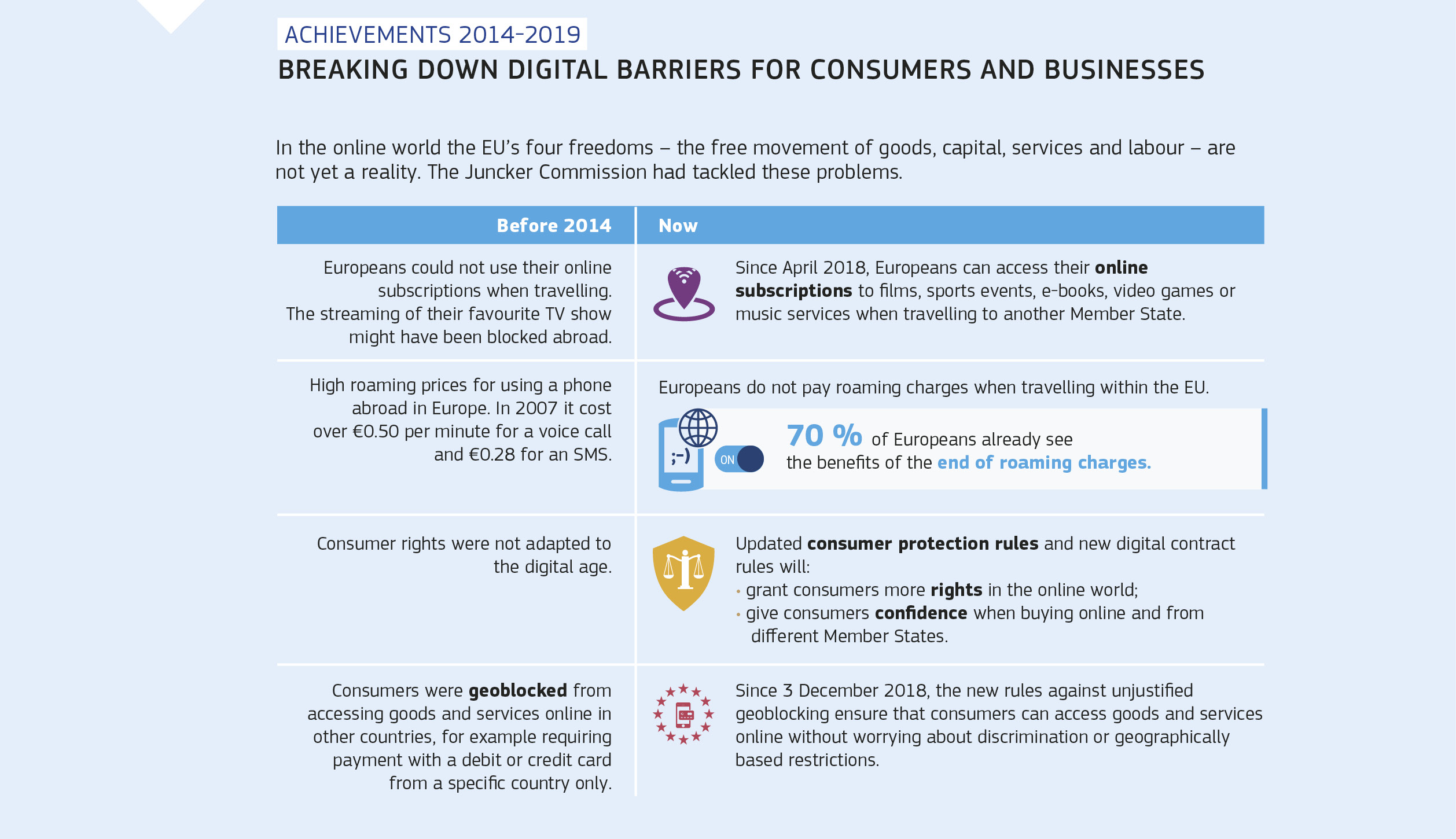
Breaking down digital barriers is crucial for consumers and businesses. In the online world, the EU’s four freedoms – the free movement of goods, capital, services and labour – are not yet a reality. For this reason, the Juncker Commission has been tackling these problems. Before 2014, Europeans could not use their online subscriptions while they travelled, and streaming of their favourite TV shows might also have been blocked abroad. They also faced high roaming prices for using a phone abroad in Europe; over 0.50 euro per minute for a voice call and 0.28 euro for a text message in 2007. Consumer rights were not adapted to the digital age, and consumers were geoblocked from accessing goods and services online in other countries, for example requiring payment with a debit or credit card from a specific country only. Since April 2018, Europeans can access their online subscriptions to films, sports events, e-books, video games or music services while travelling to another Member State. They do not pay roaming charges when travelling within the European Union, a policy that, according to 70 % of Europeans, is already showing its benefits. Moreover, updated consumer protection rules and new digital contract rules will grant consumers more rights in the online world and will give consumers confidence when buying online and from different Member States. Since 3 December 2018, the new rules against unjustified geoblocking ensure that consumers can access goods and services online without worrying about discrimination or geographically based restrictions. Source: European Commission

WiFi4EU-funded networks must be free of charge, free of advertising and free from commercial reuse of data. In addition, the designated public spaces must display the WiFi4EU visual identity as well as show that they are co-funded by the European Union. Source: European Commission
Other tangible benefits came when a scheme was launched to help local authorities install free WiFi hotspots. The WiFi4EU initiative aims to help up to 8 000 communities across the EU to improve their connectivity. EU grants of €15 000 are available for local authorities to finance the installation of hotspots. Two calls for applications took place, with more than 5 000 communities benefiting from the scheme in addition to the 2 800 that already received help in 2018. Each community has 18 months to invest the funding in the necessary equipment to create their public WiFi hotspots.
Connectivity in rural areas was also given a boost during the year. Only 53 % of people living in remote and rural areas have fast internet access compared to 82 % in the EU as a whole. Closing this digital gap is a key priority. The Broadband Competence Offices Network grew significantly in 2019, with 116 national and regional offices now helping to coordinate efforts to expand broadband coverage to the furthest corners of the EU. Better and faster broadband coverage will improve access to education, health, government services and businesses, will facilitate jobs and investment and will support communities in these areas.
The expansion of the network came as Member States pledged in April to work together to unlock the potential of digital technologies so that important and urgent economic, social, climate and environmental challenges facing the wider rural economy, including the EU’s food and farming sector, could be tackled.
In the run-up to the European Parliament elections in May, a campaign to raise awareness about online violence against women, #DigitalRespect4Her, featured testimonies from female parliamentarians, experts and journalists highlighting the particular issues that women face on social media and elsewhere online.
Digitalisation is also helping to underpin the wider work of breaking down barriers within the EU Single Market, of which the launch of the Electronic Exchange of Social Security Information was a tangible example. The project helps social security institutions across the EU, Iceland, Liechtenstein, Norway and Switzerland exchange information on cases involving citizens moving, living and working between countries. It began live operations in January 2019 and 31 countries are now rolling out the system. They had already exchanged information on more than 175 000 cases by the end of the year. The system is designed to help citizens access their information more effectively and have their social security benefits calculated more quickly and more accurately, as well as to help social security administrations fight more effectively against fraud.
In a similar vein, the collection of VAT from online sellers will also improve thanks to new rules agreed in March that will allow online businesses to register just once for VAT purposes rather than in each Member State where they sell. This will significantly reduce the cost in time and money for smaller companies operating online across borders. The new rules will also help national tax authorities more easily collect the VAT due from non-EU companies selling goods to EU consumers from the online marketplaces they use, assisting in the recovery of the €5 billion in tax revenues lost in the sector each year.
Protecting rights in the digital age
Other initiatives designed to protect the rights of consumers and businesses online were introduced, including new rules on contracts for the supply of digital content and digital services and on contracts for the sale of goods, which help make it clearer and simpler to do business online. One single set of rules across the EU will help businesses understand their obligations, while consumers will benefit from clear remedies when digital content, services and goods, including products with a digital element (e.g. smart fridges), are faulty.
New EU rules were also agreed to bring the complex regulations on copyright up to date for the digital world. Music-streaming services, video-on-demand platforms, news aggregators and user-uploaded-content platforms have become the main gateways to access creative works and press articles. The new rules guarantee fairer remuneration for creators, stronger rights for users and clearer responsibility for platforms. The aim is to improve access to online copyrighted material across borders, to set new rights and responsibilities for online platforms hosting copyrighted works, to encourage online press and journalism and improve remuneration for journalists, and to make it easier to use copyrighted material for education and research purposes.
Europe continued to act decisively in tackling unfair business practices in the digital economy. In March, Google was fined €1.49 billion for imposing anti-competitive contractual restrictions on third-party websites, which prevented or deterred rivals from being able to place their search adverts on them. In June, a formal investigation was launched into the practices of Broadcom, a global leader in components for wired communication devices such as modems and TV set-top boxes, to assess whether it illegally excluded competitors. In October, the Commission imposed interim measures on Broadcom with a view to ensuring that serious and irreparable damage to competition does not occur pending its investigation on the merits of certain allegedly exclusionary practices by the company. Qualcomm was fined €242 million in July for selling the chipsets that connect smartphones and tablets to cellular networks below cost with the intention of eliminating its main rival in the market segment. An investigation was also opened into how Amazon uses data from other merchants that sell goods on its websites.
From July, new rules started to apply on online platform-to-business relationships, putting in place a harmonised framework for minimum transparency and redress rights. These rules protect companies that depend on online platforms for reaching consumers while safeguarding the innovation potential of platforms; they are accompanied by the Observatory on the Online Platform Economy.
Making networks more secure
There were also new rules from the EU on the cybersecurity of networks as a whole. This includes recommendations on the security of next-generation 5G networks, where the high performance capacity is expected to lead to a further expansion in the number and range of digital products and services and to estimated revenues of €225 billion in 2025. Between March and June, Member States carried out extensive risk assessments of their 5G network infrastructure and toughened up their rules to improve the security of public networks.
The Cybersecurity Act came into force in June, setting out the future direction of EU cybersecurity policy. This includes starting work on the development of a new cybersecurity certification framework for digital products, services and processes, and a stronger role for the European Union Agency for Cybersecurity. As well as playing a key role in setting up and maintaining the certification framework, the agency is mandated to increase operational cooperation at EU level, which involves helping Member States that request it to handle cybersecurity incidents and supporting the coordination of the EU in case of large-scale cross-border cyberattacks and crises.
The same month saw seven Member States (Belgium, Germany, Spain, Italy, Luxembourg, Malta and the Netherlands) pledge to accelerate the development of ultra-secure quantum networks to boost European capabilities in quantum technologies and cybersecurity and to guarantee the safety and security of the networks of the future. Their ambitious proposals call for a new quantum communication infrastructure that would enable information and data to be transmitted and stored ultra-securely and that would link communication assets all over the EU. It would integrate quantum technologies and systems into conventional communication infrastructures and would consist of two elements: an earth-based component, making use of existing fibre communication networks linking strategic sites at national and cross-border levels, and a space-based component to cover long distances across Europe and other continents.
Using this network for critical infrastructure and encryption systems will help protect smart energy grids, air traffic control, banks, healthcare facilities and more from hacking. It will also enable data centres to store and exchange information safely and will preserve the long-term privacy of government data.
In May, the Council established a framework that allows the EU to impose targeted restrictive measures to deter and respond to cyberattacks that constitute an external threat to the EU or its Member States. This includes cyberattacks against non-EU countries or international organisations where restrictive measures are considered necessary to achieve the objectives of the Common Foreign and Security Policy.
Preparing for the technologies of the future
Artificial intelligence
Also looking to the future, Europe wants to benefit fully from the many potential improvements AI could bring and in recent years has strongly invested in boosting its AI capacity. However, against a backdrop of concerns about the development of AI, in 2019 a high-level group of experts started to develop guidelines for the ethical development of the technology to make sure it continues to serve, and not harm, society. The ethics guidelines for trustworthy AI were drawn up by experts from across the EU and are expected to form part of future proposals on human-centric AI planned for the early part of 2020. They cover issues as diverse as how to avoid discrimination in the development of AI systems and how to make sure they are sustainable and environmentally friendly.
Supercomputing
The quantities of data needed to support the development of AI require considerable amounts of computing power, and Europe has traditionally lagged behind the rest of the world in this regard. In June, eight sites across the continent were chosen to host new European supercomputers, helped by €840 million in EU and Member State funding. The sites in Sofia (Bulgaria), Ostrava (Czechia), Barcelona (Spain), Bologna (Italy), Bissen (Luxembourg), Minho (Portugal), Maribor (Slovenia) and Kajaani (Finland) will eventually host new supercomputers that could boost Europe’s supercomputing capacity four- to fivefold, with the aim of making it a global leader in this field. The supercomputers could be used to help develop personalised medicines, improve drug and material design and develop new bioengineering techniques, as well as for weather forecasting and climate change modelling.
Looking ahead: completing the Digital Single Market
A completed Digital Single Market would help the EU maintain its position as a world leader in the digital economy. Since the launch of the strategy in 2015, 30 different legal proposals have been put forward and, by the end of 2019, 28 of these had been agreed, five more than at the end of the previous year. The two remaining proposals, the first covering online privacy and the second covering the European Cybersecurity Industrial, Technology and Research Competence Centre and the Network of National Coordination Centres, are expected to be agreed in 2020. The European Commission has also prioritised a number of digital issues, including building on the ethical guidelines to put forward legislation for a coordinated European approach on the human and ethical implications of AI, and passing a new Digital Services Act to update liability and safety rules for digital platforms, services and products.
Chapter 3
A resilient Energy Union with a forward-looking climate change policy
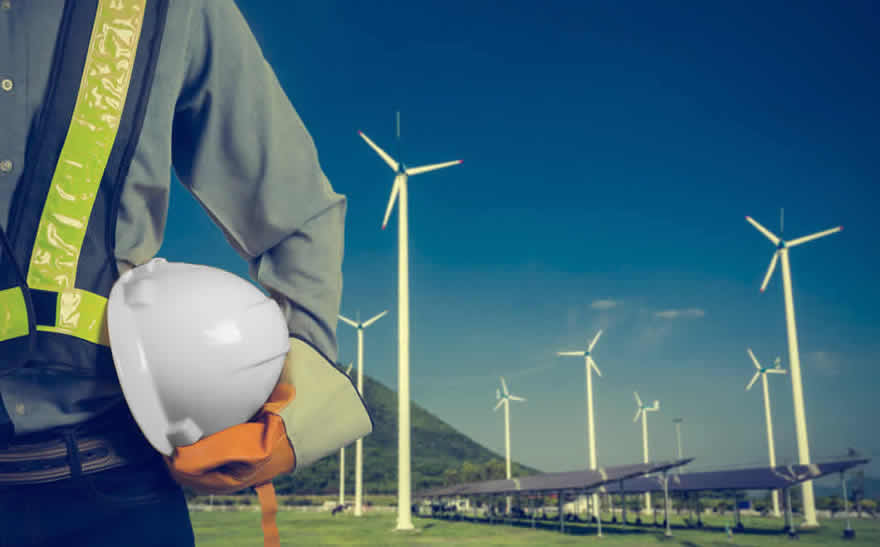
© Fotolia
The climate crisis remained at the top of the political agenda in 2019 amid growing calls for more ambitious global action as the impacts of climate change continued to be felt across Europe and the world.
The EU has proven to be a climate leader on the world stage by putting in place legislation to deliver and go beyond its commitments to the Paris Agreement and adopting a long-term strategy to make Europe the world’s first climate-neutral continent by 2050. In December, this ambition took a massive leap forward with the unveiling of the European Green Deal, the flagship policy of the von der Leyen Commission. The deal will help us to produce, move, consume and live in a more environmentally responsible way while leaving no individual or region behind.
The completion of the Energy Union solidified Europe’s position as a global leader in energy efficiency and renewable-energy technologies and will underpin the clean-energy transition in all sectors of the economy. Member States submitted the first draft of their energy and climate plans for assessment to the Commission under new governance rules.
The EU is accelerating its transition towards a circular economy, with all 54 actions under the Circular Economy Action Plan now delivered. New EU rules to ban certain single-use plastics entered into force in July and should now be transposed into national legislation by Member States.
The EU continued its efforts to strengthen finance to bring innovative low-carbon technologies to market, and good progress was made in decarbonising the transport sector with the adoption of important measures to reduce CO2 emissions from road vehicles and shipping.
A climate-neutral Europe by 2050
Climate change and environmental degradation present an existential threat to Europe and the world. To overcome this challenge, Europe needs a new growth model that transforms the European Union into a modern, resource-efficient and competitive economy where there are no net emissions of greenhouse gases by 2050, where economic growth is decoupled from resource use and where no one and no region is left behind.
In 2018, the Commission presented its vision for a climate-neutral EU by 2050 based on seven building blocks: increased energy efficiency; increased use of renewables; a clean and connected mobility system; a competitive circular economy industry; connected high-standard infrastructures; a boost in the bio-economy and natural carbon sinks; and the use of carbon capture and storage. Following an extensive stakeholder debate, and in the light of the Green Deal Communication presented by President von der Leyen, this objective was endorsed by the European Council in December 2019.
The EU already has a strong track record in reducing greenhouse gas emissions while maintaining economic growth: in 2018, emissions were 23 % lower than in 1990, while the economy grew by 61 % over the same period. However, more needs to be done. Given its extensive experience, the EU is leading the way in creating a green and inclusive economy with the European Green Deal, the flagship policy of the von der Leyen Commission, presented in December. At the heart of the Green Deal is a commitment to make Europe the first climate-neutral continent by 2050.
The deal makes a quantum leap forward in making it a reality on the ground. It resets the Commission’s commitment to tackling climate- and environment-related challenges and sets the path for action in the months and years ahead. For more information, see the section ‘The EU in 2019: a year of change’.
To underline the EU’s commitment, the first European climate law will enshrine the 2050 neutrality objective in legislation. Most importantly, the Green Deal sets a path for a transition that is just and socially fair. It is designed in such a way as to leave no individual or region behind in the great transformation ahead.
The European Union is the first major economy to turn its Paris Agreement commitments into binding laws and has already exceeded its target to reduce emissions by 20 % by 2020. If all measures agreed are fully implemented, it would surpass its target to reduce them by 40 % by 2030. However, even more ambitious targets are needed, and the Green Deal will raise this target to at least 50 % (and towards 55 %) compared with 1990 levels.
The EU has already started to modernise and transform the economy. In 2019, climate action continued on all fronts: from making our vehicles and air cleaner and investing in technological solutions to taking action to protect our forests and empowering people to play their individual part.
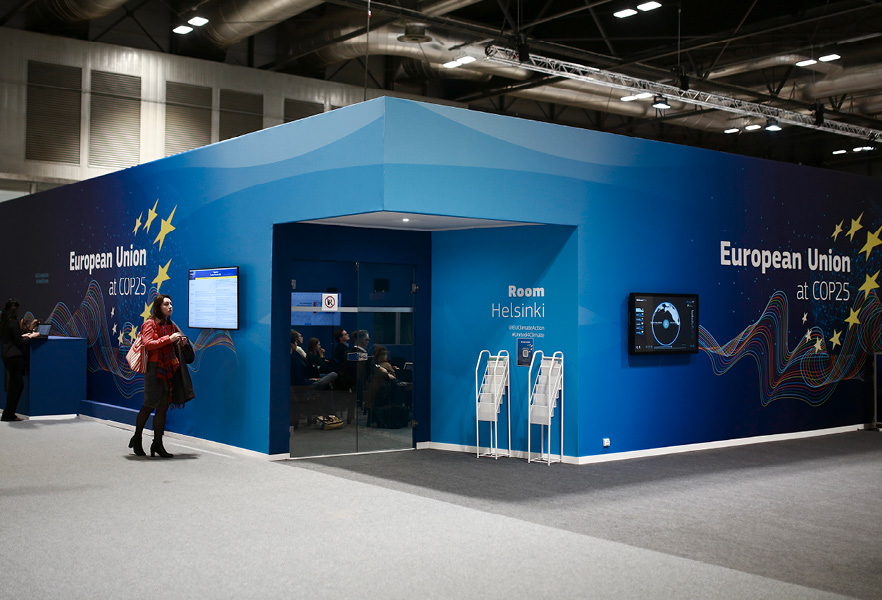
The EU pavilion at the UN Climate Change Conference COP25, Madrid, Spain, 3 December 2019.
In line with new rules on the governance of the Energy Union, for the first time Member States developed draft integrated national energy and climate plans. A Commission assessment of the draft plans, published in June, showed that greater ambition was needed in the final plans that Member States were to submit by the end of the year in order to achieve the EU’s climate goals.
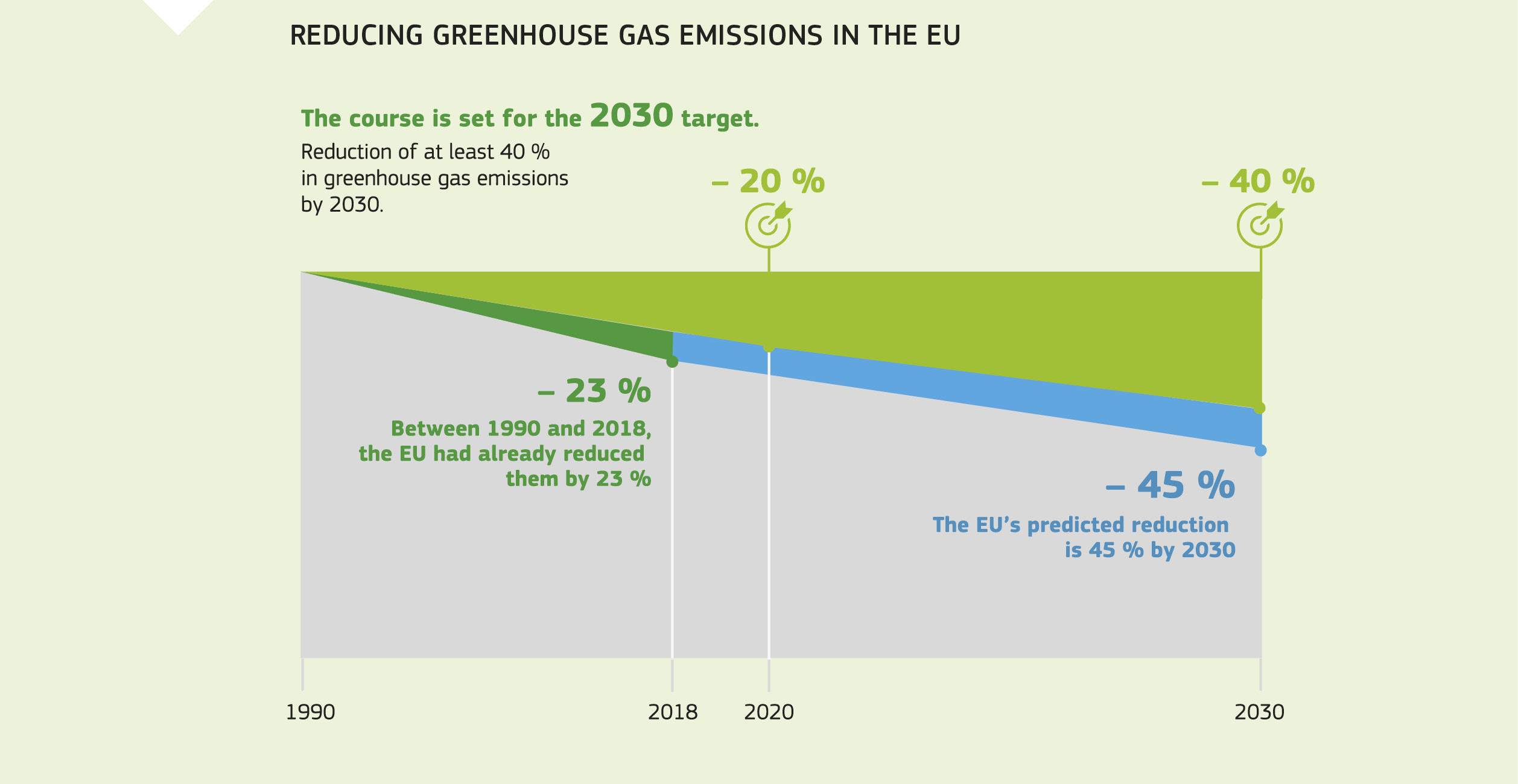
The course is set for the 2030 target of reducing greenhouse gas emissions by at least 40 %. Between 1990 and 2018, the European Union already reduced greenhouse gas emissions by 23 %, exceeding the 20 % target set for 2020. Further estimates predict an overall reduction of 45 % by 2030, 5 percentage points more than the original target for that year (40 %). Source: Council of the European Union
Working internationally to fight climate change
With EU emissions making up only around 9 % of the global total, it is clear that Europe cannot tackle climate change alone and that all countries have to work together to find a solution. The UN Climate Action Summit held in New York in September provided the EU with an opportunity to discuss with its partners how to be more ambitious and accelerate action to implement the Paris Agreement. The Commission prepared for the UN Summit by adopting a Communication that reaffirmed the EU’s commitment to accelerated climate ambition.
In December, EU negotiators attended the UN Climate Change Conference COP25 in Madrid. Successful agreements on the second review of the Warsaw International Mechanism and the creation of a Gender Action Plan provided some encouraging news.
Despite the efforts of the EU delegation to achieve consensus on the issue of international carbon markets, COP25 has not delivered the ambitious outcome that the world needs and that many wished for. But that reinforces the need for Europe to take leadership with the Green Deal and to engage with international partners. 2020 will see increased global climate ambitions: by COP26 in Glasgow in November, parties need to update their Nationally Determined Contributions and submit long-term strategies in line with the Paris Agreement objectives. The EU is ready for this.
The global phase-down of hydrofluorocarbons, harmful climate-warming gases commonly used in heating and cooling equipment, began on 1 January 2019. The action, spearheaded by the EU, is expected to make a significant contribution to the Paris Agreement objective of keeping global temperature rise well below 2 °C.
Throughout the year, the EU continued its international outreach and cooperation on climate issues. In June, the Commission, Canada and China co-hosted a major international climate meeting in Brussels; the third Ministerial on Climate Action brought together high-level representatives from over 30 countries, including ministers from the G20.
The EU remains strongly committed to supporting climate action in developing countries. Along with its Member States, it remains the largest provider of public climate finance, contributing €21.7 billion to developing countries in 2018, up from €20.4 billion in 2017.

EU staff work with local communities to clean up marine litter as part of the global #EUBeachCleanUp campaign, Koh Sak, Thailand, 13 September 2019.
Completing a modern and ambitious Energy Union
Launched in 2015, the Energy Union strategy set out to give European households and businesses secure, sustainable, competitive and affordable energy. The Fourth report on the state of the Energy Union showed that the Commission has fully delivered on its vision for the strategy. Among the main achievements was the completion in May of the ‘Clean Energy for All Europeans’ legislative package, made up of eight pieces of legislation. This will radically transform Europe’s energy system, making it climate-friendly and putting it at the service of consumers and Europe’s economy and competitiveness.
The package includes new and ambitious targets for 2030: an increase of at least 32.5 % in energy efficiency and a share of at least 32 % from renewables in energy use. It comprehensively reforms electricity markets to help integrate renewables into the grid and ensures everyone can participate in the energy transition by empowering consumers and communities to generate their own electricity. Crucially, the new rules will end subsidies to the most polluting plants.

The European Union has set a new energy-efficiency target of at least 32.5 % by 2030. In addition, clearer and simpler energy-efficiency labelling rules help households save almost 150 euro per year, and 18 billion euro from the European Structural and Investment Funds has been allocated to energy efficiency between 2014 and 2020. 900 000 people are currently employed in the energy-efficiency sector in Europe. Source: European Commission
The EU also adopted a new set of clearer and simpler energy labels that will help consumers save energy (the equivalent to Denmark’s annual energy consumption) and money (on average €150 per year per household) by 2030. In addition, in October, the Commission adopted new measures to make household appliances such as refrigerators, washing machines, dishwashers and televisions more sustainable. For the first time this includes requirements for repairability and recyclability, contributing to a circular economy.
In November, the Commission presented the first results of an initiative launched in 2018 to help 10 EU regions and two Member States in industrial transition build resilient and low-carbon economies. This saw the launch of 12 pilot schemes to overcome specific obstacles, with each scheme receiving an EU grant worth €300 000. The Commission also continued its efforts to support coal regions in transition to foster a ‘just transition’ where no region is left behind.
In February, 26 European islands launched their clean-energy transition. They will publish their agendas by mid 2020.
Energy security and solidarity
The security of energy supply for EU consumers is an essential element of the Energy Union. As part of this effort, an agreement was reached to ensure that all gas pipelines to and from non-EU countries comply with EU energy legislation.
To strengthen the security of supply in the Baltic states, the Commission and Estonia, Latvia, Lithuania and Poland signed a political roadmap setting electricity markets on their way to being synchronised with the continental European network via Poland. The EU awarded a grant worth €323 million in support of the project.
The EU continued investing in safe and sustainable energy infrastructure through the Connecting Europe Facility, including €800 million for priority energy infrastructure and €750 million for projects with major cross-border benefits. Another €214.9 million was granted to the Baltic Pipe gas infrastructure project connecting Poland and Denmark with Norway.

Over 30 projects of common interest have been implemented in the field of energy security and 75 others will be implemented by 2022. The Connecting Europe Facility has received 3.4 billion euro in energy funding since 2014 and an additional 1.3 billion euro from the European Fund for Strategic Investments has been allocated to energy security. In total, European Union public funding in energy infrastructure has leveraged total investments of around 50 billion euro.
Tackling cybersecurity issues in the energy sector has become a top priority, as all Europeans depend on the availability of energy. To address potential threats, the EU adopted a recommendation that provides guidance on how to address specific cybersecurity challenges.
The EU continued working on safe, secure and innovative applications of nuclear science and technology for purposes other than generating nuclear energy. Cooperation with non-EU countries to ensure the highest level of nuclear safety continued throughout 2019.
Decarbonising the economy
The EU Emissions Trading System continued to show positive results, with emissions from installations falling by 4.1 % in 2018 compared to 2017.
To address the current surplus of allowances in the system, a market stability reserve began operating in January. This will improve the system’s resilience to major shocks by adjusting the supply of allowances to be auctioned. The EU increased the incentive for businesses to reduce their emissions by placing almost 400 million allowances from the system in the reserve between September 2019 and August 2020, thereby increasing the price of emissions and making clean technologies more cost effective. Higher prices in the European carbon market in 2018 led to a record amount of revenue for Member States, generating some €14 billion – more than double the amount in 2017.
In December, the EU and Switzerland completed the process enabling them to link their emissions trading systems. From 2020, allowances from both systems can be used for compliance to compensate for emissions occurring in either system. This Linking Agreement is the first of its kind and demonstrates that such systems can pave the way to broader international carbon markets. Earlier in the year, the removal of regulatory barriers had enabled Iceland, Liechtenstein and Norway to fully participate in the EU auctioning platform for trading emissions allowances.
To accelerate international progress on building a robust international framework for carbon markets, the Commission hosted several conferences to identify potential solutions to obstacles when setting up reliable international emissions trading systems.
Clean and sustainable transport
A faster shift to clean and sustainable transport is essential to improve Europeans’ health and quality of life, contribute to the EU’s climate objectives and boost the industry’s competitiveness. In March, the Commission presented a roadmap of actions to ensure a faster transition to clean vehicles. Among the major achievements in 2019 under the EU’s agenda for clean, safe and connected mobility was the adoption of the first EU-wide CO2 emissions targets for trucks, new CO2 emission standards for cars and vans, and new rules to encourage public authorities to use environmentally friendly transport.
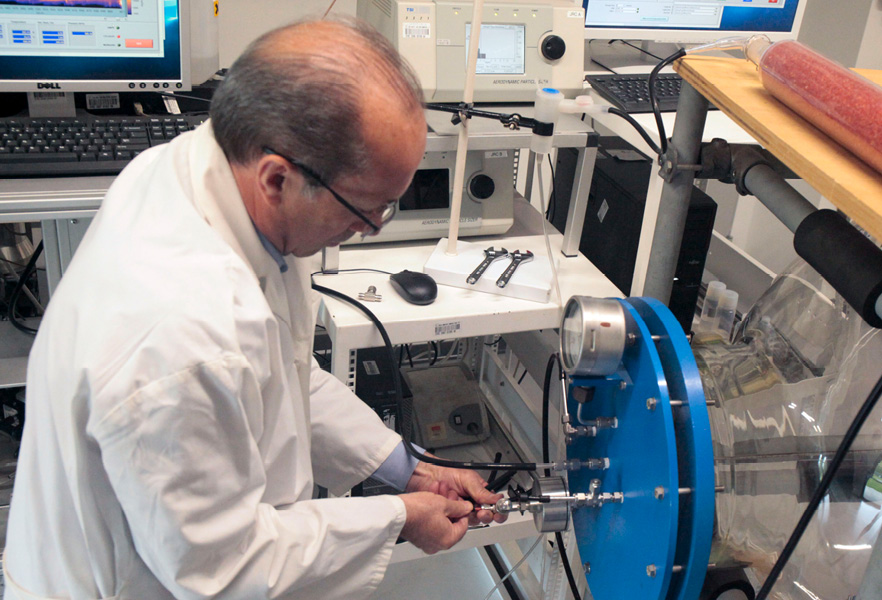
A scientist from the Joint Research Centre monitors air pollutants, as required by EU legislation, European Commission Atmospheric Observatory, Ispra, Italy, 1 May 2019.
Following the Dieselgate scandal, the EU has significantly tightened rules to ensure more independent and reliable testing procedures for vehicles. In January, the Worldwide Harmonised Light Vehicles Test Procedure and new Real Driving Emissions rules entered into force. In September, the NOx (nitrogen oxides) measurements carried out using the Real Driving Emissions rules became mandatory for all new cars sold in Europe.
Progress was also made in tackling emissions from maritime transport with the adoption of a proposal to revise the EU system for monitoring, reporting and verifying CO2 emissions from ships, as well as the first-ever publication of these data. This represents an important step towards ensuring that international shipping contributes its fair share of global reductions of greenhouse gas emissions.
Batteries
Batteries are crucial to the transition to clean energy as well as for electro-mobility. The Commission is working with Member States and industry stakeholders to build a competitive, sustainable and innovative battery ecosystem in Europe. This is the main objective behind the European Battery Alliance, an industry-led initiative with around 260 industrial and innovation organisations that is currently evaluating the potential for cross-border projects. In April, the Commission reported on progress in implementing the Commission’s Strategic Action Plan on batteries. In June, the Commission launched a new European technology and innovation platform on batteries to boost support for research and innovation. The EU also made €132 million available in 2019 for battery projects under the Horizon 2020 programme.

In 2018, there were more than 4 million electric vehicles on the road; by 2028, electric vehicles are expected to reach between 50 million and 200 million, increasing to 900 million electric vehicles on European roads by 2040. In 2018, the amount of lithium-ion battery cells sold represented more than 77 Gigawatt hours and are expected to reach between 250 Gigawatt hours and 1 100 Gigawatt hours by 2028, and between 600 Gigawatt hours and 4 000 Gigawatt hours by 2040. The European share of global cell manufacturing is expected to increase from 3 % in 2018 to between 7 % and 25 % in 2028, with a view to continuous improvement towards 2040. Source: JRC
Towards a circular economy
While transforming how we produce and use energy is essential for tackling climate change, it is only part of the solution. The circular economy has already become a central element in the EU’s industrial and economic strategy and underpins EU action for waste prevention, better design and higher rates of recycling. All 54 actions under the Commission’s Circular Economy Action Plan have now been delivered or are being implemented, laying the foundations for further development.
Tackling plastics has been a top priority, as the way they are produced, used and discarded too often harms the environment and fails to capture the economic benefits of a more ‘circular’ approach. The million tonnes of plastic litter that end up in the oceans every year is one of the most visible and alarming signs of this problem.
In July, new EU rules came into force to tackle marine litter coming from the 10 items that are most often found polluting European beaches, such as single-use plastic plates, cutlery, straws, balloon sticks and cotton buds, which will be banned by 2021. Member States agreed to achieve a 90 % collection target for plastic bottles by 2029 and to meet the requirement that they contain at least 25 % of recycled content by 2025 and 30 % by 2030. This action is part of the first-ever Europe-wide plastics strategy launched in 2018 with the vision of having all plastic packaging placed on the EU market as reusable or recyclable by 2030.
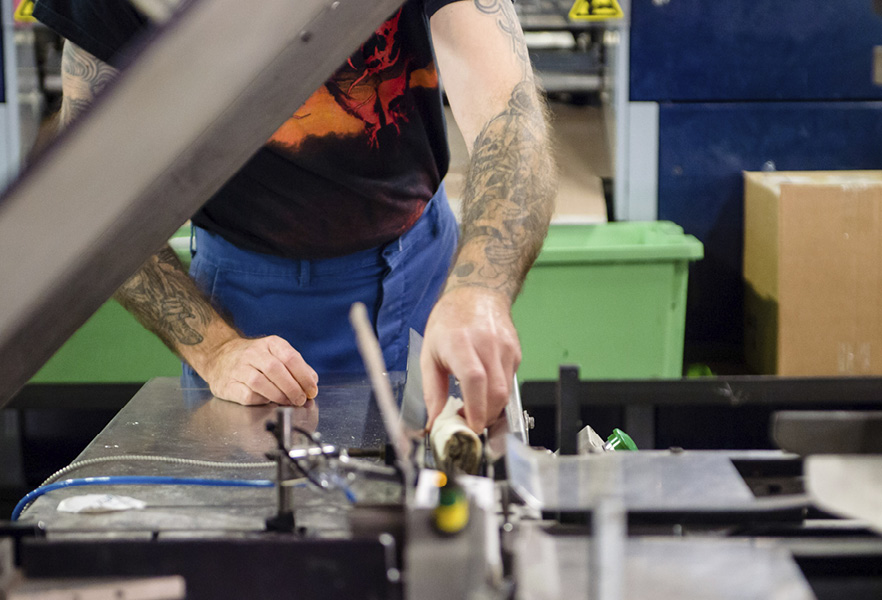
A factory worker produces compostable bags and films from renewable materials, Herent, Belgium, 28 October 2019.
While the recycling rate for plastic packaging in Europe has almost doubled since 2005, it still makes up less than 30 % of the 25 million tonnes of plastic waste produced by Europeans every year. As part of efforts to further boost recycling and reuse of plastics, in October more than 170 public and private partners from the plastics industry pledged to use 10 million tonnes of recycled plastic in new products by 2025. The initiative comes from the Circular Plastics Alliance, which held its first meeting in February.
After assessing health and environmental risks, the European Chemicals Agency in January concluded that restricting the intentional addition of microplastics in EU products would be justified.
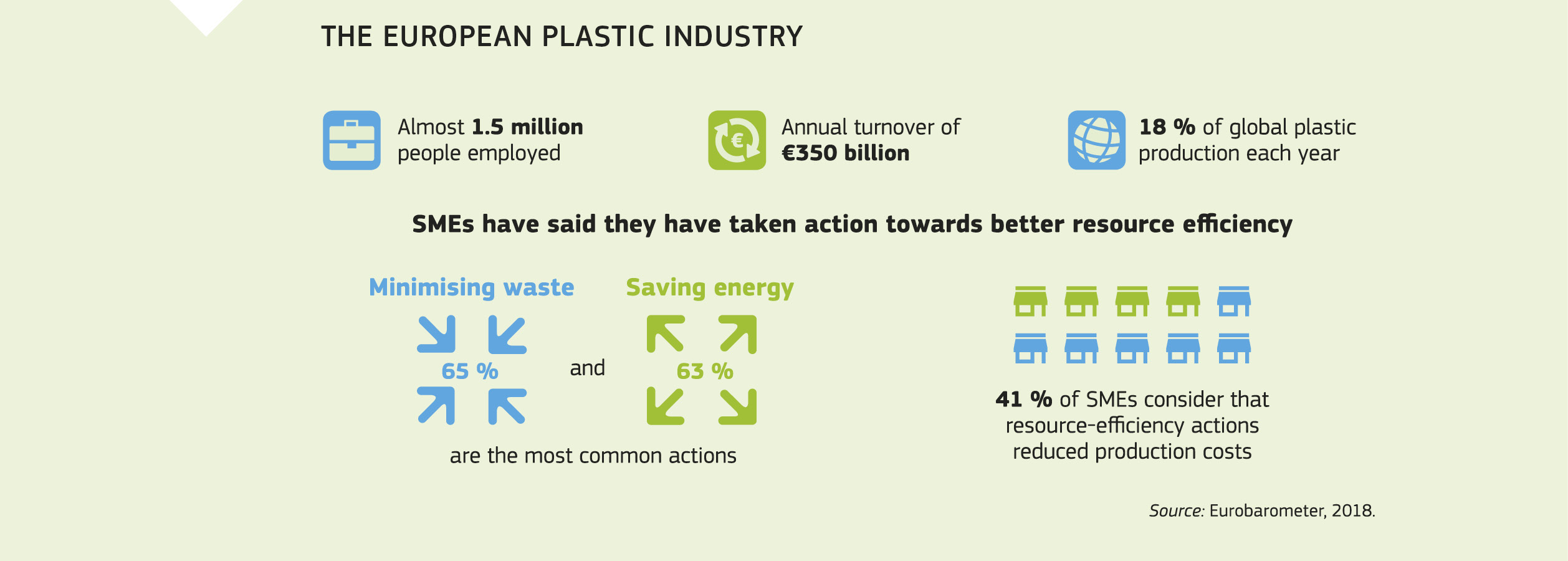
The European plastics industry employs almost 1.5 million people with an annual turnover of 350 billion euro, accounting for 18 % of the global plastic production each year. Small and medium-sized enterprises say they have taken action towards better resource efficiency, by minimising waste (65 %) or saving energy (63 %). 41 % of small and medium-sized enterprises consider that resource-efficiency actions decreased production costs. Source: Eurobarometer, 2018.
Finance for climate action and new technologies
In 2019, the Investment Plan for Europe helped more European citizens get their energy from renewable sources, bringing the total number of households helped by the plan to 7.4 million. The new Innovation Fund is a key instrument for delivering the EU’s economy-wide commitments under the Paris Agreement and for supporting the Commission’s strategic vision of a climate-neutral Europe by 2050. In February, the Commission announced over €10 billion worth of investment for low-carbon technologies in several sectors to boost their global competitiveness through the fund. Revenues will come from the auctioning of 450 million EU Emissions Trading System allowances from 2020 to 2030. Initiatives financed under the Horizon 2020 programme also make an important contribution to bringing new technologies to market.
Public money alone will not be enough to fight climate change, so the EU is making it easier to help investors identify and seize green investment opportunities worldwide. In October, it launched the International Platform on Sustainable Finance together with relevant authorities from Argentina, Canada, Chile, China, India, Kenya and Morocco.

The Innovation Fund’s first call for projects in 2020 will mobilise 10 billion euro of investments for the European Union’s climate-neutral future by 2030, mainly through avoiding emissions and boosting competitiveness. Thanks to the funding from the European Union Emissions Trading System, it will also support innovation in energy-intensive industries, renewables and energy storage, as well as in carbon capture, use and storage. Source: European Commission
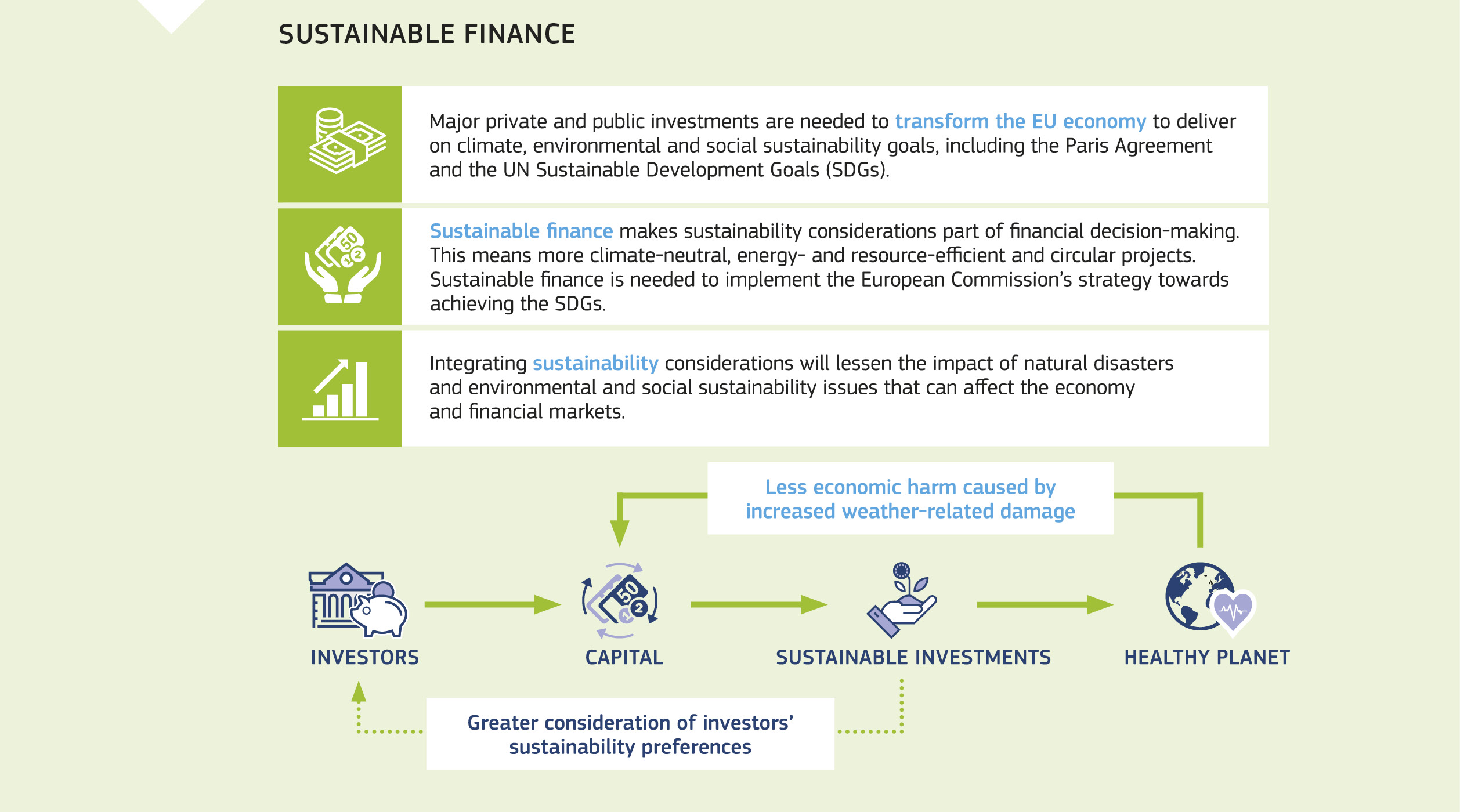
Major private and public investments are needed to transform the EU economy to deliver on climate, environmental and social sustainability goals, including the Paris Agreement and the United Nations Sustainable Development Goals. Sustainable finance makes sustainability considerations part of financial decision-making. This means more climate-neutral, energy- and resource-efficient and circular projects. Sustainable finance is needed to implement the European Commission’s strategy towards achieving the Sustainable Development Goals. Finally, integrating sustainability considerations will lessen the impact of natural disasters and environmental and social sustainability issues that can affect the economy and financial markets. If investors use their capital for sustainable investments, the result is a healthy planet with decreased economic harm caused by increased weather-related damage, returning positively on the initial investment. In addition, consistent sustainable investments will lead to greater consideration of investors’ sustainability preferences for the future. Source: European Commission
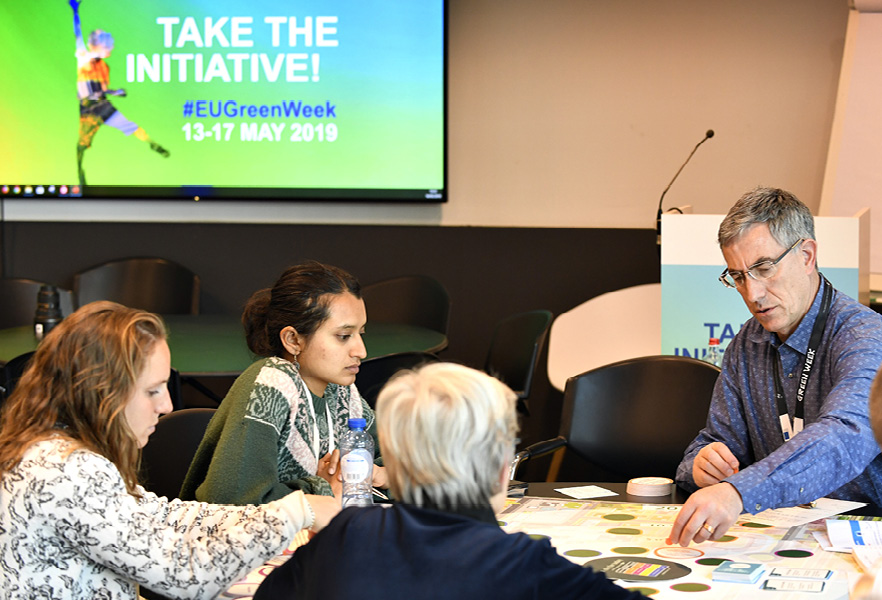
Participants take part in a group discussion at a conference during the EU Green Week, Brussels, Belgium, 16 May 2019.
In June, the Commission published new guidelines on corporate climate-related information reporting as part of its Sustainable Finance Action Plan. This provides around 6 000 EU-listed companies, banks and insurance firms with practical recommendations on how to report more accurately the impact their activities have on the climate as well as the impact climate change has on their business.
Protecting the environment
In April, the Commission published the second Environmental Implementation Review, as part of its 2016 initiative to improve the implementation of EU environmental policy and commonly agreed rules in all Member States. Doing so is not only essential for a healthy environment but also opens up new opportunities for sustainable economic growth, innovation and jobs. Full implementation of such legislation could save the EU economy around €55 billion every year in health costs and direct costs to the environment. The package includes a general communication and 28 country reports showing the state of play in the implementation of EU environmental law as well as opportunities for improvement in each Member State.
The mid-term review of the EU forest strategy concluded that significant progress has been made towards its 2020 objectives. Since its adoption, the strategy has facilitated the coordination of all EU policy areas relevant to forests and the forest-based sector, promoting a consistent approach in both domestic and international policies. In July, the Commission set out a new framework of action to protect and restore the world’s forests, which host 80 % of biodiversity on land, support the livelihoods of around a quarter of the world’s population and are vital in fighting climate change.
The EU is leading international cooperation for safer, more secure, cleaner and more sustainably managed oceans in Europe and around the world. In March, it published a joint report taking stock of the EU’s international ocean governance agenda. So far, 50 concrete actions, including fighting illegal fishing and legislation countering marine pollution, have been successfully implemented.
The future long-term budget of the EU
In 2019, the Commission continued working with the Parliament and Member States towards an agreement on the future long-term budget of the EU for 2021-2027.
In May 2018, the Commission made its proposal for a fair, balanced and modern EU budget to cover that period. It was the result of an open and inclusive discussion with the Parliament, Member States, beneficiaries of EU funding and other stakeholders. It aimed to equip Europe with sufficient resources to deliver on its priorities, respond to the challenges ahead and address citizens’ demands.
The proposed budget is equal to 1.114 % of the EU-27’s gross national income (GNI) – or national wealth. In comparison, national budgets are equal to an average of 47.1 % of the 27 Member States’ GNI (an average figure for 2014-2020).
This framework proposal was immediately followed by draft legislation for the 37 sectoral programmes forming part of the future long-term budget. These are the rules which specify, for example, how farmers will continue to receive their subsidies or how young people will be able to apply for the next generation of grants under Erasmus+.
2019 was dedicated to intense negotiations. The Parliament, the Commission and Member States made progress towards agreements on both the overall framework and the sectoral proposals.
Concerning the overall framework, by June the discussions had advanced sufficiently for EU leaders to touch upon the topic for the first time since the proposal had been made. At the European Council in December, they decided that the negotiations would be taken forward by the President of the European Council, Charles Michel, with a view to an agreement in early 2020. Once Member States reach a consensus among themselves, the Parliament’s green light will be needed for a final deal.
In parallel, the negotiations on the sectoral programmes continued. The Parliament and Member States managed to reach preliminary agreements on programmes that cover priorities like research, defence, investment and digital transformation. Once agreed, these programmes will, for example:
- allow hundreds of thousands of people to study, train, teach, work or volunteer abroad thanks to Europe’s youth mobility programme, Erasmus+;
- unleash investments of several hundred billion euro under the InvestEU programme, thus creating business opportunities and jobs;
- facilitate Europe’s digital transformation via investments in supercomputing, artificial intelligence, cybersecurity and trust, and making sure Europeans are equipped with the skills that make them fit for the digital age.
These are just a few of the EU budget’s benefits for Europe and its citizens. While negotiations continue, it is important to remember that the budget is not a zero-sum game.
Thanks to the budget, Member States gain from being part of the Single Market and being able to address challenges like migration and fighting terrorism and climate change together. They can also take advantage of the opportunities that cohesion policy – the EU’s main investment policy – creates for businesses from across the Union.
The EU also contributes significantly to the economies of its Member States. According to data compiled by the Commission, Member States contribute some 0.9 % of their GNI to the EU budget and get 5.92 % of their GNI thanks to the Single Market. In other words, Member States are paying €1 to the budget, but at the same time they are getting €6 thanks to the Single Market.
Chapter 4
A deeper and fairer internal market with a strengthened industrial base

© Fotolia
The internal market, also known as the Single Market, is one of the EU’s biggest achievements. It improves our daily lives and offers a unique springboard for companies to innovate and expand across borders. 2019 also saw the 25th anniversary of the European Economic Area (EEA), which extends the market to Iceland, Liechtenstein and Norway.
The EU works constantly to deepen the Single Market and increase its benefits. In 2019, the Commission presented its final proposals to complete the ambitious set of measures set out in the Single Market strategy, the Capital Markets Union and the Digital Single Market strategy, while other pending proposals were adopted by the European Parliament and the Council.
As a result, Europeans can now benefit from safer products on the EU market, including cleaner and safer cars, greater protection against harmful chemicals and better information about food products.
The EU has further simplified administrative procedures for businesses to operate across the continent, ensuring that the rules are enforced and respected. It has also made it simpler to make euro transactions across the entire EU as well as easier for authorities to detect value added tax (VAT) fraud. A new European Labour Authority will also help to provide citizens and businesses with advice about opportunities to live, work or operate in another Member State.
The Commission took several high-profile competition decisions to ensure a level playing field for companies and keep the Single Market functioning properly. The EU is also working with industry and national authorities to ensure our industries adapt to future innovation and sustainability challenges and remain globally competitive.
Celebrating 25 years of the European Economic Area

Initialling the agreement on the European Economic Area between the European Economic Community and the European Free Trade Association, Brussels, Belgium, 14 April 1992.
After celebrating the 25th anniversary of the EU’s Single Market in 2018, the following year marked another important milestone: 25 years since the creation of the European Economic Area. The EEA Agreement, which was signed in 1992 and entered into force in 1994, extends the four freedoms of the Single Market and related policies to Iceland, Liechtenstein and Norway. People, goods, services and capital can now move around the EEA’s 31 countries almost as freely as within a single country. EEA citizens can study, live, shop, work and retire in any of its countries. Hundreds of technical, legal and bureaucratic barriers to free trade and free movement between these countries have been removed. This has allowed companies to expand their operations and competition has brought prices down and given consumers more choice.
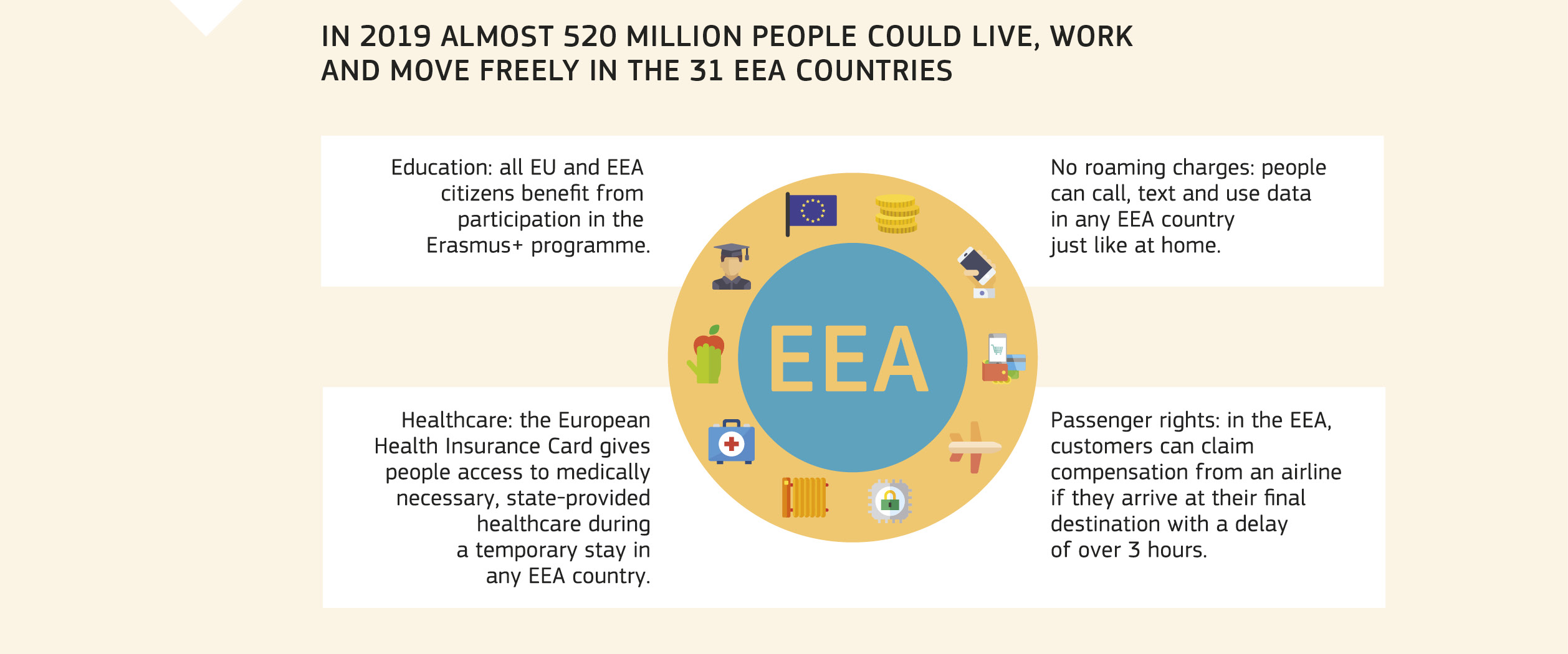
European Union and European Economic Area citizens all benefit from participating in the Erasmus+ programme. The European Health Insurance Card gives people access to medically necessary, state-provided healthcare during a temporary stay in any European Economic Area country. In addition, with no roaming charges, they can call, text and use data in any European Economic Area country just like at home, and airline customers can claim compensation if they arrive at their destination with a delay of over 3 hours.
Making the Single Market work better for people and businesses
The EU is continuously working on strengthening and deepening the Single Market to ensure it can respond to new challenges and deliver benefits for our citizens and businesses.
As part of these efforts, in June the EU agreed on new rules to ensure better compliance with Single Market legislation on non-food products. Applicable from 2021, these rules will strengthen checks by national authorities and customs officers and improve checks on products on the EU market. They will also intensify cooperation between authorities and facilitate rapid action against illegal products.
The EU also adopted a new regulation strengthening the application of the mutual recognition principle for products not covered by EU-wide legislation. This will open up more opportunities for companies to expand across EU borders. From April 2020, companies will be able to quickly find improved information on applicable national technical rules in another Member State and use simplified procedures to demonstrate that their product meets relevant national requirements.
In addition, the new standard on electronic invoicing, which came into force in April, will help public authorities to process all companies’ payments automatically and promptly.
A strong and innovative industrial base
European industries are global leaders in many areas but they need to adapt to new challenges such as fast-developing technologies, climate change and a changing global geopolitical context. To provide a new vision for European industry, the Commission set up the Industry 2030 High-Level Industrial Roundtable and published its recommendations in June. These focus on how European industry should build its competitive advantage through cutting-edge and breakthrough technologies, respect for the environment and biodiversity, investment in people, and smart European and global alliances.
Europe therefore needs to build on its strengths and assets to develop its industrial base. Artificial intelligence, batteries and cybersecurity are some of the many strategic and future-oriented areas where boosting Europe’s competitive advantage can generate growth. To identify areas of strategic importance, the Commission set up the Strategic Forum of Member States and industry representatives which, in its report published in November, identified six priority areas, provided recommendations for future policy action and coordinated transnational investments.
Strong industries also need to constantly adapt and innovate. The 2019 European Innovation Scoreboard report found that the EU continues to improve, with innovation performance up in 24 Member States. The EU’s leader in innovation was Sweden, followed by Finland, Denmark and the Netherlands. The fastest-growing innovators were Lithuania, Greece, Latvia, Malta, the United Kingdom, Estonia and the Netherlands. Importantly, the EU’s innovation performance surpassed that of the United States for the first time and has a considerable lead over Brazil, India, Russia and South Africa.

The six strategic areas for European industry are clean, connected and autonomous vehicles; smart health; a low carbon dioxide emissions industry; hydrogen technologies and systems; an industrial Internet of Things; and cybersecurity.

The European Innovation Scoreboard for 2019 shows Denmark, the Netherlands, Finland and Sweden as innovation leaders in Europe, while Belgium, Germany, Ireland, France, Luxembourg, Austria, Slovenia and the United Kingdom are ranked as strong innovators. Czechia, Estonia, Greece, Croatia, Italy, Cyprus, Latvia, Lithuania, Hungary, Malta, Poland, Portugal and Slovakia are moderate innovators, and Bulgaria and Romania classify as modest innovators. Source:. European Commission
Ensuring a level playing field in the Single Market
EU competition policy aims to support growth, investment and job creation by protecting consumers and law-abiding companies from anti-competitive and illegal business behaviour. As companies vie with each other to offer lower prices and a wider choice of innovative products, consumers are better off and Europe’s economy grows stronger, more competitive and more attractive to investors.
In 2019, the Commission took 362 merger decisions, 10 antitrust decisions, five cartel decisions and 248 State aid decisions. In total, it imposed fines of over €4 billion on companies found to be in breach of EU competition rules and ordered Member States to recover at least €65 million in unlawful and incompatible aid from beneficiaries.
The Commission uses merger control to ensure the Single Market delivers its potential by preventing risks to competition. The majority of mergers submitted to the Commission are cleared. So far, only 10 have been prohibited, three of which in 2019. These include Siemens’ acquisition of Alstom in the rail industry and Wieland’s acquisition of Aurubis Rolled Products and Schwermetall, both in February, and the joint venture between steel giants Tata Steel and ThyssenKrupp in June. In these cases, the companies failed to propose remedies to protect consumers and companies from possible risks. In other high-profile cases, such as Praxair/Linde and GSK/Pfizer, the merging parties offered suitable remedies and the Commission was then able to clear the transactions.

The Commission has prohibited the Siemens‒Alstom merger to protect rail operators and passengers. Rail-signalling systems are essential to prevent collisions and keep train and metro passengers safe, and high-speed trains are important for the transition to environmentally sustainable transport. If combined, Siemens and Alstom would no longer compete, resulting in higher prices, less choice and less innovation for rail operators.
The Commission also acts against companies that attempt to gain an unfair competitive edge. In January, Mastercard was fined €570 million for imposing cross-border restrictions in the use of payment cards. In May, AB InBev, the world’s largest beer brewer, was fined €200 million for abusing its dominant position on the Belgian beer market. Other companies that the Commission fined were restricting cross-border sales of the merchandising products of some of Europe’s best-known football clubs and of products featuring Hello Kitty owned by Sanrio. In cases involving several major Hollywood film studios, these pledged to remove restrictions that prevented cross-border competition between pay-TV broadcasters and offered commitments that the Commission made legally binding in March.
The Commission continued to break up cartels and impose heavy fines on the companies involved. In March, it sanctioned three companies supplying seatbelts and other safety equipment to Europe’s car manufacturers by imposing fines of €368 million and, 2 months later, five major banks – Barclays, RBS, Citigroup, JPMorgan and MUFG – settled for over €1 billion for participating in a foreign-exchange spot-trading cartel.
In addition, the Commission makes sure Member States’ support to companies does not unfairly favour some companies over others. In April, the Commission took a State aid decision ordering the United Kingdom to recover the selective tax advantages that authorities granted to multinational companies resulting from waivers to provisions designed to fight corporate tax avoidance.

A multinational ‘X’ based in the United Kingdom transferred capital to one of its offshore subsidiaries, which in turn made a loan to a foreign group company of the same multinational ‘X’. The interest generated by the loan in favour of the offshore subsidiary was not taxable by the United Kingdom tax administration by virtue of the group financing exemption, thus creating an illegal tax advantage.
Competition policy can also help the EU pursue a modern industrial policy, as shown by the €3.2 billion in public support offered by seven Member States and approved by the Commission for an Important Project of Common European Interest (IPCEI) for research and innovation in battery production. This is the second major IPCEI investment approved after the €1.7 billion microelectronics one involving Germany, France, Italy and the United Kingdom and cleared in December 2018.
Removing barriers to the free movement of goods and services
The EU worked on strengthening rules in specific sectors to make it easier for businesses to sell their goods and services across borders and improve the safety of products on the EU market.
Improving rules in the chemicals and pharmaceutical sectors
In June, the Commission also published a review of the EU chemicals legislation. It found that harmonisation and common standards have made the single market for chemicals stronger and more efficient, while offering the world’s highest levels of protection for human health and the environment. The EU also took a series of measures to protect workers and consumers from harmful chemicals, including 29 REACH authorisation decisions setting conditions for the use of certain chemicals, one refusal of authorisation and one restriction on thulium-doped fibre amplifier, a substance causing respiratory problems when used in sprays. In addition, the carcinogens and mutagens directive was updated with the addition of five substances to the list of recognised cancer-causing chemicals in the workplace. This means that 27 such chemicals are now covered by the directive.
The EU also adopted new rules to improve the level playing field in the pharmaceutical sector. These will make it easier for EU companies to export generic and biosimilar medicines to non-EU countries where intellectual property protection has expired or never existed, while preserving the strong existing rights within the EU to encourage innovation and research.
A Single Market for public procurement
The EU has an open procurement market, which is the biggest in the world at an estimated €2 trillion per year. Given the increasingly global nature of public procurement, the EU is taking a strategic approach to ensure all bidders, domestic and foreign, comply with EU rules. To this end, in July the Commission published guidance on the participation of foreign bidders in the EU market.
Better financial services
As part of the efforts to create a deeper and more integrated Capital Markets Union in Europe, the EU adopted a revised regulation on cross-border payments, ensuring that charges for cross-border payments in euro within the Union are aligned with charges for corresponding national payments made in the currency of the Member State in which the payment service provider of the payment service user is located. This allows consumers and businesses in non-euro countries to benefit from low-cost euro transactions across borders, just like in the euro area. As a result, for example, the price of an intra-EU transaction in euro from Bulgaria to Finland is expected to decrease, from between €15 and €24 to about €1. The regulation will ensure that currency-conversion charges are transparent and comparable at an ATM or point of sale, allowing consumers to save money on conversion costs when they travel or shop abroad. In addition, the EU stepped up its efforts to support the development and availability of cross-border instant payments.

Before 15 December 2019, sending money from a euro-area country to a non-euro-area country incurred zero or low fees for the sender and high fees for the receiver. Sending money from a non-euro-area country to either a non-euro-area country or a euro-area country also incurred high fees. Only transfers within the euro area incurred low or zero fees for both sides. Since 15 December 2019, all transfers in euro, either within or between the euro and the non-euro areas, incur zero or low fees.
Ensuring a fair tax system
EU tax policy aims to support the competitiveness of the EU and stimulate investment, growth and entrepreneurship in its Single Market. By making tax systems simpler, it should be easier for businesses to operate and citizens to work across borders. Moreover, the EU aims at taxes that are fair and socially just, notably by fighting tax abuse at EU and international levels and by curtailing unfair tax competition in the Single Market and beyond.
In order to fight tax fraud and facilitate administrative cooperation for EU and national revenue collection, in May the Commission launched the Transaction Network Analysis tool, which provides the EU’s network of anti-fraud experts with fast and easy access to information on cross-border transactions, leading to quick and coordinated action when potential VAT fraud is flagged. In September, the first meeting took place of the Tax Administration EU Summit, which is a cooperation network for the Member States’ heads of tax administrations and the Commission.
To tackle VAT fraud related to new and second-hand cars, in July the Commission adopted implementing measures supporting the automated exchange of customs and vehicle-registration information between national authorities. The EU list of non-cooperative jurisdictions for tax purposes, a common tool for Member States to tackle external risks of tax abuse and unfair tax competition, was adopted in March. In September, the Commission published evaluations of two directives: on administrative cooperation in the field of taxation and on energy taxation.
Towards fair labour mobility
The EU is working to strengthen labour mobility by establishing clear and fair rules, facilitating cooperation between Member States and fighting causes of abuse. As part of this, the European Labour Authority was set up in July, with its first activities kicking off in October. Its role is to help enforce labour-mobility rules across Member States. It will do this by facilitating the provision of information to citizens and businesses about their rights and obligations regarding opportunities to live, work or operate in another country, strengthening cooperation between Member State authorities and mediating solutions in cross-border disputes. The authority will be based in Bratislava, Slovakia, and is expected to reach full operational capacity by 2024.
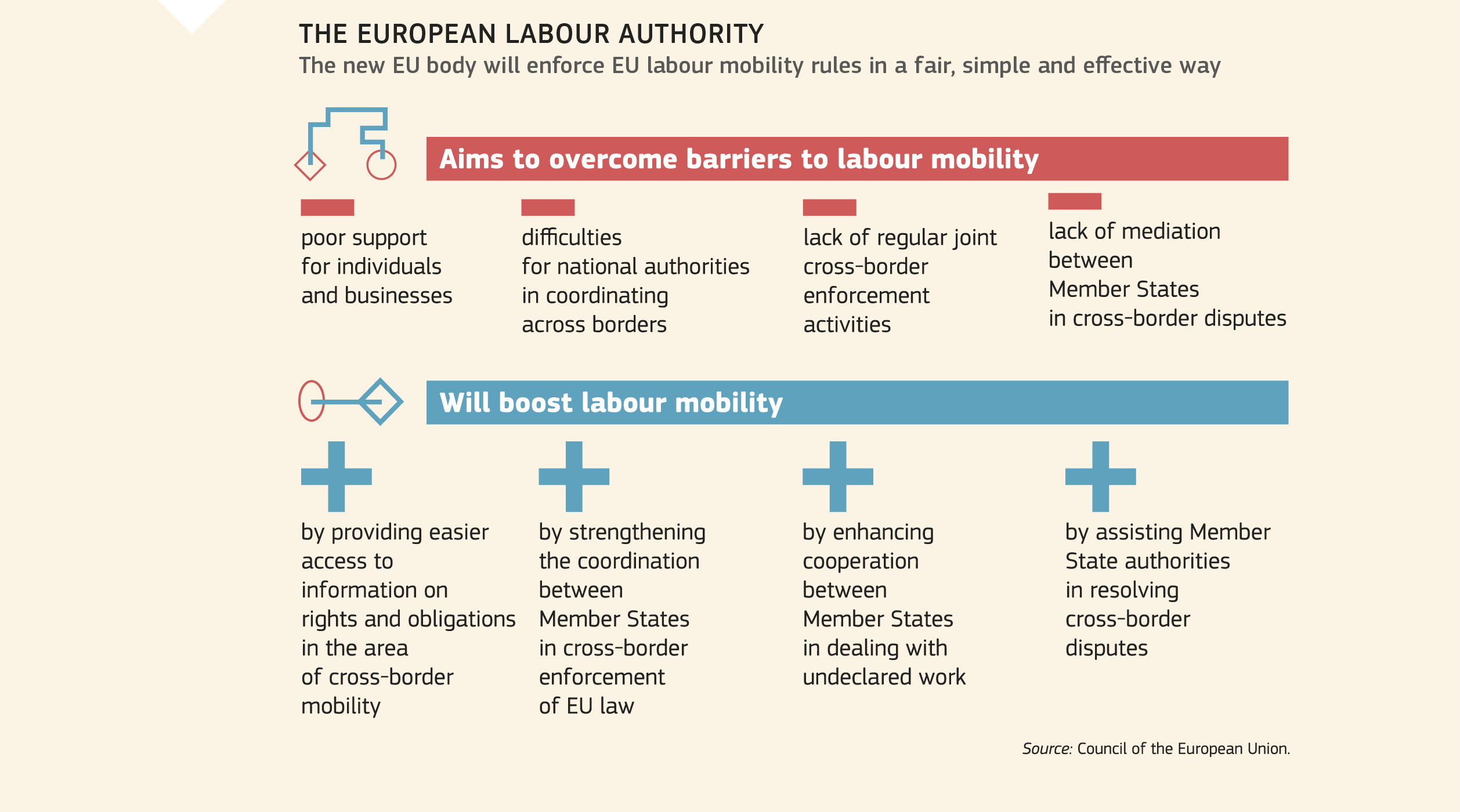
The European Labour Authority will enforce European Union labour mobility rules in a fair, simple and effective way. It aims to overcome barriers to labour mobility such as poor support for individuals and businesses, difficulties for national authorities in coordinating across borders, lack of regular joint cross-border enforcement activities, and lack of mediation between Member States in cross-border disputes. It will also boost labour mobility by providing easier access to information on rights and obligations in the area of cross-border mobility, by strengthening the coordination between Member States in cross-border enforcement of European Union law, by enriching cooperation between Member States in dealing with undeclared work, and by assisting Member State authorities in resolving cross-border disputes. Source: Council of the European Union. Copyright: European Union
Making progress on safe, clean and connected mobility
Mobility plays a big role in connecting and integrating the Single Market. The EU is working to modernise Europe’s transport systems, which will allow people to benefit from safer traffic, cleaner vehicles and better technological solutions and will support the transport industry’s competitiveness.
In March, the Parliament and the Council reached an agreement on the revised general safety regulation, which aims to introduce new mandatory safety technologies in all vehicles sold, registered or put into service from 2022. This will improve the protection of EU citizens, help reduce the number of accidents on roads and improve the legal framework for approving automated and connected vehicles. In February, the Commission also prepared guidelines for the approval of automated vehicles and, in June, launched an EU platform to coordinate experiments involving automated and connected vehicles.
Earlier in the year, the EU also delivered measures to ensure assessments of infrastructure safety for primary roads, help better target investments and pave the way for autonomous driving across the EU. The Commission also adopted new harmonised rules on drone traffic to cope with the increasing numbers across Europe.

Using the new e-documentation for the handling of goods in Europe will help save a lot of time for all the actors involved. Currently, about 390 million working hours per year are spent on processing freight transport information. In the future, the digital exchange of this information will save the business sector between 75 million hours and 102 million hours of work. Source: European Commission
Several measures were also adopted to ease the administrative burden across the transport sector. In June, the European Union Agency for Railways delivered the first European vehicle authorisation, valid in multiple countries across the continent. An agreement was also reached on a proposal for electronic freight transport information, which will help save the millions of hours previously spent on managing paper documents.
To improve the interoperability of transport systems, in May the Commission adopted a set of measures addressing rail interoperability, train accessibility and rail noise. The electronic tolling systems directive entered into force and will enhance interoperability of electronic tolls, simplify administrative procedures and reduce fraud.
Chapter 5
A deeper and fairer Economic and Monetary Union
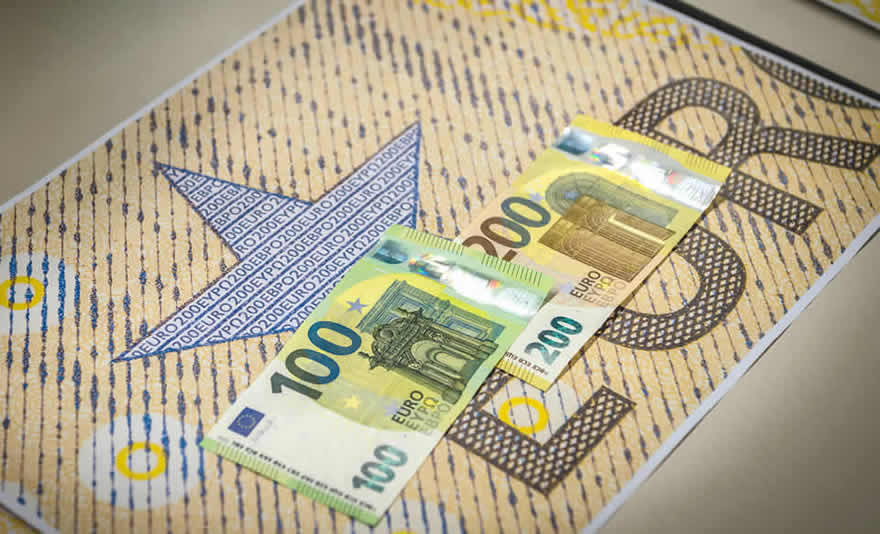
The EU sees a deeper Economic and Monetary Union (EMU) as being a priority because it is a powerful tool to achieve more jobs, stronger growth, higher investment and greater social fairness, as well as enhanced macroeconomic stability and resilience.
In June, Member States reached a broad agreement on a number of important steps, including the creation of a budgetary instrument for convergence and competitiveness for the euro area.
A proposed revision of the European Stability Mechanism treaty would allow the rescue fund to provide a financial backstop to the Single Resolution Fund, which deals with failing banks.
New legislation in April to reduce risks in the banking sector will help strengthen the Banking Union. Plans to create a common deposit insurance scheme for euro-area banks also continued and the Commission acted to ensure fair competition in the sector.
The European Pillar of Social Rights helped put an emphasis on fairness in the EMU, with legislation to improve working conditions adopted in June and a new law to promote work–life balance and gender-balanced parental leave coming into force in August.
The EU also took action to increase access to social protection systems and encourage entrepreneurship.
Deepening the Economic and Monetary Union
A deeper Economic and Monetary Union (EMU) is a priority for the EU because it would strengthen its economic stability, resilience and potential for growth.
In June, euro-area Member States took another step towards achieving this goal by agreeing on the main features of a budgetary instrument for the area. Known as the Budgetary Instrument for Convergence and Competitiveness, it is intended to support structural reforms and investment with the aim of boosting growth and enhancing the economic resilience of euro-area economies as well as their ability to rebound from shocks. In October, further decisions were taken on details of how the instrument will work. An agreement on its size will be made in the context of discussions over the EU’s next long-term budget.
Euro-area Member States also agreed to allow the European Stability Mechanism to provide a financial backstop that would only be activated as last-resort insurance in the event of a bank resolution. It would take the form of a credit line or guarantees to the Single Resolution Fund so that taxpayers would not be forced to pay for the resolution of failing banks. Use of the backstop would ultimately be repaid through contributions from the European banking sector.

The initiatives to strengthen the international role of the euro can be divided into four different areas. The first is the completion of the Economic and Monetary Union, the Banking Union and the Capital Markets Union. The second area comprises measures to foster a deep European financial sector, such as strengthening the liquidity and resilience of European market infrastructure; ensuring a reliable framework for a trustworthy interest rate benchmark; supporting a fully integrated instant-payment system in the European Union; and launching a consultation about euro liquidity in foreign-exchange markets. The third area covers initiatives linked to the international financial sector, such as supporting central banks’ collaboration to safeguard global financial stability; increasing the share of euro-denominated debt by European bodies; fostering economic diplomacy to promote the use of the euro in payments and as a reserve currency; and providing technical support to improve the access of developing countries to the euro payment system. The fourth promotes the use of the euro in key strategic sectors such as energy, with recommendations to promote a wider use of the euro in international energy agreements and transactions, and consultations on expanding the use of euro-denominated transactions in oil, refined products and gas. It also includes consultations on increasing the use of the euro in raw materials and food commodity trading and on expanding the use of the euro by transport-sector manufacturers (aircraft, maritime and railways). Source: European Commission Copyright: European Union
The European Union has made great progress in deepening the EMU since the 2008 financial crisis. A communication from the Commission in June took stock of how far the EU has come since first setting out its vision for a deeper EMU in the 2015 five presidents’ report. According to the communication, particular progress has been made in the economic governance framework and in the application of fiscal rules, which have been improved, with a greater emphasis on social priorities such as more opportunities for social partners at all levels to discuss them. In addition, the European Fiscal Board (established in 2015) has become an integral part of the EU fiscal framework, providing independent assessments and advice to the Commission.
The key elements of a Banking Union and a Capital Markets Union (CMU), such as the banking package to strengthen the resilience and resolvability of EU banks and a proposal for a European Deposit Insurance Scheme, have also been firmly established. The Commission has tabled all the legislative proposals set out in the CMU Action Plan and mid-term review to put in place the key building blocks of the CMU. The Commission has proposed six legislative measures to introduce new EU-wide rules for products, labels and passports, and five legislative measures to provide simpler, clearer and more proportionate rules for entrepreneurs, businesses and financial institutions (see Chapter 1).
It has also proposed two legislative measures to ensure a more integrated and more efficient supervision of capital markets, which is central to the CMU and necessary for more financial integration and more private risk sharing. The Commission has also adopted three legislative proposals to enable the financial sector to lead the way towards a climate-neutral, more resource-efficient and more resilient circular economy.
The European Parliament and the Council have reached political agreement on almost all of these proposals; still, more needs to be done. The Commission’s June report called for further improvements to the transparency and effectiveness of the EU’s policy coordination framework and its social dimension. Institutional changes could also be made to strengthen democratic accountability in the EU and economic decision-making in the euro area, and to bring the European Stability Mechanism into the EU legal framework. Mechanisms to stabilise the euro area in the event of shocks would also be beneficial and could include an Investment Stabilisation Function and a common unemployment reinsurance scheme.
Completing the Banking Union
The EU’s banking and capital markets are vital elements of its EMU. Together, they promote a more integrated and stable EU financial system. They increase the resilience of the EMU against adverse shocks by facilitating private risk sharing across borders at the same time as reducing the need for public risk sharing. Work on both projects continued throughout the year.
In particular, significant progress was made in lowering risks in the Banking Union. The adoption of the banking package in April was an important milestone in strengthening the EU’s banking sector. The package sets out a comprehensive set of reforms that will further strengthen the resilience and the resolvability of banks, in addition to the proposal for a European Deposit Insurance Scheme. It also puts in place a series of important international standards and aims to contribute to the completion of the post-crisis regulatory agenda.
The Commission has been working together with Member States concerned to address the high level of non-performing loans (NPLs), including through the European Semester, and to come up with comprehensive solutions to deal with bad loans, in line with State-aid rules. Member States’ supervisors and banks have also made considerable progress in bringing down their debt levels, improving the quality of their loan portfolios and increasing liquidity since the crisis.
The Commission’s latest progress report showed that the ratio of NPLs for all EU banks continued to decline towards pre-crisis levels and was down to 3.3 % in the third quarter of 2018. In 2019, the European Parliament and the Council agreed on new rules to apply capital requirements to banks with NPLs on their balance sheets. The aim of the reform is to ensure that banks set aside sufficient own resources when new loans become non-performing and to create appropriate incentives to avoid the accumulation of NPLs.
An important next step in the Banking Union and in deepening the EMU will be to make progress on a common deposit insurance scheme for the euro area.
The international role of the euro
The EU’s efforts to promote the use of the euro internationally are closely linked to the deepening of the EMU. A deeper, stronger financial sector and EMU would make the euro a more attractive international currency, and a more globally important euro would strengthen Europe’s financial system. The euro area is also growing within the EU as Croatia and Bulgaria decided to start preparations to enter the European Exchange Rate Mechanism ERM II, as a first step to membership of the euro area.
Greater international use of the euro would also have many benefits for European businesses, consumers and governments, such as lower trading costs, lower interest rates, better access to financing, greater legal autonomy and a more resilient financial system that would be less vulnerable to exchange-rate shocks.
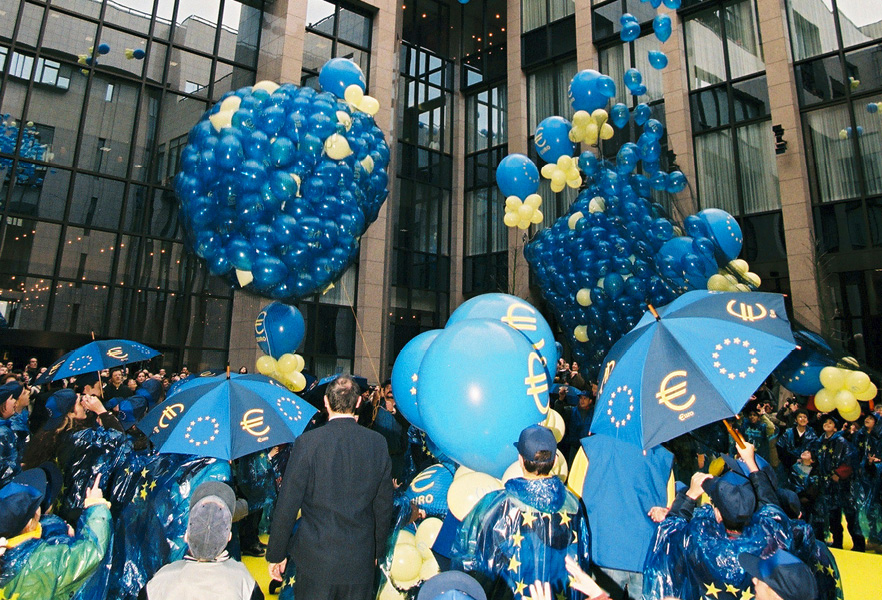
The European Union celebrates #EUROat20 in 2019. Here, balloons are released in front of the European Council following a ceremony to mark the original setting of exchange rates between the euro and the currencies of euro-area Member States, Brussels, Belgium, 31 December 1998.
In 2019, the European Commission consulted extensively with representatives of foreign exchange markets and the energy, raw materials, agriculture and transport sectors. These consultations confirmed that there is broad support for using the euro more internationally and that it is the only viable alternative international currency to the US dollar. Those consulted also agreed that there was potential to denominate more transactions in euro, particularly in energy commodity and natural gas markets, and the Commission agreed to work on any impediments that were identified.
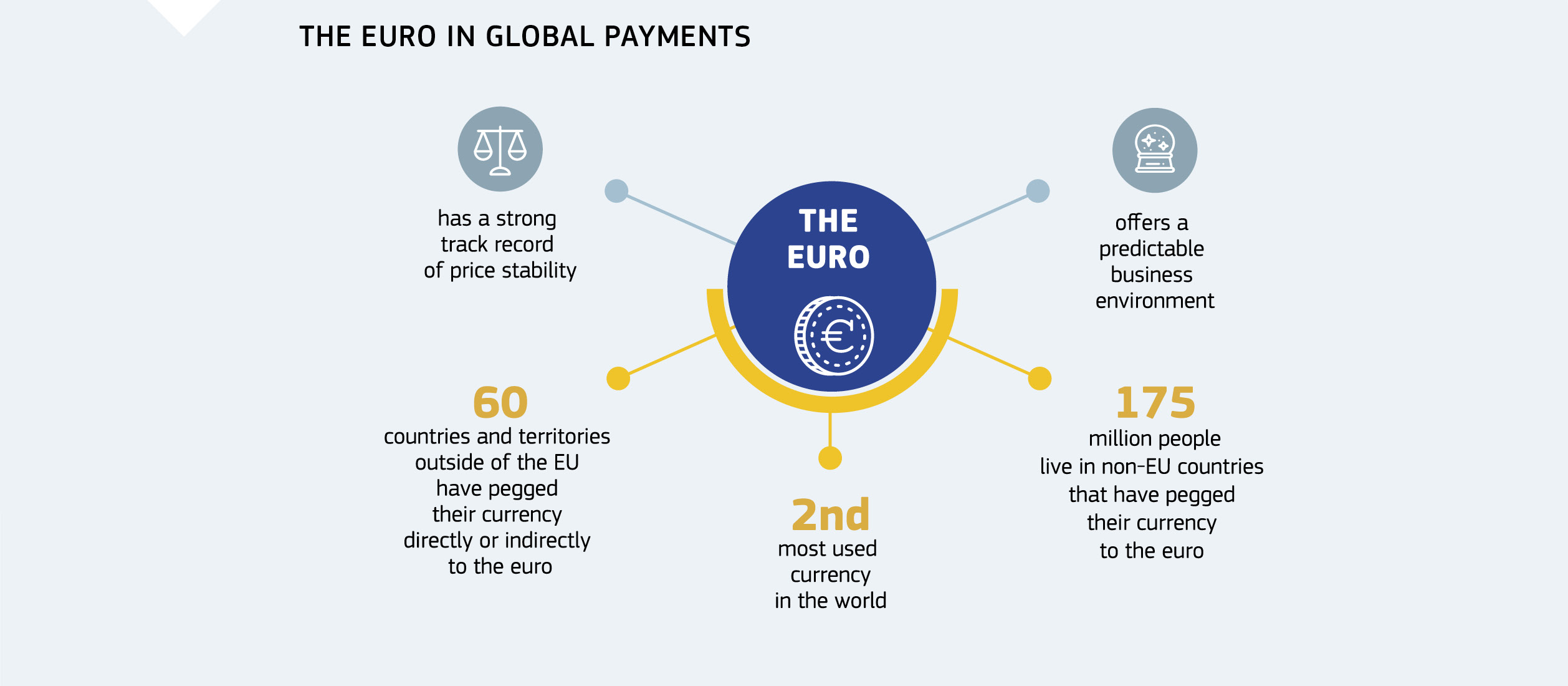
The euro offers many benefits to the economy, bringing a strong track record of price stability and a predictable business environment. It is also the second-most-used currency in the world, with 60 countries and territories outside the EU (totalling 175 million people) whose currency is directly or indirectly pegged to the euro. Source: European Commission
The EU also made progress on measures to support the euro’s use, including regulatory amendments to increase the resilience and liquidity of financial market infrastructures, improve the reliability of interest-rate benchmarks and promote the use of instant payments.
Fair opportunities and fair competition
A deep and fair EMU rests on fair opportunities and fair competition. In order to improve the former, the restructuring and second chance directive was adopted by the EU in June to allow viable businesses in distress to be rescued and honest but bankrupt individuals to be given a second chance.
The new directive will help viable companies with financial difficulties to access preventive restructuring frameworks at an early stage so that they can avoid insolvency, continue their activity and preserve jobs.
Under the new rules, the EU is giving reputable bankrupt entrepreneurs a second chance, fully discharging them of their debt after a maximum period of 3 years, with justified exemptions in order to prevent abuse.
The rules will also increase the efficiency of insolvency, restructuring and discharge procedures, reducing excessive procedural length and costs in many Member States.
These rules will contribute to removing important barriers to the development of capital markets by providing more legal certainty to cross-border investors and companies operating across the EU.
The EU is always vigilant in ensuring the fairness of competition in the banking sector and 2019 was no exception. Although the sector has largely recovered since the crisis, pockets of vulnerability remain, with banks in some Member States still burdened by a high proportion of NPLs. The Commission continued its role in helping them to restructure and deal with temporary liquidity constraints or structural problems without unduly distorting competition. For example, Slovenia’s banks completed the restructuring process that they had begun in 2012/2013. Slovenia privatised 75 % of NLB and 100 % of Abanka – two former lenders in difficulty. Italian banks took further steps to reduce the amount of NPLs. The implementation of a guarantee mechanism was instrumental in this regard in allowing banks to off-load NPLs on market terms. Also in Italy, the Commission approved support to deal with the temporary liquidity needs of up to €3 billion for Carige, a medium-sized regional bank in the north-west of the country.

What are they? A loan is classified as non-performing when a borrower has not made scheduled payments on interest or capital reimbursements for 90 days or more past the due date, or is still repaying the loan but with a low likelihood of success. Why do we need to tackle them? To reduce risks to banks’ stability and the financial system as a whole, to enable banks to lend more to households and businesses, and to encourage economic growth by making funding available to viable companies.
Greater social fairness in the Economic and Monetary Union
The European Pillar of Social Rights has become an integral part of the European Semester, the EU’s annual cycle of economic and social policy coordination. Numerous social-policy measures on work–life balance, transparent and predictable working conditions and fair cross-border mobility have been promoted with the help of the pillar. It enshrines a set of 20 future-oriented social-policy principles that Member States have agreed.
A new start to support work–life balance for parents and carers
The directive on work–life balance was adopted in June and encourages more equal sharing of caring responsibilities between women and men. It sets minimum requirements for Member States and gives each parent the right to at least 4 months of parental leave, of which 2 months cannot be transferred from one parent to another and should be compensated at an adequate level set by Member States. The directive also introduces a right to paternity leave of at least 10 days after the birth of a child, compensated at least at the same level as sick pay. The new legislation also gives working carers the right to take 5 days per year to care for family members. In addition, all working parents of children aged up to at least 8 years have the right to request flexible working arrangements (reduced working hours, flexible working hours and flexibility at place of work). These new rules are aimed at increasing women’s participation in the labour market and at improving equality between men and women.

The new directive on work‒life balance will give all working fathers at least 10 days of paternity leave around the time of the birth of their child, and at least 4 months of parental leave for each parent, of which two are non-transferable. Parents will also have more flexibility with their parental leave. Finally, every worker has the right to at least 5 days of carer’s leave per year. Source: European Commission
New rights for more workers
The directive on transparent and predictable working conditions was also adopted in June. Its aim is to broaden and modernise existing obligations to inform each worker, including those in non-standard forms of employment, of their working conditions. The directive also introduces a number of new minimum rights, for instance a limit to the length of probationary periods at the beginning of a job. Member States have until mid 2022 to transpose the new rules into their national legislation.
Better access to social protection for all workers
Member States have committed to ensure that all working people have effective access to social protection regardless of their employment status. The Council adopted a recommendation in November to help them close the gaps affecting atypical workers and the self-employed and to address the challenges stemming from the fast-paced digitalised world of work.

The world of work is changing. 40 % of employed people are either non-standard workers (not working under a full-time, open-ended contract) or self-employed. The average European worker will have 10 different jobs throughout their career, and new forms of work are growing. Social security systems need to adapt; they are often not tailored to self-employed and non-standard workers, leaving them without sufficient protection. For instance, not all workers have the right to contribute and participate in all social protection schemes. Some of the barriers to accessing benefits include no access to pension schemes for some non-standard workers in 13 Member States, no coverage in case of accidents at work for the self-employed in 10 Member States, and a minimum working period for the self-employed in nine Member States. New European Union guidelines seek to improve the situation by extending coverage of unemployment benefits, sickness and healthcare benefits, maternity and paternity benefits, invalidity benefits, old-age benefits, and benefits in case of accidents at work or work-related diseases to all people in employment and self-employment. The guidelines will remove barriers to accessing benefits by helping to preserve, accumulate and/or transfer entitlements, providing an adequate level of protection, and giving transparent information on individual entitlements and obligations. Some Member States are already taking steps to extend coverage. In Slovenia all forms of work are now included in the social security systems, and in Denmark non-standard workers and the self-employed are integrated into the general unemployment insurance scheme.
The year in pictures
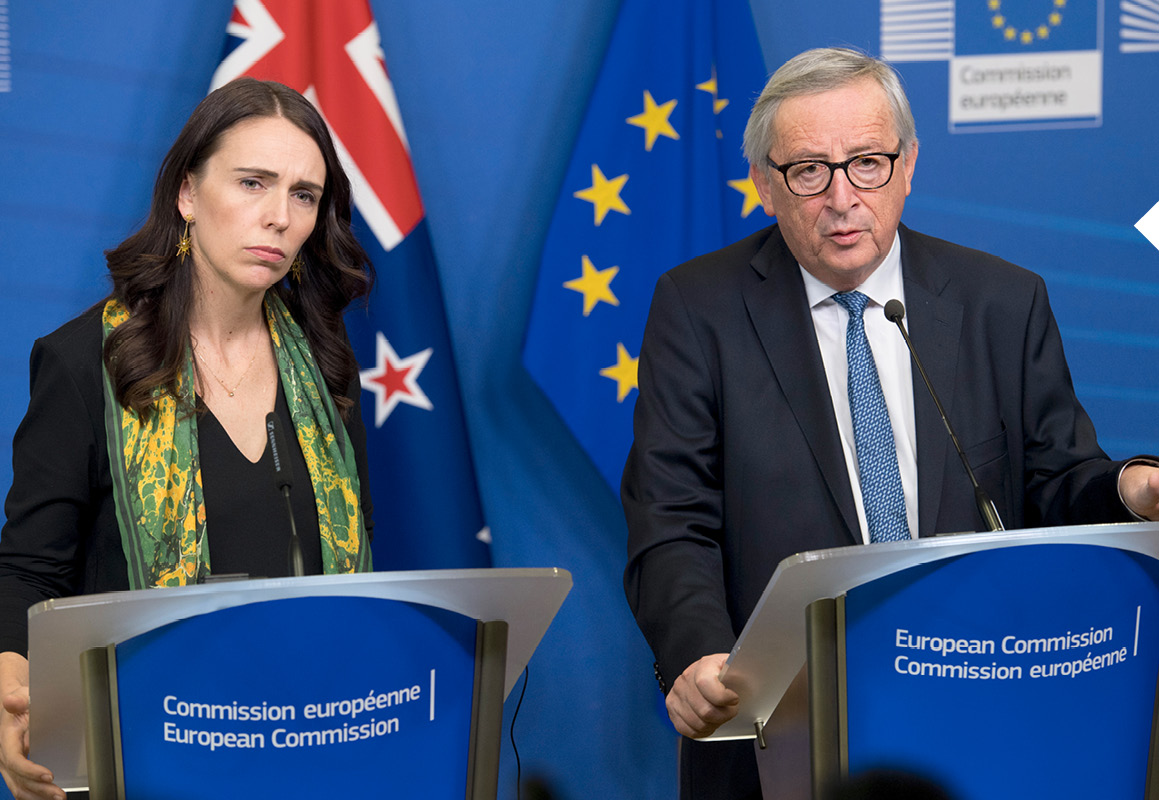
Jacinda Ardern, Prime Minister of New Zealand, meets with Jean-Claude Juncker, President of the European Commission, Brussels, Belgium, 25 January 2019.
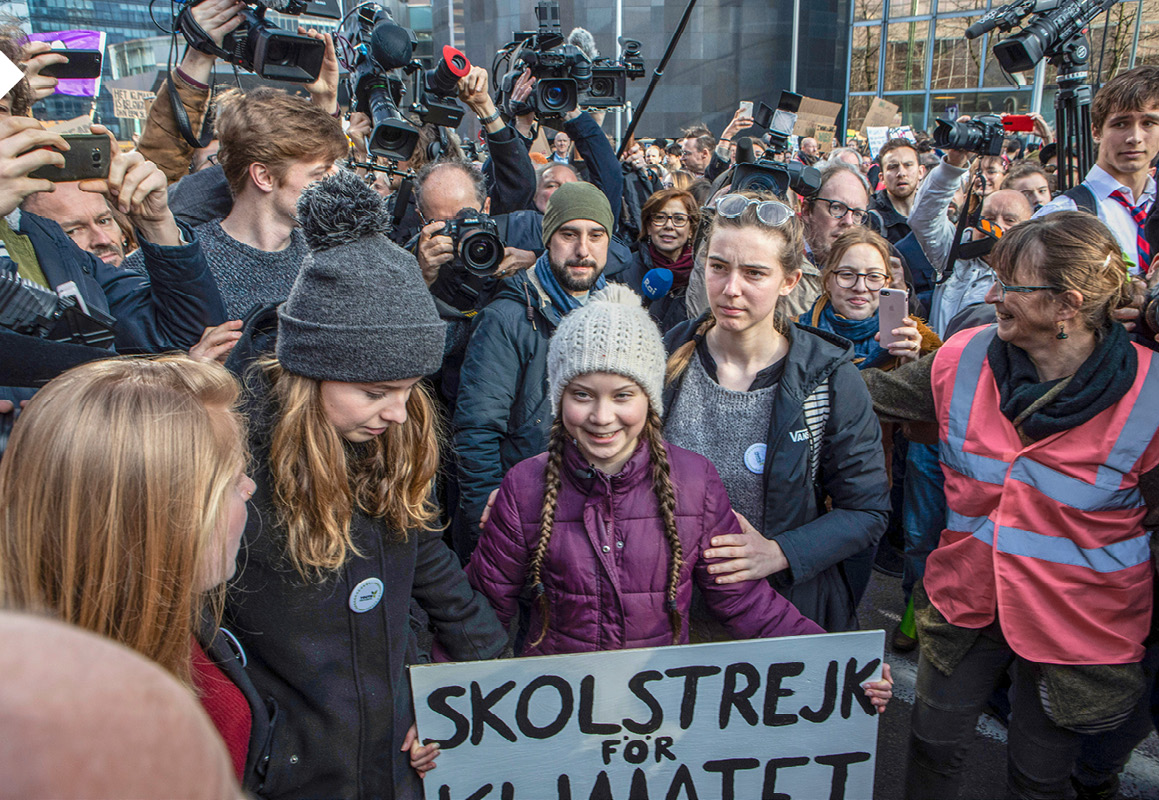
Greta Thunberg participates in a school strike for the climate, Brussels, Belgium, 21 February 2019.
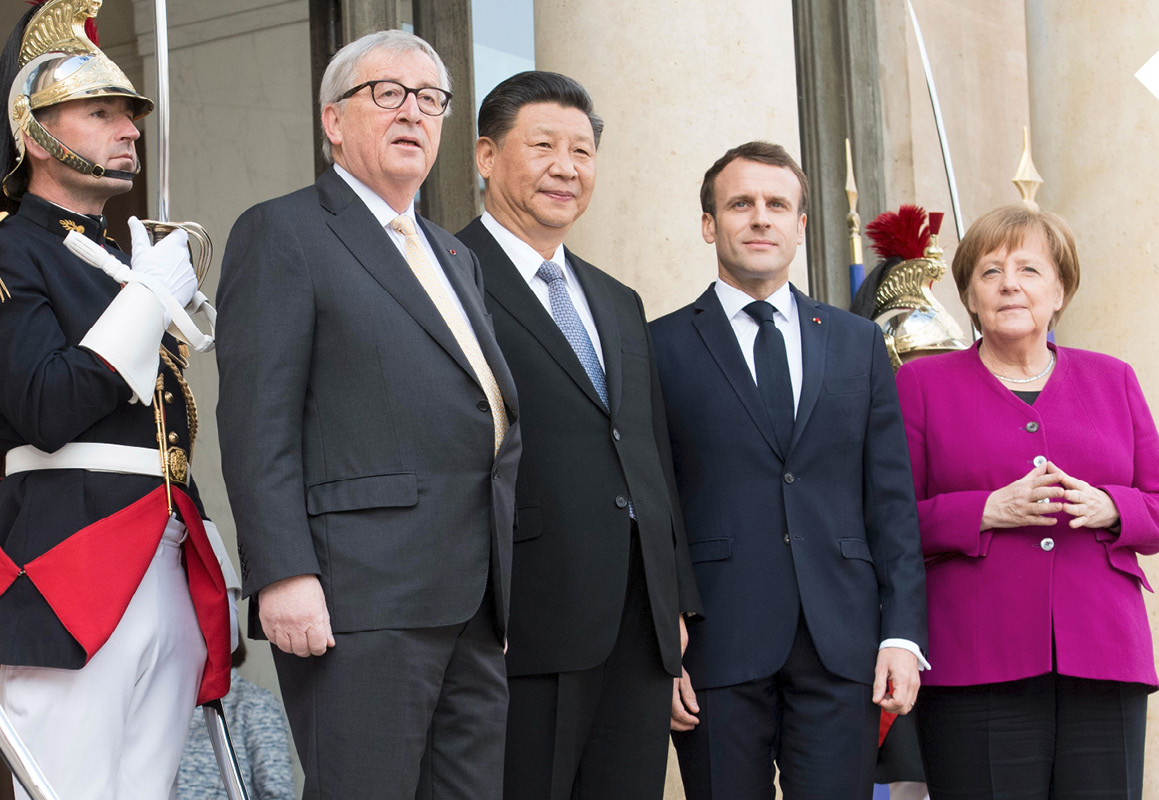
Jean-Claude Juncker, President of the European Commission, Xi Jinping, President of China, Emmanuel Macron, President of France, and Angela Merkel, Chancellor of Germany, meet during a meeting on global governance, Paris, France, 26 March 2019.

Paul Kagame, President of Rwanda, meets with Jean-Claude Juncker, President of the European Commission, to commemorate the Rwandan genocide, Kigali, Rwanda, 8 April 2019.

A poster promoting the ‘A day in the life’ video series explaining how the EU improves young people’s lives, as part of the #EUandMe campaign.

Historical posters hang in the European Commission Berlaymont headquarters during the Open Doors Day, Brussels, Belgium, 4 May 2019.

Fire experts from the EU Civil Protection Team advise local fire forces in Guatemala when the country requested assistance through the EU Civil Protection Mechanism following an extended forest fire season, Petén, Guatemala, 24 May 2019.
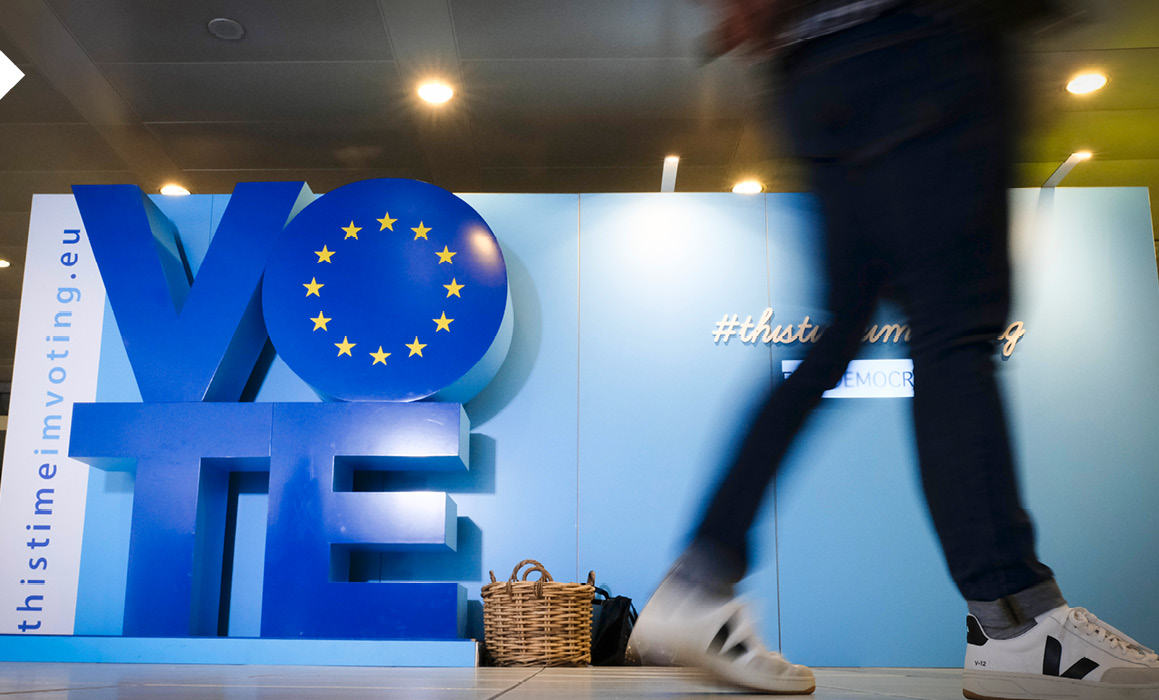
An installation promotes the EU’s ‘This time I’m voting’ campaign to encourage electoral participation in the European parliamentary elections inside the Brussels–Luxembourg railway station, Brussels, Belgium, 24 May 2019.
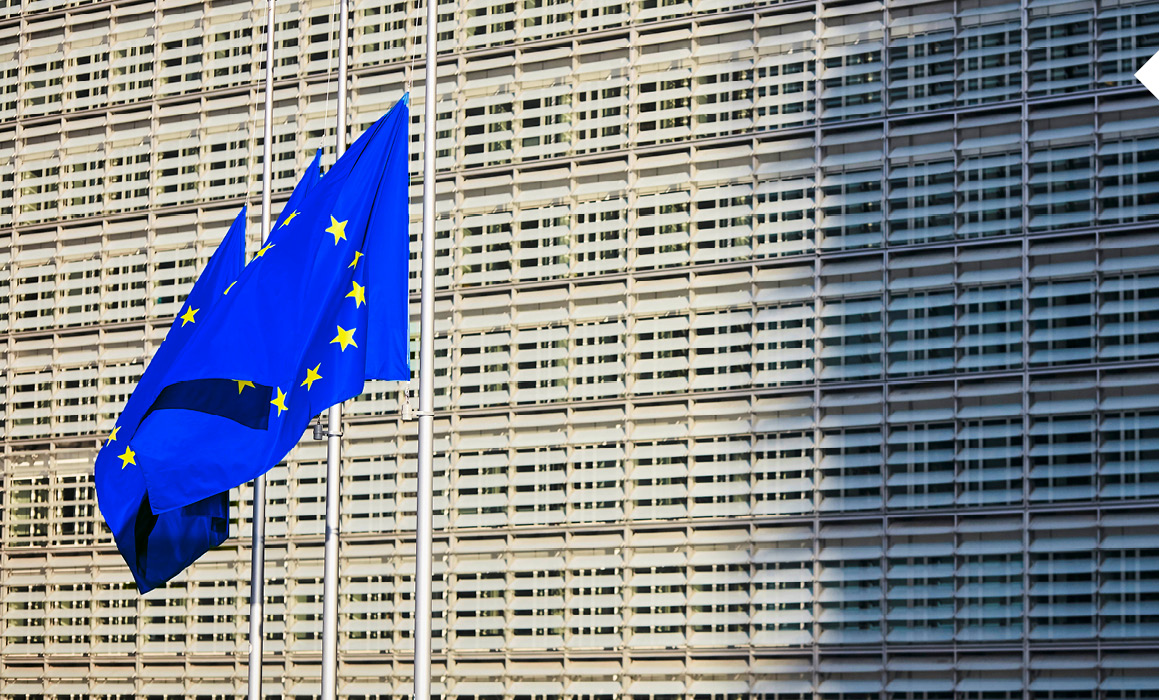
EU flags at the European Commission Berlaymont headquarters fly at half-mast after the death of the former President of France, Jacques Chirac, Brussels, Belgium, 30 September 2019.
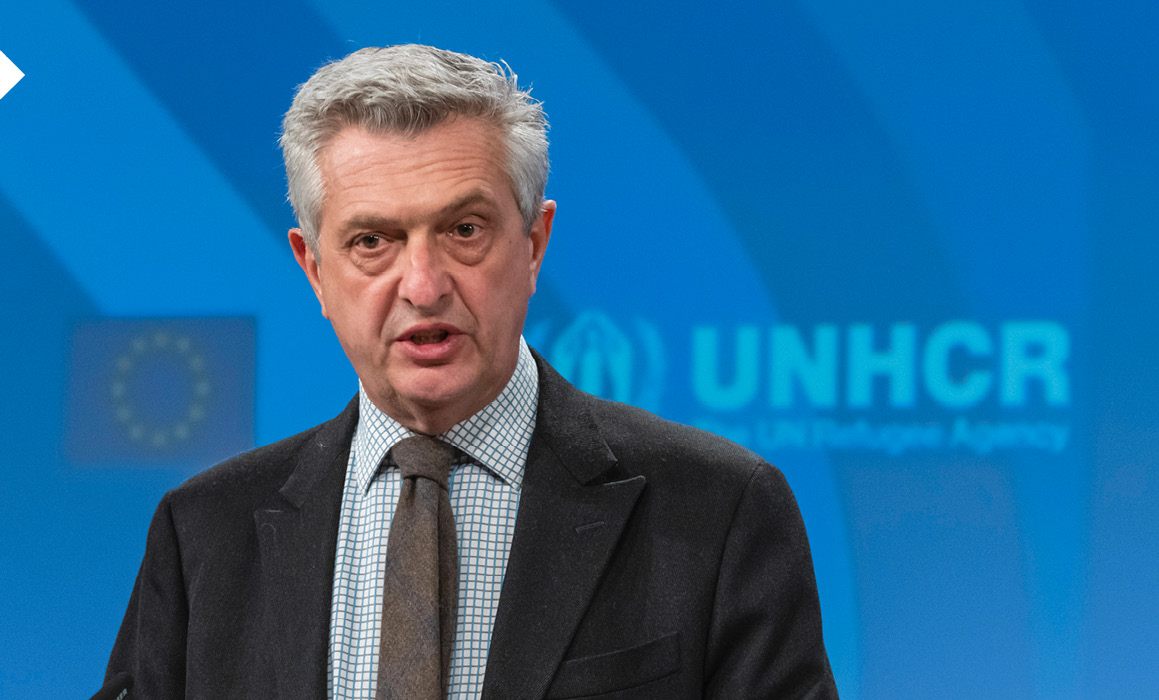
Filippo Grandi, United Nations High Commissioner for Refugees, speaks at the International Solidarity Conference on the Venezuelan Refugee and Migrant Crisis, Brussels, Belgium, 29 October 2019.

A piece of the Berlin Wall featuring US President Kennedy is photographed outside the European Commission Berlaymont building ahead of the 30th anniversary of the fall of the wall, Brussels, Belgium, 29 October 2019.
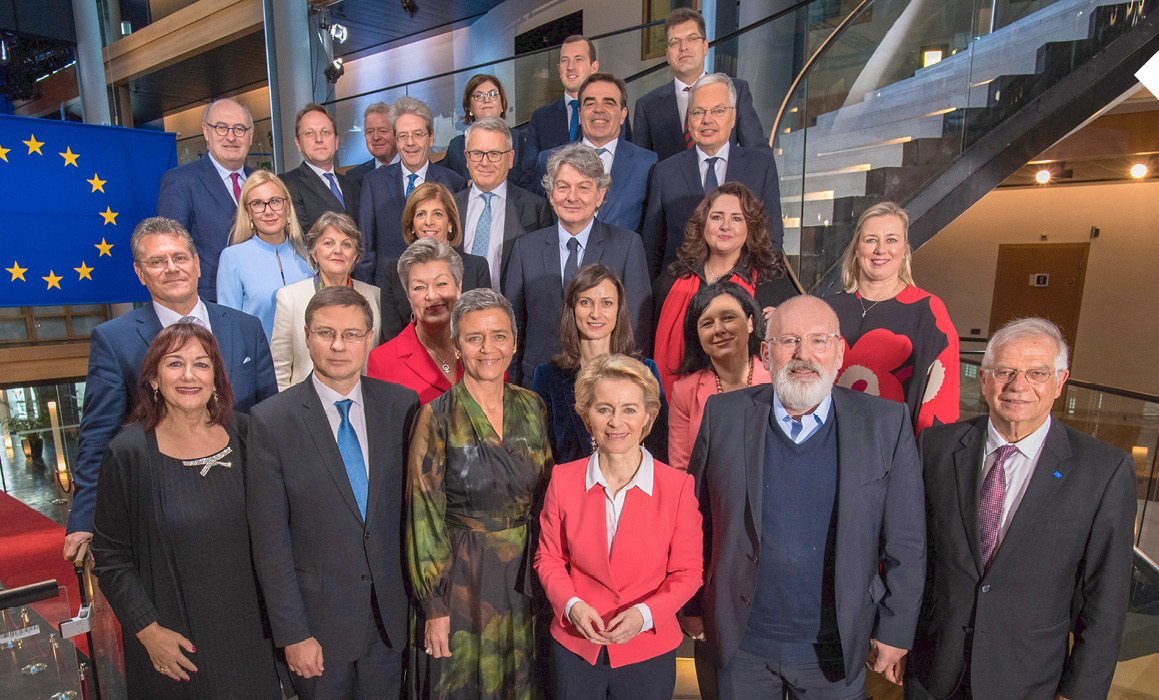
The first ‘family photo’ of the new European Commission after their approval by the European Parliament, Brussels, Belgium, 27 November 2019.
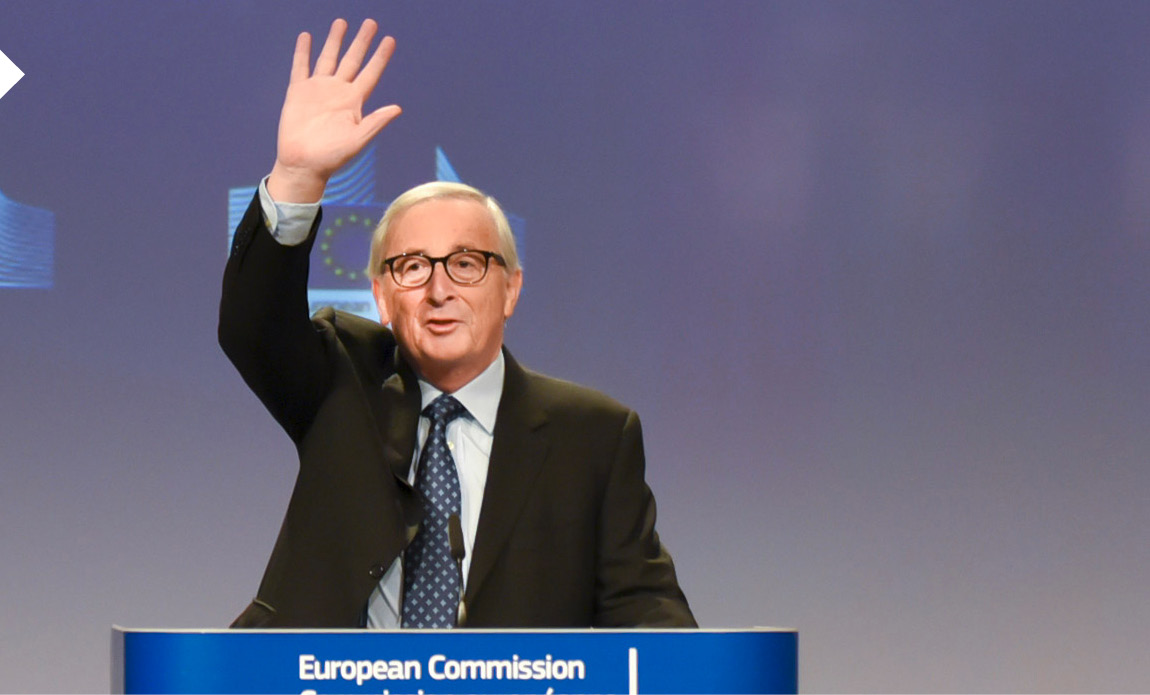
Jean-Claude Junker at his last midday press conference as President of the European Commission, Brussels, Belgium, 29 November 2019.
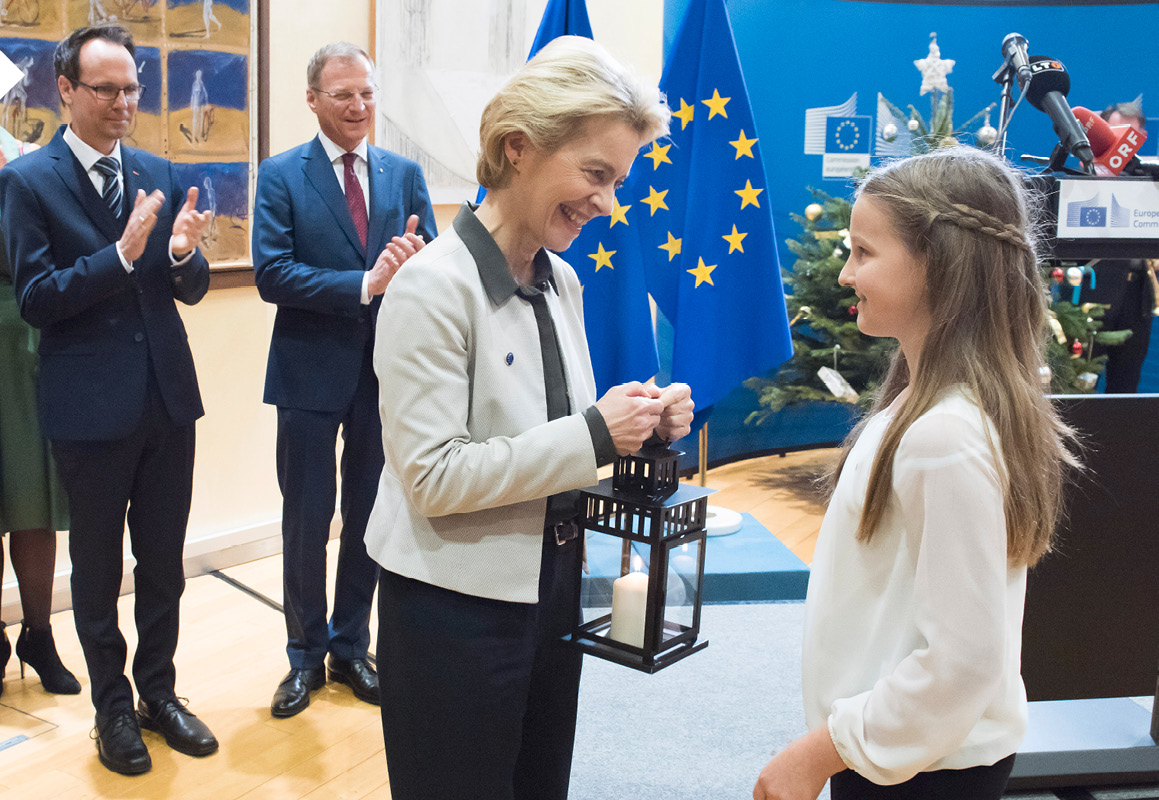
Ursula von der Leyen, President of the European Commission, receives the Christmas ‘peace light’, Brussels, Belgium, 11 December 2019.
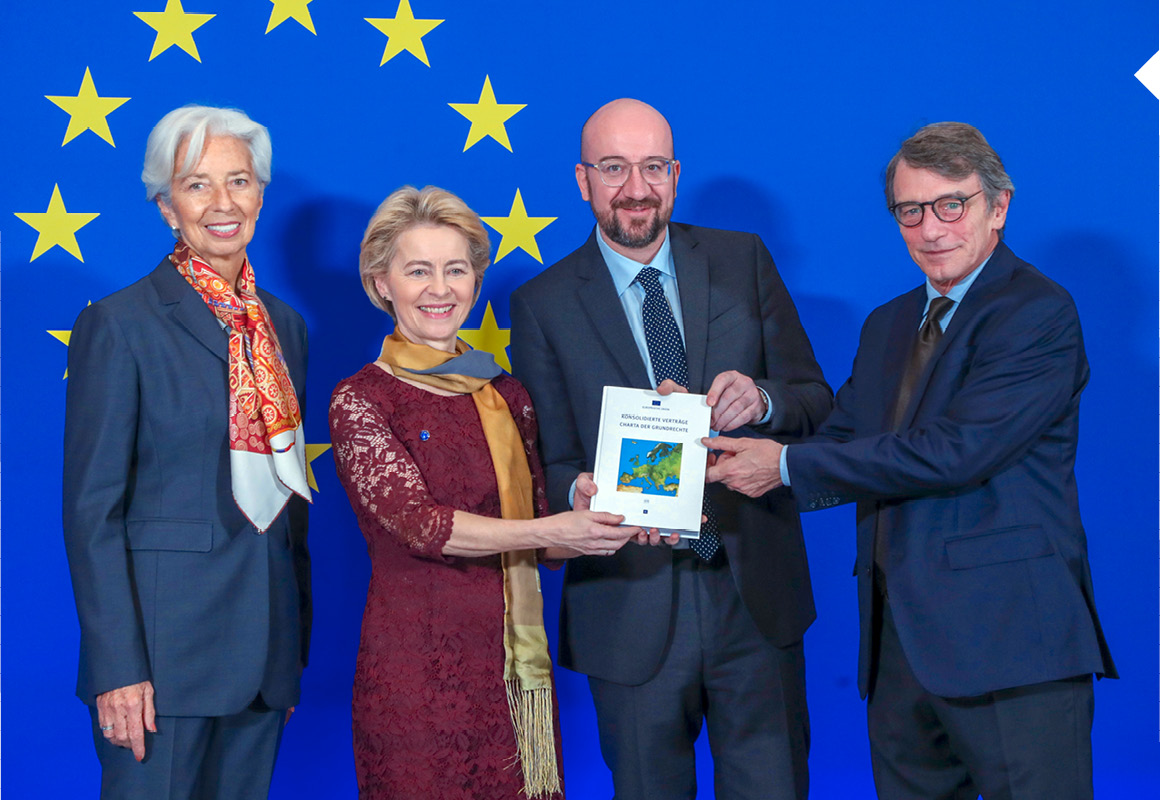
The four leaders of the institutions. Christine Lagarde, President of the European Central Bank, Ursula von der Leyen, President of the European Commission, Charles Michel, President of the European Council, and David Sassoli, President of the European Parliament, hold up a copy of the Treaty of Lisbon on the 10th anniversary of its coming into force, Strasbourg, France, 17 December 2019.
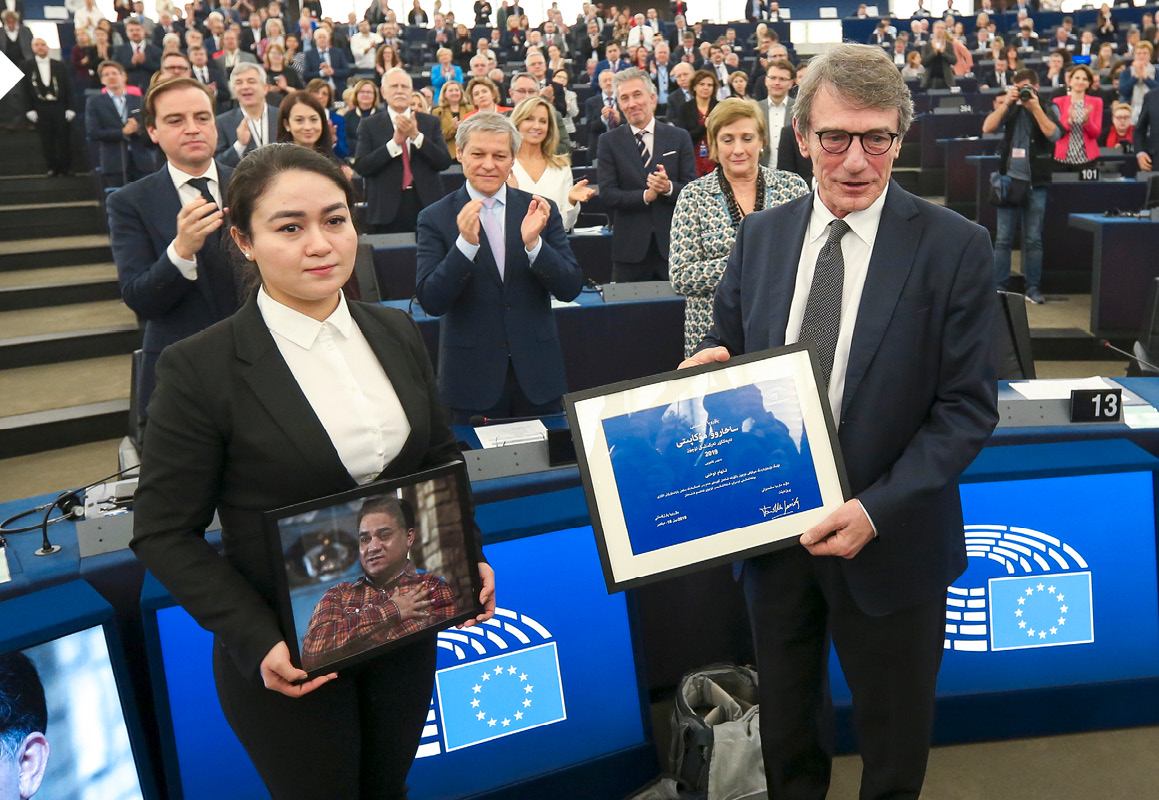
Jewher Ilham accepts the 2019 Sakharov Prize for Freedom of Thought on behalf of her jailed father, Ilham Tohti, a Uyghur scholar fighting for the rights of China’s Muslim Uyghur minority, Strasbourg, France, 18 December 2019.
Chapter 6
A balanced and progressive trade policy to harness globalisation
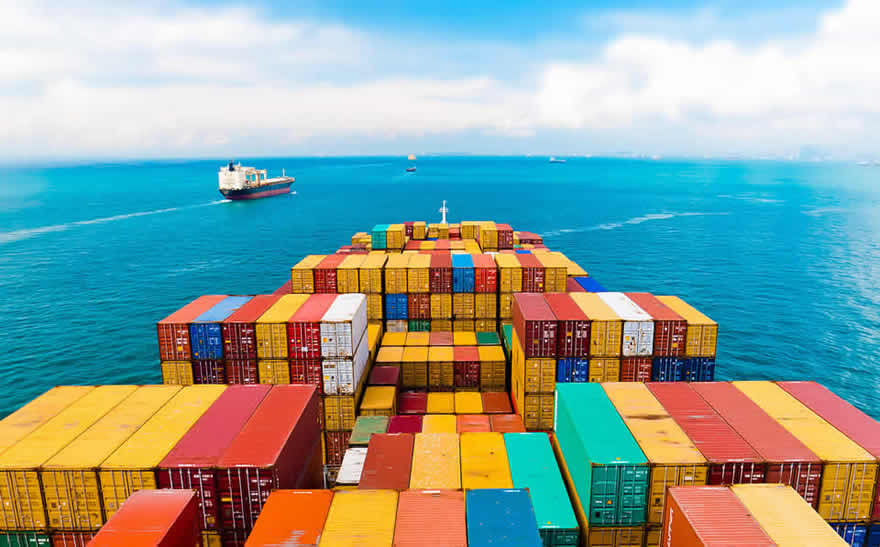
© Fotolia
In 2019, the EU reaffirmed its position as a leading trade power, remaining one of the world’s most open economies and pursuing an ambitious trade-negotiations agenda that aims to open markets and create a level playing field for EU firms around the globe. The European economy depends on trade: every €1 billion in exports supports 14 000 jobs in Europe. Openness combined with high standards remains the best way to make globalisation work for everyone in Europe.
The EU is committed to a rules-based multilateral trading system as the basis for prosperity. It continued to play a leading role in – and defending – the World Trade Organization (WTO) and proposed ideas to reform it. When others break international trade rules or engage in unfair trading practices the EU defends its businesses, workers and citizens.
The EU protected its interests in the face of protectionist tendencies and growing barriers to trade. Stronger and more effective trade defence rules came into force. The EU also set up a new framework for screening strategic investments from outside the EU.
The EU has concluded trade agreements with 72 countries around the world, accounting for 40 % of the world’s gross domestic product. In 2019, it reached a new agreement with the South American trading bloc Mercosur, signed a deal with Vietnam and saw its trade deal with Japan enter into force. An agreement was concluded with China on the protection of geographical indications. The EU also made good progress on trade negotiations, including with Australia, Chile and New Zealand.
Upholding multilateral rules
Trade policy must be effective, transparent and based on values. The fundamentals of the 2015 Trade for All strategy continued to guide the approach taken in 2019: openness combined with high standards remains the most appropriate way to make globalisation work.
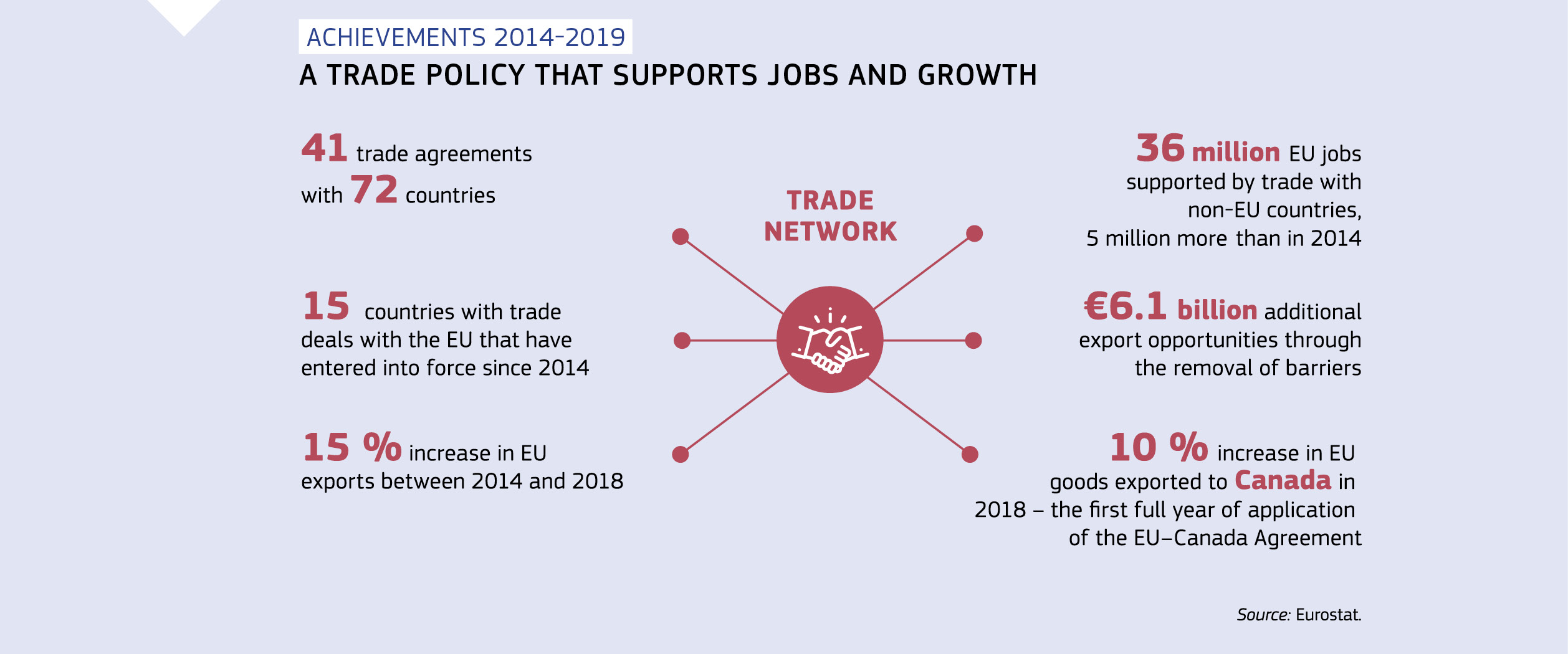
European Union trade policy is composed of a network of 41 trade agreements with 72 countries, 15 of which have trade deals with the European Union that have entered into force since 2014. These trade deals have seen a 15 % increase in European Union exports between 2014 and 2018. Trade with non-EU countries supports 36 million European Union jobs, 5 million more than in 2014. It has opened up 6.1 billion euro in additional export opportunities through the removal of trade barriers. In 2018, the first full year of application of the European Union-Canada Agreement, the European Union saw a 10 % increase in European Union goods transported to Canada. Source: Eurostat.
Challenges to the rules-based multilateral trading system, underpinned by the WTO, continued to mount in 2019. The rise of nationalism and protectionism brought an increase in unilateral measures as well as the threat of a global trading system based on strength, not fairness. Building on its initiatives of 2018, the EU made proposals to the WTO to improve transparency and to solve Member States’ concerns about specific trading practices in a more efficient manner.
The EU worked with major trading partners to strengthen rules on subsidies and forced technology transfers. To uphold the WTO’s system for resolving disputes, it made proposals to unblock pending appointments to the Appellate Body. The body no longer has a quorum, since the terms of two of the last three members expired in December, rendering it powerless to hear appeals in disputes. The European Commission reacted by proposing to amend the EU’s enforcement regulation so that if trade partners hinder effective dispute settlement resolution, the EU will be able to act resolutely to protect its interests. Based on existing WTO rules, the EU also agreed an interim appeal arbitration arrangement with Canada and Norway to preserve a binding dispute settlement system and the right to an appeal in disputes between them as and when the Appellate Body ceased to function.
A Europe that protects
When diplomatic interventions fail, the EU does not hesitate to use the WTO’s dispute settlement mechanism to enforce its rights and get the full benefits of membership for its businesses, workers and farmers. In 2019, the EU launched procedures against Turkey relating to pharmaceutical products, against India on its treatment of information and communication technology products, against the United States on its countervailing duties and anti-dumping measures on Spanish olives and against Colombia on its anti-dumping measures on frozen fries from Belgium, Germany and the Netherlands.
The EU also used its bilateral agreements for dispute settlements, starting proceedings against South Korea to defend core labour standards, against Ukraine over a wood export ban and against the Southern African Customs Union’s restrictions on poultry imports.
In line with WTO rules and EU legislation, the EU opened 15 new investigations into, and imposed seven new trade defence measures against, dumped and subsidised imports. These included electric bicycles from China and biodiesel from Argentina and Indonesia. The EU also opened six new review investigations and renewed 16 existing measures for another 5 years.
In 2019, the EU imposed definitive safeguard measures on imports of 26 categories of steel products to address the potential trade diversion of steel to the EU from other countries caused by additional tariffs in the United States. It reviewed them towards the end of the summer to adapt them to the most recent situation.
The EU also defended its industries when non-EU countries opened trade defence investigations against its exports. Examples include Turkey’s safeguard investigation regarding imports of tyres, India’s anti-dumping investigation regarding imports of coated paper and Colombia’s measures on imports of frozen fries.
In March, the WTO confirmed that in 2020 the EU would be granted retaliation rights in the trade dispute with the United States over subsidies to the aircraft manufacturer Boeing. The United States had not complied with earlier rulings on its illegal subsidies to the company, causing significant harm to its European competitor Airbus. In October, in a parallel trade dispute, the WTO granted the United States retaliation rights in the Airbus case. The United States introduced additional tariffs on a range of products from Member States. The EU remains committed to reaching a balanced negotiated settlement with the United States on the disputes.
The Commission finished adapting its trade defence procedures to the modernised anti-dumping and anti-subsidy legislation that came into force in 2018 and 2017. Similarly, it closed a loophole so that from autumn 2019 it could apply trade defence measures to goods (for example, undersea pipelines) imported into the continental shelf/exclusive economic zone of Member States. The Commission stepped up its fight against the circumvention of trade defence measures and launched related investigations into Chinese exports of corrosion-resistant steel, persulphates and ceramic tableware, imposing measures on the latter.
In April, a new regulation for the first EU-wide framework for screening foreign direct investment came into force. From October 2020, it will enable Member States and the Commission to identify and address security concerns related to specific investments from outside the EU.

Intellectual property rights are important for economic growth and crucial for the EU’s ability to stimulate innovation and stay competitive globally. The EU increased its efforts to protect and enforce such rights internationally, including by implementing cooperation programmes with China, south-east Asia and Latin America and launching a new assistance project for Africa. It also held dialogues with priority countries such as China, Thailand, Turkey and Ukraine. As part of its work on the Counterfeit and Piracy Watch List, the Commission strengthened its cooperation with the European Union Intellectual Property Office, the European Union Agency for Law Enforcement Cooperation (Europol) and the European Union Agency for Criminal Justice Cooperation and held regular dialogues with EU businesses.
Growing protectionism meant these businesses faced an increasing number of barriers to international trade. The Annual Report on Trade and Investment Barriers showed that the EU’s market access strategy was effective in tackling them.

European Union exporters face 425 trade barriers in 59 countries, with 45 new ones faced in 2018. In the same year, 35 obstacles were removed, and a total of 123 obstacles were removed during the course of the Juncker Commission. The removal of barriers between 2014 and 2017 have contributed an additional 6 billion euro in exports for European Union companies in 2018. Source: European Commission, ‘Report from the Commission to the European Parliament and the Council on trade and investment barriers – 1 January 2018-31 December 2018’, June 2019.
Throughout the year, the EU continued trilateral talks with Japan and the United States on key global trade issues, including how to level the playing field for traders by developing new multilateral rules on industrial subsidies and forced technology transfer.
As a founding member of the Alliance for Torture-Free Trade, set up in 2017, the EU continued to take a clear stand on goods used for capital punishment and torture. Further to the alliance’s 2018 commitment to push for a United Nations resolution on the issue, in June the UN General Assembly passed one aimed at abolishing trade in equipment used for torture.
A forward-looking trade policy
The EU’s trade agreements aim not only to open new markets but also to ensure that trade works for everyone. The agreements uphold EU standards for the environment, food safety, and workers’ and consumer rights and help partner countries fulfil their international obligations. For example, the EU launched capacity-building and outreach programmes worth €9 million to help developing countries address labour and environmental challenges throughout responsible supply chains in both Asia and Latin America.
The EU played a leading role in United Nations discussions on reforming how investors can settle disputes with countries. In January, it submitted a proposal to the United Nations Commission on International Trade Law to establish a multilateral court for settling such disputes, which represents a major innovation in global governance.
In September, the European Commission hosted a high-level conference in Brussels on empowering women through trade.
A transparent and inclusive negotiating process
Transparency and engagement with the public remain essential ingredients of the EU’s trade policy to ensure a democratic process, public trust and accountability. This must exist before, during and after negotiations, as well as when agreements are implemented.
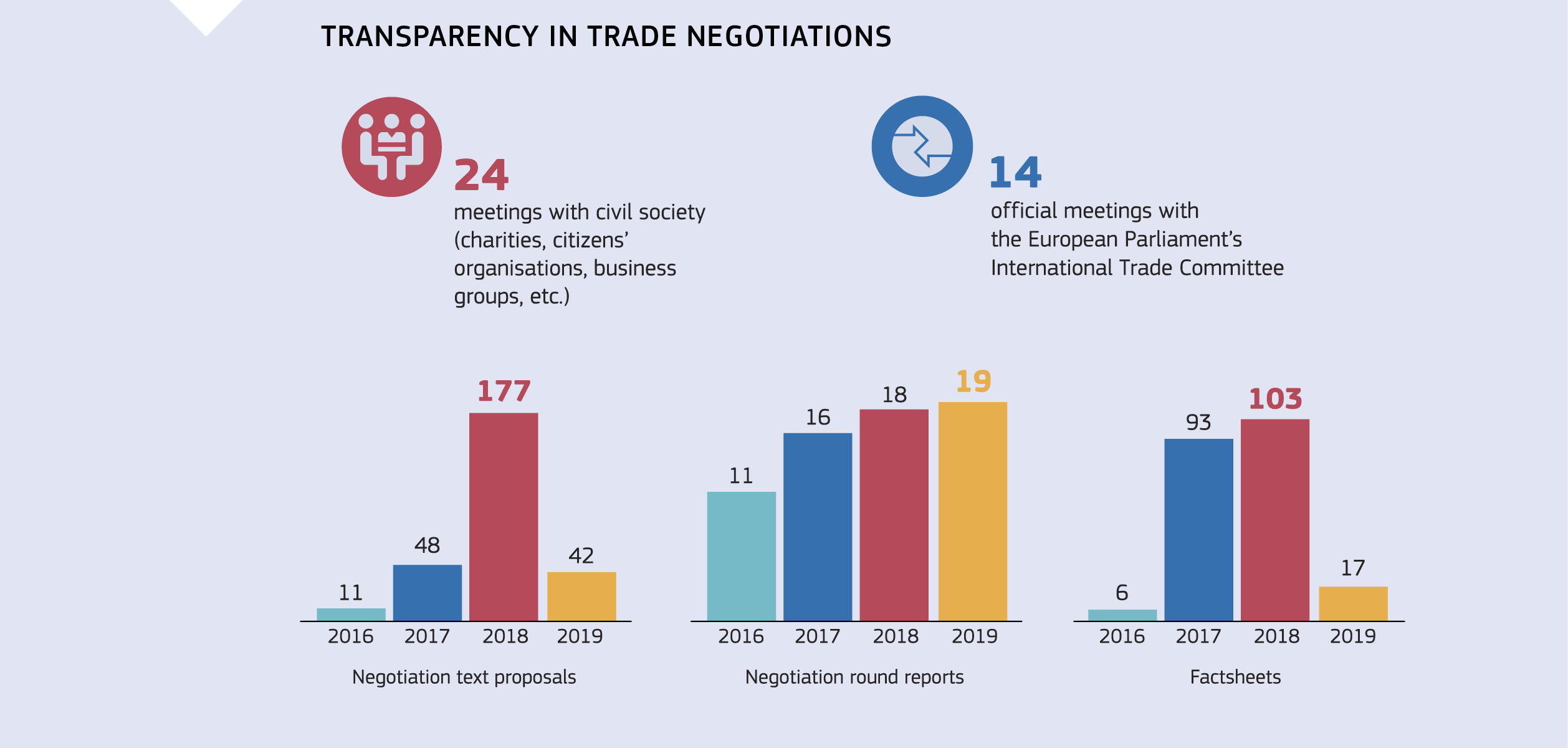
In 2019, 24 meetings were held with civil society (charities, citizens’ organisations, business groups, etc.) and 14 official meetings were held with the European Parliament’s International Trade Committee for an open dialogue on trade. The number of negotiation text proposals increased from 11 in 2016 to 48 in 2017, to a peak of 177 in 2018 and back down to 42 in 2019. The number of negotiation round reports produced increased steadily from 11 in 2016 to 16 in 2017, to 18 in 2018 and to 19 in 2019. The number of factsheets produced rose sharply, from six in 2016 to 93 in 2017, to a peak of 103 in 2018 and down to 17 in 2019.
The Commission continued to publish reports of negotiating rounds, position papers and proposals for texts in trade agreements under negotiation. It also published its third comprehensive Annual Report assessing the implementation of the EU’s trade agreements. This enabled stakeholders, civil society and other EU institutions to scrutinise how the EU is implementing its agreements and provided lessons for ongoing and future trade negotiations.

The Commission engages with 529 registered civil-society organisations through a dedicated permanent framework of Civil Society Dialogue. In 2019, over 1 000 citizens participated in 24 Civil Society Dialogue meetings, and Cecilia Malmström, the European Union Commissioner for Trade, held two Citizens’ Dialogues in Member States.
The Expert Group on Trade Agreements met six times in 2019 to discuss issues such as electronic commerce, reform of the WTO and implementation of trade agreements. Made up of 28 organisations representing businesses, trade unions, consumers and environmental bodies, the group aims to foster dialogue and gather views from a wide range of stakeholders.
The EU–Mercosur Trade Agreement
In June, the EU reached a political agreement on a comprehensive trade agreement with Mercosur comprising Argentina, Brazil, Paraguay and Uruguay.
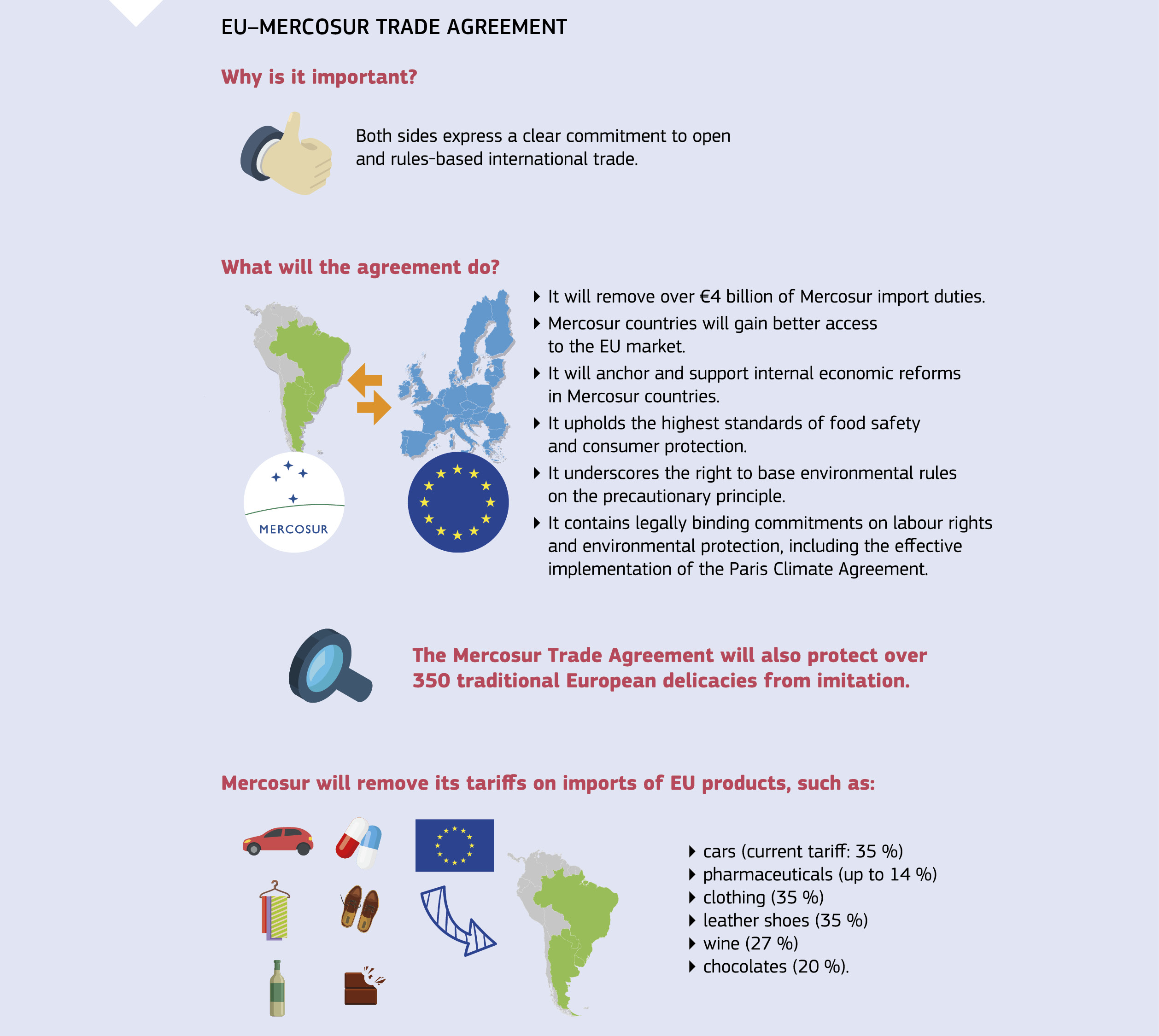
The European Union‒Mercosur trade agreement is important as both sides express a clear commitment to open and rules-based international trade. The agreement will remove over 4 billion euro of Mercosur import duties, and Mercosur countries will gain better access to the European Union market. It will also anchor and support internal economic reforms in Mercosur countries while upholding the highest standards of food safety and consumer protection. It underscores the right to base environmental rules on the precautionary principle, and contains legally binding commitments on labour rights and environmental protection, including on the effective implementation of the Paris Agreement on climate change. The European Union‒Mercosur Trade Agreement will protect over 350 traditional European delicacies from imitation. It will also ensure the removal of tariffs on imports of EU products, such as cars (current tariff 35 %), pharmaceuticals (tariffs up to 14 %), clothing (35 %), leather shoes (35 %), wine (27 %) and chocolates (20 %). Source: European Commission
As part of the wider Association Agreement between the two blocs, the new agreement will cement the close political and economic relations between them and create a market of 780 million people. The EU is Mercosur’s largest trade and investment partner and the first to strike a comprehensive trade deal with it.
Once in force, the agreement will cut tariffs, increase business opportunities, widen consumer choice, cut red tape, boost growth and competitiveness, promote shared values like sustainable development and create jobs. It will also promote high labour and environmental standards. In addition, the EU and Mercosur have committed themselves to effectively implement the Paris Agreement on climate change.
The Economic Partnership Agreement with Japan
On 1 February 2019, the EU–Japan Economic Partnership Agreement signed in July 2018 entered into force, creating an open trading zone covering more than 570 million people. It removes nearly all of the €1 billion in Japanese import duties paid every year by EU companies exporting to Japan as well as a number of long-standing regulatory barriers.
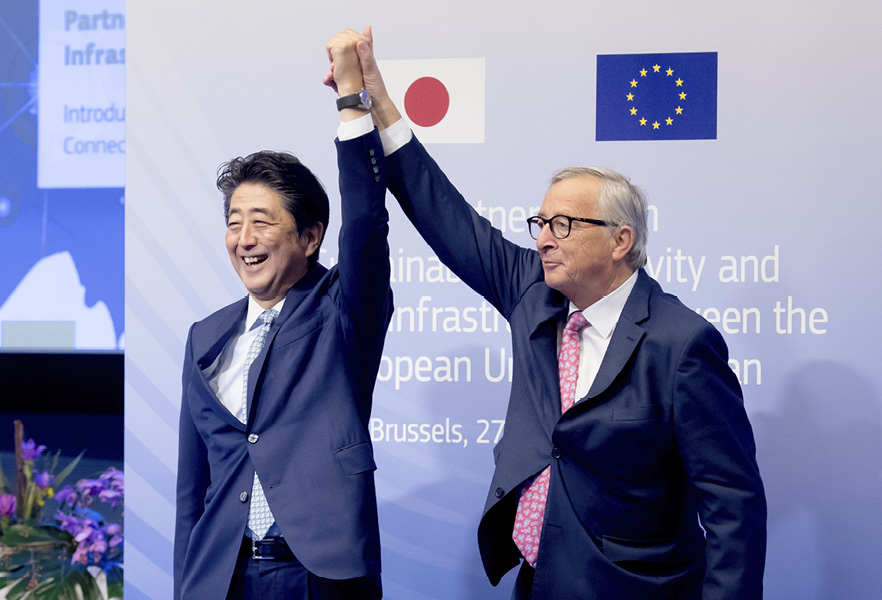
Shinzō Abe, Prime Minister of Japan, and Jean-Claude Juncker, President of the European Commission, at the EU–Asia Connectivity Forum, Brussels, Belgium, 27 September 2019.
The agreement increases EU exports, creates new opportunities for European companies, such as making it easier for them to access Japanese public procurement markets, brings more choice for consumers and contributes to their joint efforts to shape global trade rules. It is the first EU trade agreement to include a specific commitment to comply with the Paris Agreement. Throughout the year, the EU continued negotiations with Japan on investment protection standards and dispute resolution.
Asia and Australasia
On 30 June, the EU and Vietnam signed agreements on free trade and investment protection, marking a milestone in their partnership. The agreements are the most ambitious ever to be negotiated between the EU and an emerging economy. Pending ratification, the free trade agreement could enter into force in mid 2020, while the EU–Singapore Free Trade Agreement entered into force on 21 November.
The agreements with these two countries further reinforce the EU’s engagement with the region. It also held three rounds of negotiations for a trade agreement with Indonesia. Three rounds of talks were held in the negotiations for trade agreements with Australia and four with New Zealand.
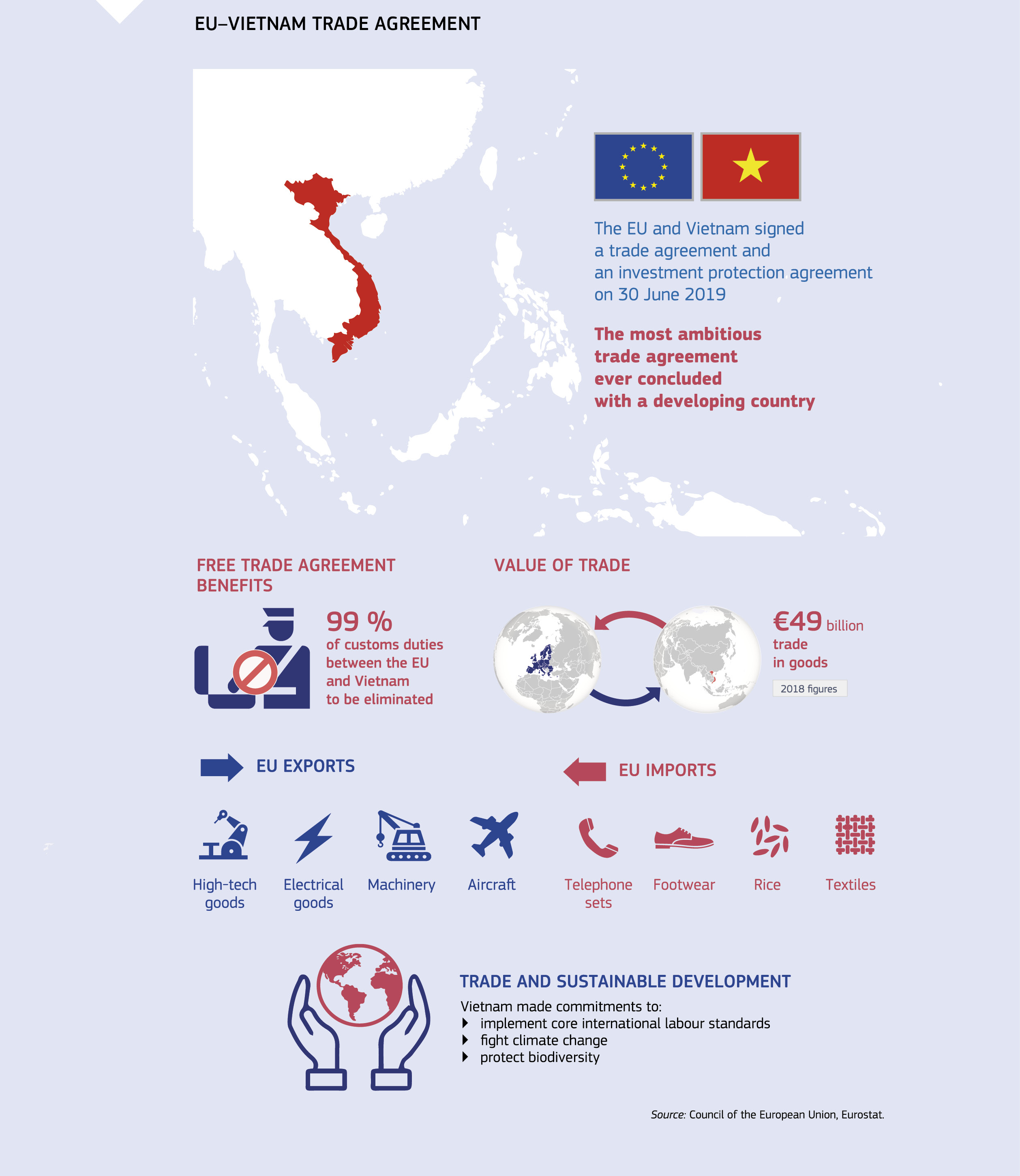
The European Union and Vietnam signed a free trade agreement and an investment protection agreement on 30 June 2019. It is the most ambitious free trade agreement ever concluded with a developing country. It will bring the removal of 99 % of customs duties between the European Union and Vietnam. In 2018, trade in goods between the EU and Vietnam amounted to 49 billion euro. The European Union will export high-tech and electrical goods, machinery and aircraft, and will import telephone sets, footwear, rice and textiles. The deal also considers a sustainable development, as Vietnam has made commitments to implement core international labour standards, fight climate change and protect biodiversity. Source: Council of the European Union.

Singapore is the European Union’s first commercial partner in south-east Asia. The trade and investment agreements concluded will set the benchmark for European Union cooperation with the other countries in the region. The main areas covered by these deals are labelling and safety testing, intellectual property, renewable energy, smaller companies, public procurement, environment and labour. They will generate a total value of bilateral trade of 58.1 billion euro, and 21.1 billion euro in European exports. The European Union will export cars and machinery and import chemicals and pharmaceuticals. Concerning trade in services, the total value of bilateral trade will be 44.4 billion euro. Around 10 000 European Union companies already use Singapore as a regional hub. The value of European Union bilateral investments came to 255.5 billion euro in 2016, with a 25 % increase in total bilateral investments between 2014 and 2015. Other benefits of the new European Union‒Singapore deal are the elimination of all Singaporean tariffs on European Union exports and most European Union tariffs for Singaporean products, as well as the removal of non-tariff barriers in areas such as electronics, where Singapore will recognise European Union standards. The deal will also help to protect people’s rights at work and introduce an EU-wide investment protection agreement. Source: Council of the European Union.
United States
The focus with the United States continued to be on developing a positive trade agenda, addressing issues of common interest and avoiding trade disputes. This was based on the joint statement issued by the Commission President Jean-Claude Juncker and the US President Donald Trump in 2018, which established an Executive Working Group to facilitate trade and develop a positive transatlantic trade agenda.

The United States is the European Union’s largest export market for goods. In 2018, it accounted for 407 billion euro and 21 % of total European Union goods exports. Source: Eurostat.
In 2019, the group focused on regulatory issues. In April, the Council mandated the Commission to negotiate with the United States on industrial tariffs and conformity assessment.
In July, the Commission published a progress report on the joint statement’s implementation, showing positive results, particularly in sectors such as energy, soybeans, pharmaceuticals, cybersecurity and medical devices. In 2019, EU imports of liquefied natural gas from the United States reached the highest volume ever, making its energy supply more diverse and secure. Further work focused on conformity assessment, standards for new and emerging technologies and continuing progress in specific sectors. While this work continues, both sides agreed not to introduce new tariffs on their trade.
In July, the EU agreed to increase the United States’ share of its import quota for hormone-free beef. In return, the United States accepted not to reinstate action against the EU in the Section 301 investigation of EU measures concerning meat and meat products. The agreement for mutual recognition of inspections of manufacturing sites for human medicines also came into force.
China
The EU–China summit in April resulted in several joint commitments. China agreed to dismantle various trade barriers and undertook to conclude an agreement to protect geographical indications (the names of traditional European food and drink products) and to complete comprehensive negotiations on investment by 2020.

The European Union‒China Geographical Indications Agreement is a landmark treaty between the European Union and China. It is a concrete example of cooperation between two parties and reflects openness and adherence to international rules as a basis for trade relations. 100 European Union geographical indications are protected in China and 100 Chinese geographical indications are protected in the European Union. The European Union list of geographical indications to be protected in China includes products such as Mozzarella di Bufala Campana, Languedoc, Elia Kalamatas and Münchener Bier. Among the Chinese products, the list includes Wuyuan Lü Cha (Wuyuan green tea), Chaidamu Gou Qi (Chaidamu goji berry), Panjin Da Mi (Panjin rice) and Wuchuan Yue Bing (Wuchuan mooncake). China has a market of 1.4 billion consumers and is the second-largest destination for exports of European Union agri-food products, reaching 13.5 billion euro in trade between November 2018 and October 2019. This represented an increase of 27.2 % in 1 year. The Chinese market is a high-growth potential market for European food and drinks, with a growing middle class with a taste for iconic European products. It also has a well-established geographical indication system of its own, waiting to be further discovered by European Union consumers thanks to this agreement. Following the conclusion of negotiations, the agreement will now go through legal scrutiny. On the European Union side, the European Parliament and the Council will be asked to give their approval. The agreement is expected to enter into force before the end of 2020. Four years after its entry into force, the scope of the agreement will expand to cover an additional 175 geographical indications names from both sides. These names will have to follow the same registration procedure as the 100 names already covered by the agreement. Source: Eurostat.
In November, negotiations on the protection of these indications concluded after 9 years. This agreement should provide a high level of protection for 200 names when it enters into force, and for a further 175 names within 4 years from then. China is the EU’s second-largest market for agri-food products and a growing market for products with a specific geographical indication.
The EU and China held six rounds of talks for an investment agreement and continued to work on WTO reform.

The European Union is China’s biggest trading partner, while China is the European Union’s second-largest trading partner. Trade in goods between the European Union and China was worth 1.7 billion euro per day in 2018. In 2018, the European Union exported 211 billion euro worth of goods to China and imported 395 billion euro worth of goods. The European Union exported 51 billion euro worth of services to China, while China exported 30 billion euro worth of services to the European Union. The European Union is currently negotiating with China a comprehensive agreement on investment. This agreement should create a more level playing field for business and new market opportunities for both sides. It should also encourage China to advance its economic reforms and give the market a more decisive role. This will pave the way for broader trade ambitions when the conditions are right. Source: Eurostat.
Southern and eastern neighbourhoods
The EU–Morocco Association Agreement was amended to include the people of Western Sahara, paving the way for restarting talks on deepening the EU–Morocco trade agreement. In May, negotiations for a Deep and Comprehensive Free Trade Area with Tunisia were suspended due to the country’s political situation.
The EU held bilateral discussions on trade and investment with some of the Gulf Cooperation Council countries. Improvements negotiated with Jordan in the Rules of Origin scheme to support employment of Syrian refugees came into effect in early 2019.
With its Deep and Comprehensive Free Trade Areas with Georgia, Moldova and Ukraine, the EU’s focus was on implementation. It also reached an agreement with Ukraine to limit its poultry exports to the EU. On 6 July, the EU initialled an Enhanced Partnership and Cooperation Agreement with Kyrgyzstan, which includes important trade chapters.
Latin America
In 2019, work continued with Mexico towards signature and conclusion of the Modernised Global Agreement. The EU and Chile held three rounds of negotiations to update their 2002 trade agreement. The aim is to agree an ambitious, balanced and progressive agreement that will further liberalise trade and investment, promote EU values and take up issues like trade and gender. Provisions for the latter will strengthen the understanding of the constraints and opportunities faced by women in international trade and share best practices aimed at making it easier for them to participate.

French wine in a Mexico City supermarket selling European products. The modernised EU–Mexico Global Agreement will liberalise 99 % of trade between the two parties.
In June, as part of the implementation of trade agreements, the EU–Central America Association Committee held its fifth meeting and, in October, the trade committee grouping the EU and Colombia, Ecuador and Peru met.
African, Caribbean and Pacific countries
Economic Partnership Agreements are trade and development agreements between the EU and African, Caribbean and Pacific countries and regions. They are currently provisionally in force with 31 of them. The agreements can be seen as building blocks towards a future continent-to-continent free-trade area, one of the long-term aims of the new Africa–Europe Alliance for Sustainable Investment and Jobs, which supports African efforts towards a continental free-trade area. In February, Comoros joined the Eastern and Southern Africa agreement and, in October, the EU launched talks with the five countries that are implementing the current agreement to broaden it beyond tariff cuts in order to tackle other trade and investment barriers and create opportunities. The EU also discussed trade and investment as part of ongoing negotiations for a framework agreement to replace the Cotonou Agreement.
Chapter 7
An area of justice and fundamental rights based on mutual trust

© Fotolia
Democracy can only thrive in our society if we have independent courts that guarantee the protection of fundamental rights and civil liberties, an active civil society and free media that ensure pluralism. In 2019, the Commission decided on a series of measures to strengthen the rule of law in the European Union through its better promotion, prevention of threats and response to breaches.
Modernised EU laws reinforce consumer protection by targeting misleading marketing practices, introducing effective penalty rules and providing remedies to victims of unfair practices.
New protections for whistle-blowers strengthen the enforcement of EU rules where breaches would entail serious harm to the public interest. The EU is taking a strong stance by protecting those who take a risk in speaking out to reveal violations of EU law. These rules also protect freedom of expression and media freedom since whistle-blowers are crucial sources for investigative journalists.
The 2019 elections to the European Parliament saw the highest turnout (50.7 %) since 1994. A coordinated approach by Member States and the EU institutions, including the implementation of the Commission’s election package, helped protect the world’s second-largest democratic elections from manipulation and interference.
Strengthening the rule of law
The rule of law is one of the common values upon which the European Union is founded; upholding it is a shared responsibility of all Member States and EU institutions.
Observance of the rule of law is essential for the functioning of the EU in all areas. This ranges from the internal market to cooperation in justice and home affairs. Upholding the rule of law also means ensuring that national judges, who are also EU judges, can fulfil their role when dealing with matters concerning the application of EU law.
In April, the Commission launched a stocktaking exercise looking at the available tools to monitor, assess and protect the rule of law in the Union. It looked back at the experience of the past years and called for a wider European debate on how it could be further strengthened. Past experience pointed to the need for better promotion of the rule of law, early prevention of risks or breaches and an effective response when these occur.
In July, the Commission adopted a second communication setting out its own proposals in the three areas of promotion, prevention and response.
Concerning the first area (promotion), the Commission will strengthen its communication on the rule of law to the general public, reinforce cooperation with the Council of Europe and other international organisations and provide funding for stakeholders, including civil society, that promote a common rule of law culture.
For the second area (prevention), the Commission will establish an annual rule of law review cycle to monitor the situation in all Member States. To support this process, it will prepare an annual Rule of Law Report, further develop the EU Justice Scoreboard and strengthen the dialogue with other EU institutions, Member States and stakeholders.
For the third area (response), the Commission will pursue a strategic approach to infringement procedures, building on the developing case-law of the Court of Justice of the European Union.

The goal of the rule of law framework is to address systemic threats to the rule of law through a multi-stage dialogue between the Commission and the Member States concerned. It operates through a Commission assessment followed by a Commission opinion and recommendation and a monitoring process of the follow-up to the Commission’s recommendation. Article 7 of the Treaty on European Union is an exceptional and last-resort measure to prevent or resolve a serious breach of the rule of law in a Member State. The mechanism is activated by the Parliament, the Commission or one third of the Member States, followed by a determination by the European Council of a breach of Article 2 values. This decision comes with the possibility of far-reaching sanctions, including the suspension of voting rights in the Council. Infringement procedures aim to ensure that European Union law is correctly implemented and respected at national level. Infringement procedures are a three-stage process between the Commission and the Member State, at the end of which the Commission can refer the matter to the Court of Justice of the European Union.
The Commission has also called for the swift adoption of the proposal presented in the context of the Multiannual Financial Framework on the protection of the EU’s budget in case generalised rule of law deficiencies pose a risk to EU financial interests.
The Commission pursued several infringement proceedings related to the rule of law. On 24 June and 5 November 2019, the Court of Justice issued final rulings in infringement proceedings initiated by the Commission against Poland, confirming that the Polish legislation concerning the lowering of the retirement age of Supreme Court judges and of ordinary court judges is in violation of EU law regarding judicial independence. Moreover, on 10 October 2019, the Commission decided to refer Poland to the Court of Justice in infringement proceedings concerning the new disciplinary regime for judges, as this regime undermines judicial independence by not offering the necessary guarantees to protect Polish judges from political control.
In the context of the European Semester and based on a Commission proposal, the Council issued country-specific recommendations on the functioning of the justice system to Croatia, Italy, Cyprus, Hungary, Malta, Portugal and Slovakia.
Protecting rights and fighting discrimination
Ensuring the rights of persons with disabilities
The European Accessibility Act was adopted in April and ensures that certain products and services such as mobile phones, computers, e-books, e-commerce, transport websites and consumer banking services will be accessible for persons with disabilities.
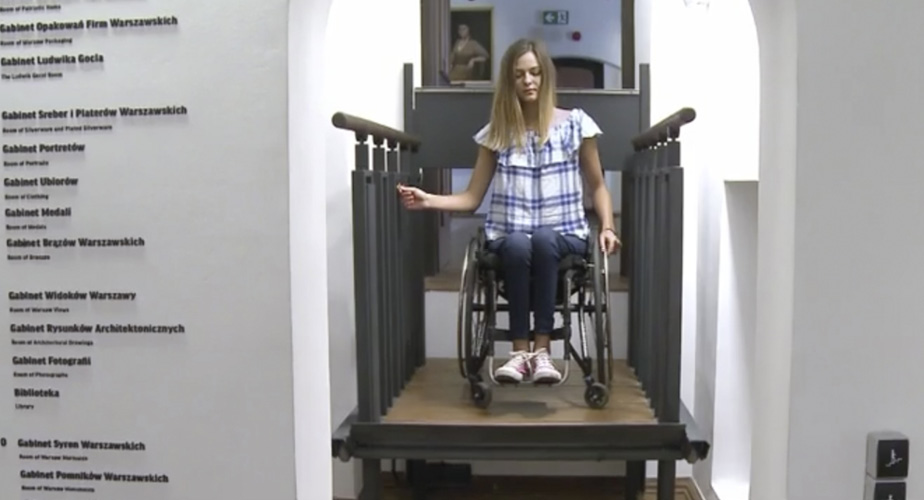
In December, Warsaw won the 2020 Access City Award, which recognises a city’s willingness, ability and efforts to become more accessible.© European Union, 2019
An awareness-raising campaign, ‘How the EU helps fight discrimination at work’, informing people and companies about their rights and obligations, was launched by the Commission in May.
Protecting whistle-blowers
In October, EU-wide standards were adopted to guarantee a high level of protection for whistle-blowers who report violations of EU rules. The directive covers a broad range of key areas such as public procurement; product, food and transport safety; environmental protection; public health; and nuclear safety. The new rules establish channels for confidential reporting, both within private and public organisations and to public authorities, and will protect employees against dismissal and other forms of retaliation.
Fighting disinformation, hate crime and hate speech
In January, the fourth evaluation of the EU Code of Conduct on countering illegal hate speech online signed in 2016 with major IT companies showed that the initiative continues to deliver positive results. IT companies review 89 % of the flagged content within 24 hours and remove it in 72 % of the cases, compared to 40 % and 28 %, respectively, when the code was first launched in 2016. The evaluation also showed the areas where companies need to improve their feedback to users.
Ahead of the European elections, the Commission published monthly reports by Facebook, Google and Twitter that showed some progress as regards the scrutiny of advertisement placement, transparency of political advertising, closure of fake accounts and marking systems for automated bots. However, signatories need to intensify their efforts, in particular with a view to developing tools to increase the transparency and trustworthiness of websites hosting ads.

In the first round of monitoring in December 2016, the rate of notifications reviewed within the first 24 hours reached 60 % for YouTube, 50 % for Facebook, and 20 % for Twitter. In the second round of monitoring in May 2017, the rate of notifications reviewed within the first 24 hours reached 40 % for YouTube, just under 60 % for Facebook, and just under 40 % for Twitter. In the third round of monitoring in December 2017, the rate of notifications reviewed within the first 24 hours reached 60 % for YouTube, just under 90 % for Facebook, and 80 % for Twitter. In the fourth round of monitoring in December 2018, the rate of notifications reviewed within the first 24 hours reached 80 % for YouTube, over 90 % for Facebook, and just under 90 % for Twitter. Instagram and Google+ were first monitored in this round, where in the notifications reviewed within the first 24 hours they registered just under 80 % and 60 %, respectively. The average rate of notifications reviewed has continuously grown, from 40 % in December 2016, 50 % in May 2017 and 80 % in December 2017, to almost 90 % in December 2018.

The European Union has a joint and coordinated action against disinformation. It started with the launch of the European External Action Service East StratCom Task Force in March 2015, followed by the creation of a joint framework on countering hybrid threats in April 2016. In spring 2018, a Communication on tackling online disinformation: a European approach was released, followed by a Package of measures to secure free and fair European elections and a Code of practice against disinformation in September 2018 and the launch of the Observatory for Social Media Analysis in November of the same year. An action plan against disinformation was released the following month. In January 2019, the inaugural meeting of the European cooperation network on elections was held and, between then and May 2019, reporting by the online platforms was conducted. In March 2019, the European Media Literacy Week was held and the Rapid Alert System was set up. In May 2019, the European Commission contributed to the informal EU-27 (all Member States except for the United Kingdom) leaders’ meeting in Sibiu.
Stronger protection of personal data
In the first year after the launch of the General Data Protection Regulation (GDPR), the Commission’s priority was to ensure its proper application. The Commission concluded in a July report that most Member States had set up the necessary legal framework and it will monitor how they comply with the GDPR and limit the fragmentation of the data-protection framework.
Businesses are developing a compliance culture, while citizens have become more conscious of the importance of data protection and of their rights and are increasingly exercising them. At the same time, convergence towards high data-protection standards is progressing at international level.

Wojciech Wiewiórowski was appointed European Data Protection Supervisor in December 2019 for a term of 5 years.
An example of the benefits brought by this global convergence is the EU–Japan mutual adequacy arrangement that entered into force in February, creating the world’s largest area of safe and free data flows. Europeans will benefit from high privacy standards when their data are transferred to Japan, and EU companies will benefit from privileged access to the Japanese market.
The Commission is also monitoring the transposition of the data-protection law-enforcement directive into Member State national law and as a result has launched several infringement procedures against Member States.
Equality
The new directive on work–life balance adopted in June will encourage equal sharing of caring responsibilities between women and men. See Chapter 5 for more information.
The Commission continued to raise awareness of the rights of lesbian, gay, bisexual, transgender and intersex (LGBTI) persons. The latest annual report on advancing LGBTI equality, published in March, provides an overview of the Commission’s set of measures to combat discrimination.

The EU’s European External Action Service building lit with the colours of the rainbow flag to mark the International Day against Homophobia, Transphobia and Biphobia, Brussels, Belgium, 16 May 2019.
The Commission advanced the preparation of the EU Framework for National Roma Integration Strategies after 2020. This framework is essential for the development of EU and national instruments and structures aiming to promote the inclusion of Roma people.
European Union citizenship
In January, the Commission published a report on ‘golden passport’ schemes, operated by certain Member States. These investor citizenship and residence schemes allow a person to obtain the nationality or residence permit of a Member State by making an investment and without proving a genuine link to that Member State. This affects citizenship of the EU. Member States generally make such a link a condition for national citizenship and on this basis have accepted that EU citizenship accrues automatically to anyone who becomes a citizen of a Member State.
The Commission’s report identified the risks that the investor citizenship and residence schemes pose to the EU, specifically in terms of security, money laundering, tax evasion and corruption, and expressed concerns that the measures taken by Member States are not always enough to mitigate such risks. The Commission set up a group of experts from Member States to examine the risks arising from the schemes and address the issues of transparency and good governance, and will continue to monitor the compliance of these schemes with EU law. Refer to Chapter 8 for more information.
As part of broad efforts to protect the 2019 European Parliament elections, the Commission supported Member States in establishing and organising meetings of a European cooperation network on elections. This network brings together representatives of Member State authorities responsible for electoral matters and enables practical exchanges on issues relevant to free and fair elections including data protection, cybersecurity, transparency and awareness raising. It will continue to address potential risks, identify solutions and contribute to building more resilient electoral and democratic systems across the EU.

More secure national identity cards requires all cards to have a contactless chip and be made of solid plastic instead of paper. The highly secure chip must include a facial image and two fingerprints, which is the most reliable way to verify the identity of a person and the authenticity of a travel document. There will be increased protection for citizens against falsification, copy, fraud and misuse of their documents. Easier checks will result in faster and more efficient border controls, for example in airports. New identity cards will be valid for a maximum of 10 years to take into account changes to facial images and future security developments. Identity cards issued to people aged 70 and above may be valid for more than 10 years. Old and insufficiently secure identity cards currently in use will have to be replaced to eliminate security gaps.
In June, as part of its actions to facilitate exercising the right to move and reside freely within the Union, the EU adopted a regulation on the security of identity cards and residence documents. The new rules define minimum common standards for EU citizens’ identity cards and non-EU family members’ residence cards as well as minimum content for the residence documents of EU citizens. This will make these documents more secure and reliable and will increase trust and acceptance, allowing citizens to travel more easily throughout the EU, reducing obstacles to exercising the right of free movement and closing loopholes that terrorists and other criminals might seek to exploit.
With a view to strengthening the right of EU citizens to consular protection in non-EU countries where their own Member State is not represented, new rules were adopted to create a modern EU emergency travel document. These rules will ensure that EU citizens can quickly receive this secure and widely accepted document from any Member State, allowing them to return home safely.
Protecting consumers
In July, to increase awareness of protection against unfair terms in consumer contracts, such as undue limitation of consumers’ legal rights and unilateral changes, the Commission issued guidance on the application of the unfair contract terms directive.
In November, the directive on better enforcement and modernisation of EU consumer protection rules was adopted as part of the New Deal for Consumers proposed by the Commission in April 2018. It adapts consumer rights to new technologies by introducing important new online requirements. These include prohibiting hidden advertising in search results and ‘fake’ consumer reviews; providing information about the identity of the counterpart on online platforms (private consumer or professional retailer); and providing information about the parameters used in ranking and the personalisation of prices by automated decision-making.
The new rules also set deterrent fines for ‘widespread infringements’ of consumer rights subject to coordinated actions under the consumer protection cooperation regulation. A separate proposal for a European system of collective redress when groups of consumers have suffered harm is still under negotiation between the Parliament and the Council.
Following negotiations with the Commission and national consumer protection authorities, the platform Airbnb brought its sales practices and conditions into full compliance with EU consumer protection rules. For instance, the final price and whether a property is offered by an individual or a professional are now clearly presented on the results pages.
Following a call from the Commission and EU consumer authorities, five industry leaders – Avis, Europcar, Enterprise, Hertz and Sixt – have changed the way they present car rental prices, making them fully transparent to consumers.
In the aftermath of the Cambridge Analytica scandal and after a long dialogue with the Commission and EU consumer authorities, Facebook modified its terms of service. They now explain more clearly how the company uses its users’ data to develop profiling activities and target advertising, as a source of its revenue and to acknowledge the company’s responsibility in case of negligence.
The EU facilitates online shopping by enabling consumers to make informed decisions and buy safely. The awareness campaign #YourEURight was launched in 2019 to remind consumers that they have significant rights when buying from any online store selling to European consumers.
New rules were adopted to better tackle dual quality of consumer goods. In parallel, the Commission worked on clarifying when the sale of dual-quality products (goods sold across Europe with different compositions in identical or similar packaging) constitutes an illegal commercial practice, developing a common methodology and publishing the results of an EU-wide testing campaign in June 2019 that compared several food products from different Member States. This showed that while almost a third of tested food products had an identical or similar presentation but different composition, no specific geographic pattern could be identified. The results do not reach a conclusion on whether the differences affect quality or whether they are associated with a misleading practice in individual cases.
Following the adoption of guidelines to help national authorities apply EU consumer and food legislation with regard to dual quality food products, the Commission dedicated over €4.5 million to limit dual quality and strengthen consumer organisations. In addition, the directive on unfair trading practices in the agricultural and food supply chain entered into force in April.
In June, the Commission published the final report of the High-Level Forum for a Better Functioning Food Supply Chain, which provides recommendations on fair and efficient trading practices and transparency. The report also highlights problems with territorial supply constraints that prevent retailers from sourcing their products where they want. The Commission also launched a project to increase consumer awareness about the distribution of money along the food supply chain.
Civil justice
Also in June, the Council adopted a revision of the Brussels IIa regulation, which improves the legal rules protecting children in cross-border parental-responsibility disputes, such as those related to custody, access rights and child abduction. With the new rules, judicial cooperation will be faster and more efficient to make sure that the best interests of the children come first.
Company law
June also saw the adoption of new EU rules to make it easier for entrepreneurs to register their companies online and across borders, set up new branches or submit documents to a business register. A complementary set of EU company law rules adopted in November facilitates cross-border conversions, mergers and divisions of companies while ensuring better protection of the rights of employees, minority shareholders and creditors. The new rules create legal certainty, save money, reduce the administrative burden and give the necessary powers to block any abuse.
New rules adopted in November on the governance of investment firms and remuneration of their management aim to be proportionate to the size, risks and activities of the investment firms while ensuring appropriate supervision of all large institutions that could pose a systemic risk. In May, the rules on the governance of banks and remuneration of their management were updated. In particular, they strengthened the powers of authorities to remove members of a bank’s management body if there is any suspicion of being involved in money laundering or terrorist financing.
Tackling terrorism and money laundering
In 2019, the Commission ramped up its financial, operational and political support to Member States to help accelerate their implementation of the Security Union. By the end of the year, 16 out of the 22 Security Union legislative initiatives had become law. The EU led the way in tackling terrorist content online with a proposed regulation obliging internet platforms to take down terrorist content within 1 hour of receiving a removal order. The European Parliament and the Council made important progress on the Commission proposal and the work will continue in the first quarter of 2020.
In parallel, the Commission, Member States’ ministers for home affairs and representatives from the private sector endorsed an EU Crisis Protocol on responding to the viral spread of terrorist or violent extremist content on the internet as part of the global response to the Christchurch Call for Action. Measures under the 2017 Action Plan on the protection of public spaces, including from terrorist threats, continued to be implemented.
The EU continued vital work to deprive terrorists of the means to commit their acts with updated rules on marketing and access to chemicals used by terrorists as components in homemade explosives as well as with new measures cracking down on terrorist financing. The EU continued to cooperate internationally, including by exchanging Passenger Name Records (PNR) data with Australia and the United States, working to finalise a new draft agreement with Canada and signing the United Nations framework on counterterrorism cooperation.
At the end of the year, the Commission proposed to open negotiations with Japan on the exchange of PNR data and with New Zealand on the exchange of personal data for law-enforcement purposes with the European Union Agency for Law Enforcement Cooperation (Europol). The Commission also endorsed bilateral arrangements with the authorities of Albania, Bosnia and Herzegovina, Kosovo (this designation is without prejudice to positions on status, and is in line with UNSCR 1244/1999 and the ICJ Opinion on the Kosovo declaration of independence), Montenegro, North Macedonia and Serbia for the implementation of the Joint Action Plan on Counterterrorism in the western Balkans.
The EU adopted a number of measures to fight against money laundering and terrorist financing. In 2019, it reinforced the supervisory role of the European Banking Authority. Uniform EU-wide rules will be introduced to empower Member State authorities to access national centralised bank account registries or data-retrieval systems and improve cooperation between authorities. In addition, four Commission reports stressed the need to fully and correctly implement the fourth and fifth anti-money laundering directives. In December, the Council adopted conclusions on strategic priorities on anti-money laundering and countering the financing of terrorism. The text is ambitious as regards the need for more detailed rules and the allocation of certain tasks to EU bodies.
Stepping up the fight against crime
The Council authorised the Commission to negotiate, on behalf of the EU, an agreement with the United States on cross-border access to electronic evidence in criminal matters as well as to participate in the negotiation of a second additional protocol to the Council of Europe Convention on Cybercrime.
In 2019, the Commission worked on setting up the European Public Prosecutor’s Office, which should become operational at the end of 2020. The Parliament and the Council appointed Laura Codruţa Kövesi as the first European Chief Prosecutor.
The EU acted to prevent the illegal trafficking of cultural goods. The regulation on the introduction and import of such goods into the EU, adopted in April, aims to put an end to illicit trafficking that often supports terrorism and other criminal activities.
A stronger European system to tackle natural disasters

Operation Shark Bait: a live demonstration of an EU rescue mission using Galileo satellite data, Ostend, Belgium, 26 September 2019.
Because the trend of more frequent and often simultaneous disasters across Europe made it harder for Member States to help each other in responding to natural disasters, the EU established rescEU, strengthening the existing EU Civil Protection Mechanism. In 2019, the Commission continued working on the operationalisation of rescEU. The rescEU transition fleet proved crucial in battling forest fires in Greece in August 2019.

The initial rescEU fleet (a European reserve of emergency capacities) will be composed of assets from Greece, Spain, France, Croatia, Italy and Sweden, and will include nine firefighting airplanes and six firefighting helicopters.
Chapter 8
Towards a new policy on migration
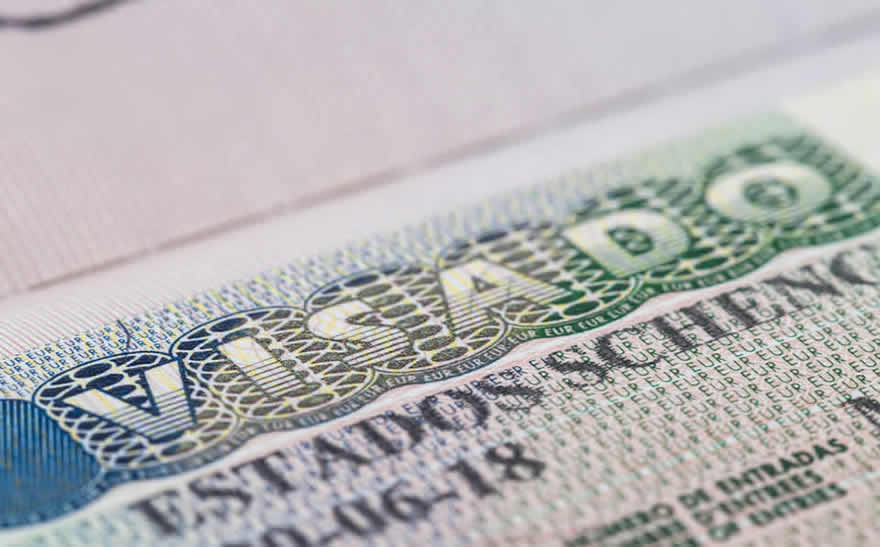
© Fotolia
The EU continued to implement the European Agenda on Migration in 2019 with a comprehensive and humane approach to migration management. Since 2015, EU-funded resettlement schemes have provided over 67 000 vulnerable refugees with legal and safe pathways to Europe, and several innovative pilot projects have been implemented with a number of interested Member States to enable labour migration from partner countries in Africa.
Work to prevent irregular migration continued in collaboration with partner countries to fight smuggling networks in the Sahel and improve the effective rate of return for people without a right of residence in the EU. This was possible thanks to formal readmission agreements or practical arrangements on return and readmission with 23 countries.
By the end of the year, irregular border crossings were 92 % below the 2015 peak levels. The EU had shown its solidarity by providing over €12 billion to assist vulnerable refugees and migrants in neighbouring and partner countries since 2015. In addition, almost €11.3 billion was provided to Member States to better manage migration and borders.
2019 was a landmark year for European border management, with new rules strengthening the European Border and Coast Guard Agency becoming law in December. This ambitious new regulation will set up a standing corps of 10 000 operational staff, who will have executive powers and their own equipment to intervene wherever needed along the EU’s external borders, as well as when requested by non-neighbouring countries.
The European Agenda on Migration
In September 2017, Member States made the largest collective commitment on resettlement so far, pledging to resettle over 50 000 people in need of international protection. Implementation progressed throughout 2019 and the Commission continued to assist Member States to deliver on their pledges. With global resettlement needs remaining high, continued European efforts are key. By December, 43 800 people had been resettled under the scheme, more than 87 % of the overall pledge by Member States.

The continent of solidarity: video accompanying the progress report on the Implementation of the European Agenda on Migration.© European Union, 2019

Since 2015, two successful European Union resettlement programmes have helped more than 67 000 of the most vulnerable people in need of international protection find shelter in the European Union. Member States resettling people in need of international protection through these programmes receive financial support from the EU budget. Under the ongoing European Union resettlement scheme (2017-2019), this contribution is set at 10 000 euro for each resettled person.
Border management
In December, new rules strengthening how the EU manages its external borders became law and will enable the European Border and Coast Guard Agency to set up a standing corps of 10 000 operational staff.
Members of the standing corps will have executive powers and their own equipment to intervene wherever needed along the EU’s external borders as well as in non-EU countries willing to accept Border and Coast Guard teams on their territory. Member States (and the non-EU countries concerned) retain their sovereignty and the responsibility for operations carried out at their borders and over their return procedures at all times. Forty fundamental rights officers will be appointed to ensure that members of the standing corps respect the rights of non-EU-country nationals who cross the external borders (whether regularly or not) or who are subject to return operations.
The Commission successfully negotiated with five western Balkan countries status agreements that allow European Border and Coast Guard teams to be deployed. The agreement with Albania entered into force on 1 May 2019, followed 3 weeks later by the teams’ operational deployment. The Commission and the Finnish Presidency of the Council signed a status agreement with Montenegro on 7 October, and with Serbia on 19 November. The finalisation of such agreements with Bosnia and Herzegovina and North Macedonia is still ongoing.
Information systems on security, migration and border management
In June, new European legislation entered into force, allowing various information systems that support the Area of Freedom, Security and Justice without internal border controls to exchange data and share information. Once this interconnected platform is in place (expected in 2023), border, migration, visa, judicial and police authorities will be able to cross-check identity data against all relevant EU information systems on a single screen and immediately be able to flag anyone trying to use multiple identities.

The scaling up of the European border agency has increased the number of European border guards deployed from less than 300 units in 2014 to the current 1 300, with a reserve pool of 1 500 border guards added in 2019. Investment in border management has been growing steadily since 2006 (2.4 billion euro from 2006 to 2013, and 5.6 billion euro from 2014 to 2020). The budget approved for the period 2021-2027 represents a considerable increase in investment, to 21.3 billion euro. Source: European Commission.

The Commission has proposed the establishment of an Entry/Exit System to contribute to the modernisation of the external border management by improving the quality and efficiency of the external border controls of the Schengen area. It will help Member States to deal with the ever-increasing number of travellers to the European Union without having to increase the number of border guards. It will reinforce internal security and the fight against terrorism and serious crime, and will systematically identify over-stayers (individuals remaining in the Schengen area beyond the end of their authorised stay).
Work continued on the implementation of the Entry/Exit System (EES) and the European Travel Information and Authorisation System (ETIAS). The former will replace the current method of manually stamping passports with an electronic record of identity and travel document data, as well as places and dates of entries and exits. It will help to ensure that non-EU-country nationals do not stay longer than authorised, improve the quality and efficiency of external border controls and help Member States to deal with increasing numbers of travellers. The ETIAS will also ensure that national authorities have more information on whether persons travelling visa free to the EU could pose a security or irregular immigration risk before they arrive at the external borders. If needed, their travel authorisation could be denied.

Reinforcing the European Border and Coast Guard. © European Union, 2019
Managing migration and saving lives at sea
EU joint operations and naval missions contributed to the rescue of over 760 000 people at sea and supported Member States hosting new arrivals from the Mediterranean.
In line with the 2015 EU Action Plan against Migrant Smuggling, in August the revision of the regulation on immigration liaison officers networks entered into force. This will ensure better cooperation and coordination among the immigration liaison officers that Member States, the Commission and EU agencies deploy in non-EU countries in order to respond more effectively and prevent and combat irregular immigration and related cross-border criminality.

Between 2014 and 2019, irregular border crossings on the three main migratory routes, namely the eastern Mediterranean, the central Mediterranean and the western Mediterranean, experienced a fluctuating trend that mostly remained below 50 000 arrivals per month. The eastern Mediterranean route has consistently experienced the highest number of crossings, followed by the central Mediterranean route and the western Mediterranean route. Higher levels of crossings were recorded, starting from the beginning of 2015 to the beginning of 2016; the number of crossings on the eastern Mediterranean route rose much higher than the average, reaching a peak of 200 000 crossings per month in October 2015; 10 000 arrivals were recorded on 20 October alone. Since then, the number of irregular border crossings on the three main routes have decreased to 2014 levels, well below 50 000 arrivals per month. Source: Data from the ‘Progress report on the implementation of the European Agenda on Migration’, COM(2019) 481 final, 16 October 2019. Data source: European Border and Coast Guard Agency.
The Commission continued its contribution towards efforts to prevent prospective migrants from embarking on irregular migratory journeys towards the EU and having their lives put in danger by smugglers. It financed eight information and awareness-raising campaigns, directly targeting prospective irregular migrant communities in non-EU countries as well as their trusted diaspora communities in Europe with objective information to allow migrants to make informed decisions. The Commission also increased its financing of Common Operational Partnerships, which include Joint Investigation Teams, to €22.5 million. These partnerships between Member States and non-EU-country law-enforcement authorities target migrant smugglers in west and north Africa.
Temporary arrangements
Disembarkation events in the central Mediterranean have clearly demonstrated the need for common European solutions based on solidarity, taking responsibility and respect for fundamental rights. The Commission has been actively supporting the conclusion of temporary arrangements between Member States that facilitate disembarkation following search-and-rescue operations in the Mediterranean pending an agreement on a long-term sustainable system in the reform of the European asylum system. The Commission, with the support of EU agencies and at the request of Member States, has also been coordinating voluntary relocation throughout 2019, with 1 608 people relocated.
Return and readmission
The European Parliament and the Council continued negotiating on the Commission’s 2018 proposal to strengthen the Return Directive. The changes to the EU’s common rules on return include simplifying returns for those who are refused asylum during border procedures, introducing clearer and faster procedures for issuing return decisions and requiring that a return decision be issued immediately after a decision to terminate a legal stay is taken.
The European Border and Coast Guard Agency’s ability to assist returns was strengthened in December by a new regulation becoming EU law. This gives the agency a more proactive role in assisting Member States based on their needs and broadening the scope of potential assistance to all stages of the return procedure.
The European Union has concluded 23 readmission instruments with non-EU countries. In 2019, the work continued, with ongoing negotiations of agreements or wider migration cooperation frameworks with six other countries.
Protecting those in need
Asylum reform
Despite intense efforts by the Romanian and Finnish Presidencies of the Council, Member States failed to find a consensus and the proposals to reform the EU’s asylum policy remain stalled. Immediately upon taking office in December, Vice-President Margaritis Schinas and Commissioner Ylva Johansson took to the road and began a listening tour of Member State governments, with visits to Denmark, Germany, Greece, France, Italy and Hungary. Each also held a structured debate with the European Parliament. The consultation is an important aspect of President von der Leyen’s commitment to finding a way forward on the issue of migration and will help to shape the New Pact on Migration and Asylum that will be proposed in 2020.
Hotspots and support for Greece, Cyprus, Malta, Italy and Spain
Since 2015, the Commission has provided €2.2 billion in financial support to assist the Greek authorities, international organisations and non-governmental organisations (NGOs) with migration management. This was provided under the Asylum, Migration and Integration Fund (AMIF), the Internal Security Fund (ISF) and the Emergency Support Instrument. In addition, the Commission continued to provide structural support to the Greek authorities with a permanent presence on the Aegean islands.
Since September 2019, the Commission has had a permanent presence in Cyprus to support the Cypriot authorities in efficiently managing migration. EU funding to the country since 2014 has reached €103.5 million. EU support totalling €112.85 million was provided to Malta under AMIF and ISF funding between 2014 and the end of 2019.
As regards Italy, the €59.4 million allocated in 2019 brought the total amount of emergency assistance to €285.2 million. This complements the €737.4 million in EU support provided to Italy under its national programmes for the AMIF and ISF between 2014 and 2020.
The Commission continued to support Spain by awarding over €52 million in emergency assistance since 2018 to provide support to migrants, set up local registration and pre-reception centres and deploy extra Guardia Civil forces.
Migrants arriving at hotspots in Greece and Italy, as well as at registration centres on the southern coast of Spain, continued to be properly registered, identified and fingerprinted.
Financial support for the efficient management of migration
The EU supports national efforts to improve migration and border management with significant funding channelled through the national programmes of action managed by Member States. In 2019, it provided €467 million under the AMIF, €442.7 million under the ISF (Borders and Visa) and €92.7 million under the ISF (Police).

The Asylum, Migration and Integration Fund supports Member States in managing migration flows, including in the fields of asylum, integration, legal migration and return. The Internal Security Fund supports Member States’ efforts to better protect the security of citizens and to better protect and manage the European Union’s external borders. It is composed of two instruments: the Internal Security Fund (Borders and Visa) and the Internal Security Fund-(Police). Copyright: European Union
The EU–Turkey Statement
The EU–Turkey Statement continued to provide alternatives to dangerous routes and save lives in the Aegean Sea. The number of irregular migrants from Turkey to Greece arriving by sea in 2019 (around 60 000) was considerably lower than before the statement (pre-October 2015). Member States have opened up organised, safe and legal pathways for Syrian refugees in Turkey to come to Europe by resettling around 25 700 of them (up to the end of 2019). In 2019, 3 854 voluntary returns from Greece to non-EU countries took place under the Assisted Voluntary Return and Reintegration programme, of which 3 260 from the mainland and 594 from the islands. Since 2016, 17 900 migrants have returned voluntarily from both the Greek islands and the mainland with the support of the programme.
At the same time, the EU has continued to support Turkey in its efforts to host refugees with €6 billion for 2016-2019 through its Facility for Refugees in Turkey.
By the end of 2019, the full budget had been allocated to activities. Of the €4.7 billion that had been contracted, €3.2 billion had been paid out. Over 1.7 million refugees continue to benefit from a monthly cash assistance called the Emergency Social Safety Net to help them meet their basic needs, and more than 500 000 refugee children have access to education.

An EU-funded Emergency Social Safety Net beneficiary, a Syrian refugee from Raqqa, speaks with a World Food Programme staff member in his home, Ankara, Turkey, 24 September 2019.
Enhancing safe, orderly and legal pathways to Europe
Visa policy
The EU continued to update and streamline its visa policy for non-EU-country nationals travelling to the Schengen area. From February 2020, the revised Visa Code will reduce red tape and facilitate visa procedures for trusted short-stay travellers while maintaining security. The revised code establishes a new mechanism that triggers stricter conditions for processing visas when a partner country does not cooperate sufficiently on the readmission of its own nationals who are staying in the EU irregularly. For certain categories of travellers, Member States will be able to slow down visa-processing times, reduce the length of validity of visas issued and increase the level of the visa fee, as well as modulating the exemption from such fees.
Visa facilitation and visa suspension
In June, the negotiations between the EU and Belarus on Visa Facilitation and Readmission Agreements were finalised and the agreements were initialled by chief negotiators. Both sides are now working to complete their internal procedures in order to enable the signature and conclusion of the agreements. The two agreements will be signed and will enter into force simultaneously.
The Visa Suspension Mechanism was strengthened in 2017 to allow a swift response in case of urgency. In June 2019, the Commission received a notification from the Netherlands under the mechanism concerning Albania. After careful consideration of the content of the notification and based on the available information and relevant data, the Commission considered that the circumstances required to trigger the mechanism had not been met, and committed to monitor the situation.
Visa reciprocity
Today, citizens of around 60 countries from around the world can travel to the EU without needing a visa. In turn, EU citizens should have the same ability to travel to these countries. This principle of reciprocity is central to our common visa policy. Progress was made with the United States when, in September, the US administration announced that Poland qualified to join its Visa Waiver Program. While the United States continued to require visas for citizens of Bulgaria, Croatia, Cyprus and Romania, this development explains why the Commission takes the approach of patient diplomacy with the US administration.
The United States has indicated a willingness to admit these Member States into the Visa Waiver Program once they meet the requirements set out by US legislation, for example regarding security cooperation and lowering the visa-refusal rate.
Golden passports and golden visas
In January, the Commission presented a comprehensive report on investor citizenship and residence schemes operated by a number of Member States. These schemes, commonly known as ‘golden passports’ and ‘golden visas’, respectively, allow a person to obtain a new nationality or residence permit based on an investment alone. As regards countries that enjoy visa-free access to the EU, the Commission’s report underlined that these countries must carry out security and background checks of applicants for investor citizenship schemes to the highest possible standards. The Commission is monitoring this as part of the Visa Suspension Mechanism. As concerns candidate countries and potential candidates, citizenship schemes are also monitored in the context of the EU accession process. Please refer also to Chapter 7.
Encouraging needs-based migration
In 2019, the EU strengthened bilateral cooperation with countries of origin and transit and with international organisations to address the root causes of irregular migration and forced displacement, improve border management and support voluntary returns and human mobility. It also worked with the African Union and the United Nations through their joint Taskforce.
The Commission continued to work on developing pathways for legal migration in order to help bring to the EU the people with the skills and talents that the labour market needs. In spring, the Commission completed an overall evaluation of the EU’s legal migration rules. The results of this ‘fitness check’ confirmed the importance of an effective legal migration policy as a key plank of a comprehensive European migration policy.
Throughout the year, the Commission continued to work in cooperation with Member States on the development of labour migration pilot projects with key partner countries, starting with African countries. To this end, the Commission has provided financial support, including under the Emergency Trust Fund for Africa.
Integration
Integration policy is a national responsibility. Nevertheless, in 2019, the Commission continued to support the efforts of Member States, local and regional authorities, NGOs and other actors through policy coordination, exchange of practices, monitoring and funding. These measures were put in place to foster the integration of non-EU-country nationals who have been given refugee status. In 2019, the Commission financed eight large transnational networks of cities and regions, bringing together more than 40 European cities and 10 regions to cooperate on integration issues. In the context of the European Integration Network, the Commission supported several mutual learning activities for national authorities including an innovative programme of support between Member States to put in place or improve a specific policy or programme on integration.
Chapter 9
A stronger global actor

In times of global disorder, when the idea of multilateralism has come under attack, the European Union is leading a global push to address today’s challenges through international cooperation. In 2019, the EU worked to defend and strengthen the United Nations and crucial multilateral agreements, from the nuclear deal with Iran to the Paris Agreement on climate change and the Sustainable Development Goals.
The EU supported UN-led talks aimed at addressing the worst conflicts of our times, for instance in Syria and Libya, and contributed to the UN-brokered Stockholm Agreement on Yemen. It accompanied negotiations leading to the peace deal in Mozambique, witnessed its signing and supported its implementation.
The EU created an International Contact Group on Venezuela with European and Latin American countries to help build a peaceful and democratic solution to the crisis. It also hosted an International Solidarity Conference for Venezuelan refugees and migrants. Key summits took place with Ukraine, China, Japan and, for the first time, with the League of Arab States.
The EU supported reforms in the western Balkans, as well as in the eastern and southern neighbourhoods and consolidated its partnerships with these countries.
The EU enhanced its role in security and defence by investing in Europe’s defence industry, military and civilian capabilities and technology. The EU took a step closer to setting up the European Defence Fund and to forging closer relations with NATO.
The EU also continued its humanitarian mission by distributing €1.6 billion of aid to countries hit by natural and man-made disasters.
The European Union’s neighbourhood
The eastern neighbourhood
In 2019, the EU continued to support and foster stability, security and prosperity under the European Neighbourhood Policy and to develop strong partnerships with neighbouring countries to the east and south.
In May, a Ministerial Meeting and a High-level Conference in Brussels celebrated 10 years of the Eastern Partnership. Progress has been made on reforms in all areas of the 20 Deliverables for 2020 agenda, in particular in the economy, digital, transport, connectivity, energy and mobility, while challenges remain in the areas of governance and institution building. Following a wide consultation in 2019 on the future of the partnership, long-term policy objectives should be presented in advance of the Eastern Partnership Summit due to take place in the first half of 2020.

Young people from the EU and its six Eastern Partnership countries (Armenia, Azerbaijan, Belarus, Georgia, Moldova and Ukraine) attend the third edition of the European School Summer Camp, Tbilisi, Georgia, 17 August 2019.
Relations with Ukraine
At their summit in Kyiv in July, the EU and Ukraine issued a joint statement and the EU reaffirmed its commitment to Ukraine’s independence, sovereignty and territorial integrity. The EU also affirmed its support for the implementation of the Minsk agreements and for the work of the Normandy Format, the Trilateral Contact Group on Ukraine and the Organisation for Security and Co-operation in Europe (OSCE) aimed at reaching a peaceful and sustainable solution to the conflict. The Commission and the Ukrainian government signed four programmes worth €109 million from the Commission’s 2019 annual support package to the country. These will focus on decentralisation, the fight against corruption, supporting civil society and technical cooperation on key reforms and implementing the Association Agreement and its Deep and Comprehensive Free Trade Area.
Russia
The EU continued to implement a double-track approach to Russia, which remained a strategic challenge: sanctions in response to Russia’s violations of Ukrainian sovereignty and territorial integrity and selective engagement as necessary on issues of interest to the EU, such as youth and cultural exchanges and EU–Russia educational cooperation.
The southern neighbourhood
EU financial and technical assistance in 2019 helped tackle the main challenges of the region: the conflicts in Syria, Libya and between Israel and Palestine (this designation shall not be construed as recognition of a State of Palestine and is without prejudice to the individual positions of the Member States on this issue), persistent migratory pressure, poor governance and a weak business environment. A renewed impetus was given to EU–Morocco relations in June with a joint political declaration aimed at developing a partnership for shared prosperity. The External Investment Plan has been instrumental in funding the private sector and boosting economic development and job creation in the southern neighbourhood region and Africa.
The western Balkans and the enlargement process
The EU institutions continued to support the EU membership perspective of the western Balkans in 2019, in line with the Western Balkans Strategy and the Sofia Priority Agenda, which are aimed at strengthening the region’s political, economic and social transformation. The EU also continued to support cooperation to fully unleash the region’s economic and social potential and to overcome the legacy of the past. For example, the western Balkans regional roaming agreement entered into force in July, significantly lowering roaming charges in the region and leading to zero roaming costs in 2021. The entry into force of the historic Prespa Agreement between Greece and North Macedonia in February was a major breakthrough in the region.
The first EU–western Balkans ministerial meeting on employment and social affairs took place in Luxembourg on 12 June. Ministers from the troika Presidency of the Council (Romania, Finland and Croatia), together with the Commission, met with their western Balkans counterparts to discuss a range of employment and social policy issues. Expected to take place every year, the aim of the meeting is to exchange views on challenges to employment and social reforms that benefit all citizens in the region.
In October, the European Council analysed the Commission’s recommendations to open accession negotiations with Albania and North Macedonia and decided to revert to the issue of enlargement before the EU–western Balkans summit in Zagreb in May 2020.
Turkey
Relations between the EU and Turkey continued to be challenged by the critical situation of the rule of law, fundamental rights and the independence of the judiciary in Turkey, as well as mounting tensions in the eastern Mediterranean. The EU has continued to assist refugees under the Facility for Refugees in Turkey, which manages €6 billion in funding to help over 4 million refugees hosted in the country.
Africa–Europe relations
The EU has embarked on an unprecedented partnership with Africa, investing in a true political relationship between equals. The EU–Africa partnership spans a variety of fields, including development, peace and security, migration, climate, energy, agriculture, trade, sustainable investment and jobs, innovation, education, youth, democracy and human rights.
In 2019, the implementation of the 2018 Africa–Europe Alliance for Sustainable Investment and Jobs progressed. The EU has already mobilised €3.7 billion under the External Investment Plan, which is expected to leverage €37.1 billion of investments in the EU neighbourhood and in sub-Saharan Africa. The commitment to dedicate over €300-350 million each year between 2018 and 2020 to strengthen the business environment and investment climate is also on track, with €718 million invested by the EU in 2018 alone.
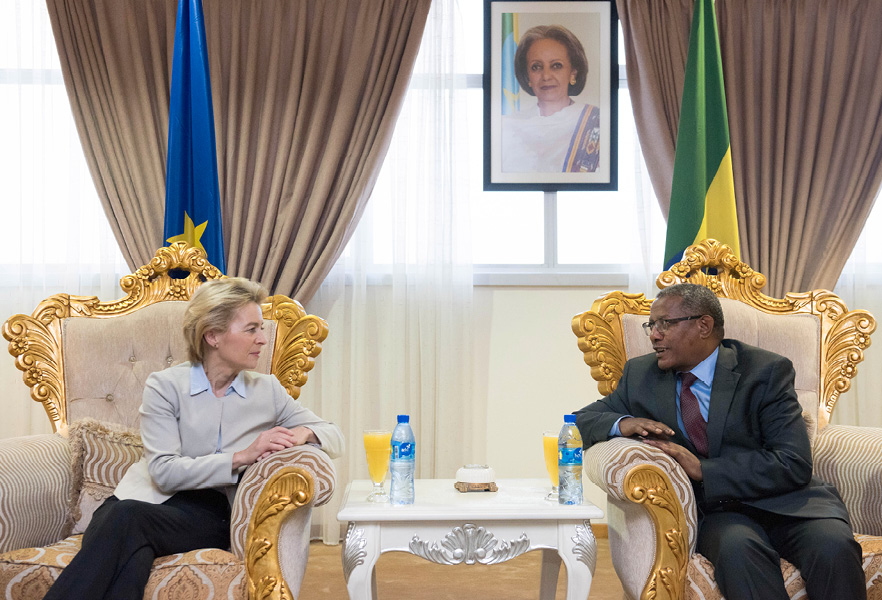
Ursula von der Leyen, President of the European Commission, and Gedu Andargachew, Ethiopian Minister of Foreign Affairs, meet in Addis Ababa, Ethiopia, 7 December 2019.
As regards mobility, the EU’s commitment to support 35 000 students and staff by 2020 is on track, with around 25 000 benefiting by the end of 2019. As regards economic integration and trade, the EU will support the African Continental Free Trade Area with €62.5 billion until 2020. Finally, the work of the four task forces set up with African and European experts in the areas of agriculture, the digital economy, energy and transport has borne fruit.
North America and Latin America
The EU has continued to work with one of its core partners, the United States. Examples of this cooperation are on the western Balkans and Ukraine, on energy, counterterrorism and cybersecurity. The EU’s strengthened partnership with NATO testifies to an increasingly interconnected transatlantic security space.
The EU joined forces with Canada to uphold multilateralism and the rules-based global order, including a free and fair international trade system. At their summit in Montreal in July, both sides committed to the full implementation of the EU–Canada free trade agreement.
In April, the Commission and the High Representative of the Union for Foreign Affairs and Security Policy and Vice-President of the Commission published a joint communication setting out a vision for a stronger and more modern partnership with Latin America and the Caribbean that would be focused on trade, investment and sectoral cooperation. In 2019, the EU continued to lead support for the peace agreement in Colombia, consolidated the new phase in its relationship with Cuba at the second ministerial-level EU–Cuba Joint Council under the Political Dialogue and Cooperation Agreement and established the International Contact Group on Venezuela to help overcome the crisis there. In October, the International Solidarity Conference on the Venezuelan refugee and migrant crisis brought together the countries of the region, the EU, the UN Refugee Agency (UNHCR) and the UN Migration Agency (IOM) to try to improve coordination of peace and the humanitarian response.
Asia and the Pacific
The EU and the five central Asian countries – Kazakhstan, Kyrgyzstan, Tajikistan, Turkmenistan and Uzbekistan – have a longstanding relationship based on strong mutual interests. In May, the EU set out its vision for a stronger partnership with these countries, focusing on resilience, prosperity and better cooperation.
Japan
The 2018 EU–Japan Strategic Partnership Agreement, provisionally applied since February 2019, and the Economic Partnership Agreement, in force since then as well, started to bear fruit in 2019. The 26th EU–Japan summit took place in Brussels in April. On 7 September, President Juncker and Prime Minister Abe signed a Partnership on Sustainable Connectivity and Quality Infrastructure. It is the first of its kind and underlines the strategic importance of this relationship, which both parties have committed to strengthen.
China
In March, against the backdrop of China’s growing economic power and political influence, the European Commission and the High Representative reviewed EU–China relations and the related opportunities and challenges in a joint communication. They set out 10 concrete actions that were then discussed by leaders at the European Council on 21 March.
At their summit in April, the EU and China committed to deepen the strategic partnership and to adopt a new cooperation agenda beyond 2020 by their next summit. Both sides agreed to identify common EU–Asia railway corridors and are working on local development in transit countries. The two are more engaged on Asian security, from military cooperation with the Association of Southeast Asian Nations to supporting the denuclearisation of the Korean peninsula.
A more strategic approach to Asia in 2019 was part of the EU’s aim to pursue a coherent approach to China’s connectivity drive westwards. The EU’s connectivity strategy promotes a policy that includes infrastructure projects creating fair economic opportunities and fostering sustainable connectivity.
The Middle East
Iran
In 2019, the EU continued to support the Iran nuclear deal and its full and effective implementation in all its aspects. The EU regrets the withdrawal of the United States from the Joint Comprehensive Plan of Action and its reimposition of sanctions and has been deeply concerned that Iran started to pursue activities inconsistent with its commitments under the deal. In line with the Council conclusions of 4 February 2019, the EU is pursuing a comprehensive approach with Iran in order to address all issues of concern and to balance elements of relevant criticism with constructive high-level dialogue, including through the EU-led political dialogue with Iran on regional issues.
Israel, Palestine and the Middle East peace process
The EU continued to defend and promote the principle of a two-state solution to the Israeli–Palestinian conflict based on the agreed international parameters. The EU also provided almost €350 million in financial support to the Palestinians, with much of the funding aimed at efforts to build the foundations of the future Palestinian state.
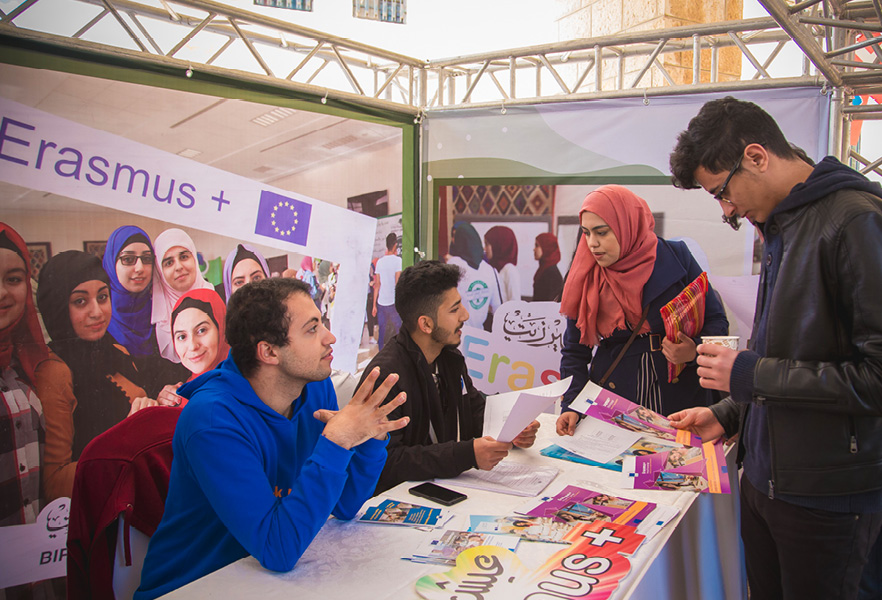
Students at the Erasmus+ information stand during the exhibition and networking session of the #EU4YOUth campus tour promoting the EU with young people, Birzeit, Palestine, 21 February 2019.
Syria
At the Brussels III Conference on Syria in March, the EU pledged €560 million for 2020 to support humanitarian, resilience and development activities in the country as well as in Jordan and Lebanon.
Libya
EU engagement in 2019 focused on supporting international and regional efforts to find a sustainable solution to the political crisis in Libya and to promote its economic development.
Security and defence
Member States can now better protect citizens, invest in cooperation on defence, spend more efficiently and engage with partners and neighbours even more than before.
In 2019, the EU continued its efforts to counter hybrid threats. The High Representative and the Commission reported on the implementation of the 2016 joint framework on countering hybrid threats and the 2018 joint communication on increasing resilience and bolstering capabilities to address them.
The EU has further strengthened the three dedicated Strategic Communications Task Forces (East, western Balkans and South). Progress was also made in tackling disinformation from external and internal sources. The 2018 Action Plan against Disinformation guided this work, focusing on detecting and analysing disinformation activities, supporting cooperation between Member States by establishing a Rapid Alert System, working with social media platforms in the framework of the 2018 Code of Practice and enhancing awareness-raising activities. The EU also cooperated with international partners in the field, such as the G7 and NATO. See also Chapter 7.
The European Centre of Excellence for Countering Hybrid Threats made progress in 2019 with more members, an approved work programme and a working budget. The centre continued to provide support in key areas such as training and exercises.
The year saw a stocktake of Member States’ progress in fulfilling their commitments under Permanent Structured Cooperation (PESCO). The EU noted that participating Member States made progress in increasing defence budgets and joint defence investment, with aggregated defence budgets rising by 3.3 % in 2018 and 4.6 % in 2019. Participating Member States are increasingly using EU instruments in national defence planning, such as the revised Capability Development Plan and the Coordinated Annual Review on Defence, which have informed the work programme for the European Defence Industrial Development Programme.

The European Union needs a European Defence Fund for several reasons. First, the lack of cooperation between Member States in the field of security and defence is estimated to cost between 25 billion euro and 100 billion euro every year. Additionally, around 80 % of defence procurement is currently run on a purely national basis, leading to a costly duplication of military capabilities. Finally, since 2010, less than 200 million euro have been spent each year on collaborative European research and technology in the field of defence.
Development aid and humanitarian assistance
Development aid
The EU continued to be one of the driving forces behind the 2030 Agenda for Sustainable Development. In New York in September, it gathered with world leaders for the first-ever UN Sustainable Development Goals Summit and reported on progress in the Joint Synthesis Report.

Participants in the European Development Days 2019 ‘Faces2Hearts’ campaign discussing inequalities in global development, Brussels, Belgium, 19 June 2019.
‘Inequalities’ was the theme of the 2019 European Development Days and the Commission issued a staff working document on the topic. Furthermore, the EU helped fight gender-based violence under the ‘Spotlight’ initiative, joining forces with the UN and new partner countries to continue vital work on regional programmes, including the launch of a consultation in the Pacific regarding the design of the €50 million programme for the region.
The EU continued to build on its partnership with Africa. The Africa–Europe Alliance for Sustainable Investment and Jobs made significant progress, notably leveraging over €40 billion in investments under the External Investment Plan so far.

European Union humanitarian funding for education in emergencies has grown from 13 million euro in 2015 to 63 million euro in 2016 and 2017, to 91 million euro in 2018 and 164 million euro in 2019.
Responding to humanitarian crises and emergencies
The EU’s humanitarian budget of €1.6 billion helped millions of people worldwide in 2019. The biggest share went to refugees and internally displaced persons created by the Syrian and Yemeni conflicts. More than 10 % of the budget went to ‘forgotten crises’, such as the situation with regional refugees in Burundi, the conflict in Ukraine and humanitarian issues in Colombia.
The EU allocated a record 10 % of its humanitarian budget to provide safe and good-quality education for children in emergencies. It was also a leading donor in the Ebola response.
In 2019, the EU activated its Civil Protection Mechanism on 17 occasions to respond to sudden disasters in Albania, Africa, Asia and Latin America. When Cyclone Idai struck Mozambique in 2019, eight teams of civil protection specialists were sent, together with water purification equipment, tents, hygiene kits and food.

The total European Union humanitarian aid budget for 2019 was 1.6 billion euro. From the total budget, 385 million euro was allocated to sub-Saharan Africa; 860 million euro to the Syrian crisis, covering funding in Egypt, Jordan, Lebanon, Syria and Turkey; 88 million euro was allocated to Iraq, Palestine and Yemen; 105 million euro was allocated to Asia, Latin America, the Pacific and the Caribbean; and 32 million euro was allocated to North Africa and the European Union neighbourhood. 174 million euro went towards reserves and non-geographic allocations. Source: European Commission Copyright: European Union
Human rights and democracy
The EU remained deeply engaged in promoting and defending human rights and democracy around the world: from joint actions with the UN, such as the flagship EU–Unicef campaign #TheRealChallenge to mark the 30th anniversary of the UN Convention on the Rights of the Child, to the new EU guidelines on combating torture on a global scale. The EU was active in the seventh World Congress against the Death Penalty, sent numerous election observation missions and adopted new conclusions on democracy in October.
EU support for multilateralism, global governance and the rules-based system
EU–United Nations relations
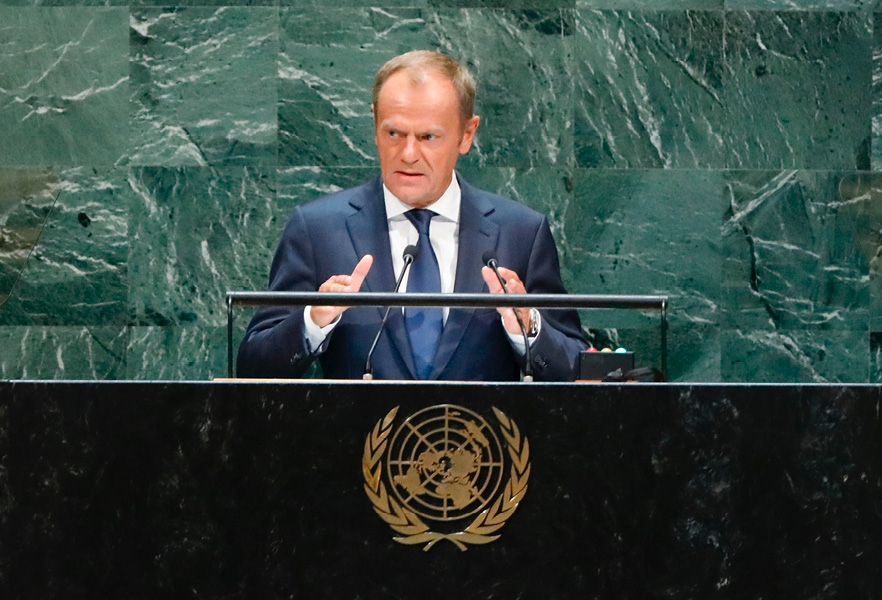
Donald Tusk, President of the European Council, addresses the UN General Assembly, New York, United States, 26 September 2019.
In times when the UN system has been questioned, the EU has stepped up its commitment to multilateralism and to the international organisation. The EU is the largest contributor to UN peacekeeping missions and the UN budget. It has supported UN-led peace talks, from Syria to Libya, and has set up initiatives such as the trilateral partnership between the EU, the UN and the African Union. The annual UN General Assembly showed the depth of this support.
A stronger EU–NATO partnership
EU–NATO cooperation constitutes an integral part of the EU’s work in strengthening European security and defence. Published in June, the fourth progress report on the implementation of the common set of proposals endorsed by NATO and the EU in 2016 and 2017 highlighted concrete deliverables in all areas of cooperation and notably in the key areas of strengthening political dialogue, military mobility, countering hybrid threats, parallel and coordinated exercises and defence capabilities.
The EU in the G7 and G20
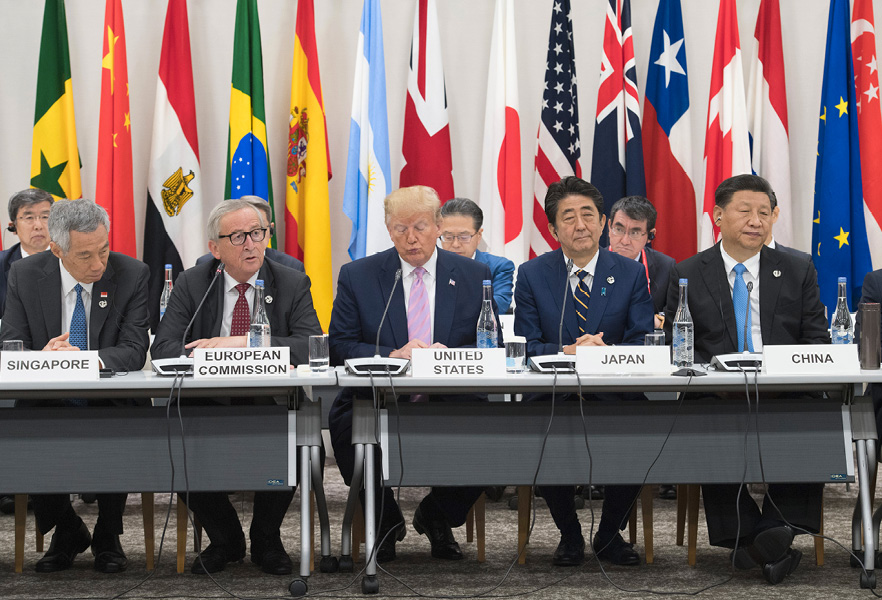
World leaders Lee Hsien Loong, Prime Minister of Singapore, Jean-Claude Juncker, President of the European Commission, Donald Trump, President of the United States, Shinzō Abe, Prime Minister of Japan, and Xi Jinping, President of China, gather for the G20 summit, Osaka, Japan, 28 June 2019.
The European Union is a member of the G7 and G20. In these fora, it fights to preserve the rules-based international order, which is currently under great strain, in terms of trade, security, climate change and human rights. As in previous years, throughout 2019 the EU remained a strong supporter of international cooperation. At the G20 Summit in Osaka, Japan, coordination among European leaders was instrumental in achieving a final declaration that preserves past commitments regarding the implementation of the Paris Agreement and the 2030 Agenda for Sustainable Development and pushes for ambitious progress on the World Trade Organization’s reform and on a global solution for digital taxation. In August in Biarritz, France, G7 leaders agreed on a declaration that addresses a number of foreign-policy challenges such as the situation in Iran, Ukraine, Libya and Hong Kong. In line with its priorities for cooperation with Africa, the EU also endorsed new G7 initiatives aimed at improving conditions for public procurement, promoting digitalisation, increasing access to finance for female entrepreneurs in Africa, reinforcing cooperation in the Sahel, fighting pandemic diseases and supporting women victims of sexual violence in conflict areas.
Chapter 10
A Union of democratic change

‘Regaining citizens’ trust in the European project’ was President Jean-Claude Juncker’s objective for the cycle that started in 2014 and came to a close at the end of 2019. To fulfil this goal, the Juncker Commission committed itself to making the EU more democratic and more transparent.
The informal meeting of EU leaders in Sibiu, Romania, on 9 May, was the opportunity for the EU to renew its unity and sense of purpose. The Sibiu Declaration was adopted. It was the time and place to demonstrate that citizens’ concerns were being taken into account in the Union’s Strategic Agenda. Citizens responded by voting in the European Parliament elections in the highest turnout since 1994, with more than 50 % of eligible Europeans taking the opportunity to cast their vote.
2019 also saw a change to the rules of the European Citizens’ Initiative to make it easier for citizens to shape Europe by calling on the European Commission to make a legislative proposal. The reformed rules will make the initiative more accessible and more user friendly.
The European Parliament
In its last sessions before the elections in May, the outgoing Parliament adopted legislation banning single-use plastic items and ensuring better protection of the EU’s external borders. The Parliament pushed through an ambitious target of reducing CO2 emissions for new cars and vans by 2030. It agreed on new copyright rules, gave its consent to the EU’s trade agreement with Japan and supported plans to improve the quality of drinking water. It also updated its internal rules of procedure.
The new legislative term started on 2 July following the Parliament elections from 23 to 26 May. The turnout of 50.7 % was the highest since 1994 and up from 42.6 % in 2014.
On 16 October, the Parliament adopted its list of ‘unfinished business’, which is essential for continuing informal negotiations between the EU institutions on draft EU rules that could not be finalised before the Parliament’s end of mandate. On 22 October, Commission President Juncker made a statement before Members of Parliament reviewing his Commission’s key actions and achievements over the previous 5 years.
The European Council
In March, the European Council discussed economic issues, climate change, disinformation and external relations. The meeting of the 27 Member States that discussed Brexit addressed the extension of Article 50 until 12 April or 22 May, depending on whether the Withdrawal Agreement would be ratified by the United Kingdom during the week following the meeting. Later in April, the 27 EU leaders agreed to extend Article 50 until 31 October 2019.
EU leaders met informally in Sibiu, Romania, on 9 May to reflect on the Strategic Agenda for 2019-2024. More information on these discussions can be found in the section ‘The future of Europe’.
At an informal dinner later in the month, Members of the Council took stock of the results of the European Parliament elections and started the nomination process for the new heads of the EU institutions.
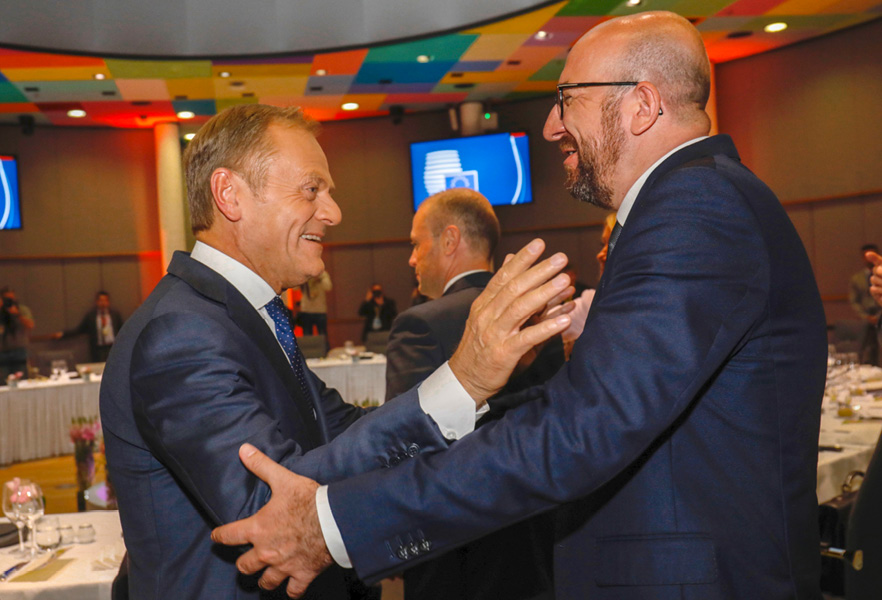
Donald Tusk, former President of the European Council, and Charles Michel, current President of the European Council, at a European Council roundtable, Brussels, Belgium.
In June, leaders continued discussions on the EU high-level appointments, the Multiannual Financial Framework, climate change, disinformation and hybrid threats, enlargement, the European Semester and external relations. They also adopted the Strategic Agenda.
EU leaders met again later in the month to discuss and agree on the nominations for high-level appointments in the EU institutions.
In October, leaders discussed the EU’s future budget (2021-2027) and the follow-up to the Strategic Agenda, as well as climate change, the enlargement of the EU, Turkey and the downing of Malaysia Airlines flight MH17. The European Council met in an Article 50 format to discuss the latest developments in relation to Brexit. At the end of October, the EU-27 (all Member States except the United Kingdom) leaders agreed to extend Article 50 until 31 January 2020.
Leaders then met in December to discuss climate change and returned again to the EU’s long-term budget.
The Council of the European Union
Romania and Finland held the rotating Presidency of the Council of the European Union. During the first half of the year, Romania focused on subjects such as migration and security, the Multiannual Financial Framework, economy and Europe as a global player. During the second half of the year, Finland focused on climate action and security and on strengthening common values, including the rule of law, to make the EU more competitive and socially inclusive.

The inaugural meeting of the Romanian Presidency of the Council of the EU, Bucharest, Romania, 11 January 2019.
The European Economic and Social Committee and the European Committee of the Regions
The European Economic and Social Committee supported the Parliament’s campaign ‘This time I’m voting’ with a number of activities. These included the February event Civil Society for rEUnaissance, with the participation of Commission President Jean-Claude Juncker and the climate activist Greta Thunberg.
The theme of the 2019 Civil Society Days was ‘sustainable democracy’, with corruption and fake news identified as the main threats to Europe’s democracy. In November, the committee held a conference on the rule of law calling for a structured dialogue between governments and civil society to reverse backsliding on the rule of law in the EU.
In March, it presented ‘Sibiu and beyond’, its vision for the future in which Europe would become the global leader in sustainable development. In a series of future-oriented opinions, it offered ideas on how to achieve sustainability, a just transition to a digital economy and fair taxation.
At the eighth European Summit of Regions and Cities in Bucharest in March, the European Committee of the Regions adopted a declaration on ‘Building the EU from the ground up with its regions and cities’, arguing that EU decisions and policies must be anchored locally in order for the EU to regain citizens’ trust and be properly resourced. It strongly advocates active subsidiarity, stressing the importance of engaging national, regional and local authorities at each phase of the EU decision-making process. The committee marked its 25th anniversary by holding a ceremony during its December plenary session.
In the field of better regulation, the committee initiated a regional hubs network (‘RegHub’) to evaluate the implementation of Union legislation at local and regional levels. It includes 20 regions that report on the implementation of policies. Three evaluations were organised in 2019: on public procurement, air quality and cross-border healthcare.
Throughout the year, both committees organised activities to promote their joint idea of a permanent mechanism for structured consultations and dialogues with citizens as well as their participation in the planned Conference on the Future of Europe.
See also the section entitled ‘The future of Europe’.
Completing the Better Regulation Agenda
Working to simplify legislation

One of the key achievements between 2014 and 2019 was regulatory and legislative simplification. During the Barroso II Commission, the average of key initiatives was 130 per year (117 in the last 11 months of 2010, 196 in 2012, 108 in 2013, 146 in 2014 and 79 by October 2015). During the Juncker Commission, the number of key initiatives decreased by 83 %, with 23 key initiatives presented in 2015 and 2016, 21 in 2017, 26 in 2018, and just 15 in 2019. During the period 2015 to 2019, there were 142 proposals for withdrawal, 84 repealed laws, and 162 initiatives for regulatory simplification. Source: European Commission.
The Interinstitutional Agreement on Better Law-Making
In 2016 and 2017, the European Parliament, the Council and the European Commission agreed on two joint declarations on the EU’s legislative priorities. They highlighted 89 initiatives for which priority treatment in the legislative process was required. This represented a common commitment by the three institutions to ensure substantial progress and, where possible, delivery before the European elections in May.
By the first half of 2018, the Commission had adopted all the initiatives announced in the joint declarations and, by the time of the European elections, 61 of the 89 initiatives in the joint declaration had been politically agreed upon or formally adopted by the Parliament and the Council. At the end of the year, 22 were still outstanding.
In 2019, the European Commission successfully concluded negotiations with the Parliament and the Council on non-binding criteria for the choice between implementing and delegated acts. This choice often complicates legislative negotiations and the criteria should help the process. These negotiations led to the conclusion of the Interinstitutional Agreement on Better Law-Making, published in July. Furthermore, the co-legislator agreed to the alignment of 68 existing acts to the Treaty of Lisbon by changing the regulatory procedure used. This is done with scrutiny to control how the Commission exercises its implementing powers on delegated acts and implementing acts according to Regulation (EU) No°182/2011 of the European Parliament and of the Council.
Monitoring the application of EU law
The annual report on monitoring the application of EU law, published in July, sets out how the Commission monitored and enforced EU law in 2018.
For example, the Commission acted firmly in enforcing rules in the areas of environment, mobility and transport, as well as internal market, industry, entrepreneurship and small and medium-sized enterprises. It supported national and regional authorities in implementing clear air and clean water rules. It also took action against Member States that failed to live up to their commitments and implement EU rules on passenger name records, combating terrorism and anti-money laundering. In addition, the Commission used enforcement powers when some Member States did not move fast enough to improve access to websites and other mobile applications for persons with disabilities. If EU law is not applied properly, citizens and businesses will not be able to enforce their rights or enjoy the benefits provided by such laws.

Infringement cases open between year-end 2014 and 11 October 2019. In 2014, there were 1 347 infringement cases opened by the European Commission. The Juncker Commission took office in November 2014, and the following year there were 1 368 infringement cases opened. This rose to 1 657 in 2016, dropped to 1 559 in 2017 and rose back up to 1 571 in 2018, with 1 581 infringement cases open by 11 October 2019. 699 infringement cases were closed in 2014 before going to the Court of Justice. Following the start of the Juncker Commission in November 2014, the number of infringement cases closed before going to the Court of Justice was 657 in 2015, 646 in 2016, 772 in 2017, 564 in 2018 and 663 by 11 October 2019. Source: European Commission.
Better regulation at the heart of the EU’s decision-making
The Commission is committed to act only where the EU adds value and provides benefits for people and businesses while avoiding unnecessary costs. It does so on the basis of the best available evidence looking at economic, social, environmental and other significant impacts. Before revising existing EU legislation, it evaluates it to understand what does and does not work, thereby helping to improve the performance of the legislation.
As part of its Better Regulation Agenda, the Commission is listening more closely to the views of citizens and stakeholders to address their needs. Since 2015, it has organised over 400 public consultations, engaging millions of Europeans. The number of contributions to public consultations received since then has more than quadrupled.
The new ‘Have your say’ portal, a ‘one-stop-shop’ system for Europeans to contribute to EU policymaking, was visited almost 900 000 times in 2018 and exceeded 1 million visits in 2019. In April, the Commission issued a report to take stock of the measures introduced under the Juncker Commission to deliver better results for EU citizens and businesses through more open, transparent and evidence-based policymaking. The results of the stocktaking were clear: better regulation has improved the way EU policy is made and should remain at the heart of its working methods for the future while continuing to improve its tools, in particular the outreach and feedback of citizens and stakeholders, the analysis of impacts and the quality of evaluations.
Transparency and accountability
The joint Transparency Register
Contact with stakeholders and civil society is part of the EU institutions’ work. At the same time, transparency and accountability are essential to maintain the trust of European citizens in the legitimacy of the political, legislative and administrative processes of the EU.
The transparency of interest representation is especially important in order to allow citizens to follow the activities of those seeking to influence the EU lawmaking process. This is why the Commission tabled a proposal in 2016 for a new interinstitutional agreement on a mandatory Transparency Register covering the Parliament, the Commission and, for the first time, the Council of the European Union. Negotiations on this proposal are currently underway.
Nearly 12 000 entities are listed on the register. They are bound by a Code of Conduct, which sets out the ethical norms that representatives must observe when interacting with the EU institutions.
Code of Conduct for the Members of the Commission
In 2018, the Commission adopted a new Code of Conduct for Commissioners, which sets stricter rules and higher ethical standards and introduces greater transparency in a number of areas. Every 2 months since February 2018, the Commission publishes information on the Commissioners’ travel expenses on their respective websites.
In June 2019, the Commission published the first annual report on the application of this Code of Conduct. It confirmed that since the adoption of the updated code, the Commission has achieved an even greater level of transparency when it comes to the conduct of its members.
Furthermore, under the new code, a reinforced Independent Ethical Committee composed of three high-calibre external members was set up to give advice on all ethical issues.
Earlier in the year, the Commission published ethical guidelines for Commissioners participating in the European parliamentary elections. These came after the new code enabled them to participate in the election campaigns without having to take a leave of absence, as had previously been the case.
The Commission also put into practice a new provision of the code, which provides that decisions shall be published on activities after the term of office of Members of the Commission and on related opinions of the Independent Ethical Committee. October saw the first publication, with others following before the end of the year.
Access to documents
In July, the Commission adopted its report on access to documents. The report shows that the number of initial requests for access to documents submitted under the relevant rules on public access to them increased by almost 9.5 % (from 6 716 in 2017 to 7 257 in 2018) and the number of confirmatory requests by 4.4 % (from 288 in 2017 to 318 in 2018).
The Commission remains the EU institution that handles the largest number of requests for access, with a steadily upward trend since 2016. EU citizens and other applicants are therefore making active use of this right to access documents.
In 2018, the Commission disclosed the requested documents fully or partially in more than 80 % of the cases, and wider or even full access was granted in almost 41 % of the 288 cases reviewed at the confirmatory stage.
In parallel, the Commission continued to proactively publish large amounts of documentation and information on its web pages and in its various public registers, covering all areas of EU activity. The data not only confirm the openness of the Commission but also the importance of the right of access to documents as part of the institution’s overall transparency policy.
Control of the EU budget
A control framework and a performance framework are in place to provide reasonable assurance that EU funds are paid in accordance with the relevant rules and that measures are taken to prevent, detect and correct errors while increasing the focus on achieving results.
In March, following a positive recommendation from the Council, the Parliament gave its final approval to the way the Commission implemented the EU budget in 2017. Through the annual discharge procedure, the Parliament and the Council hold the Commission politically accountable for the implementation of the budget and ensure that the management of taxpayers’ money is under democratic control.
In July, the Commission presented its Integrated Financial and Accountability Reporting package, which puts together all the available information on the implementation, performance, results, sound financial management and protection of the 2018 EU budget. The reports demonstrated that the budget delivered results in line with the Commission’s priorities and was properly implemented.
The Commission continued to work towards the establishment of the European Public Prosecutor’s Office, which will prosecute cross-border crime affecting the EU budget, including fraud, money laundering and corruption, in the 22 participating Member States. The Office is expected to be operational by the end of 2020.
In October, for the 12th year in a row, the European Court of Auditors issued a clean bill of health on the EU’s annual accounts, finding them to be true and fair. The Court confirmed its qualified (rather than adverse) opinion on the regularity of expenditure. The overall level of estimated error, 2.6 %, was slightly higher than in 2017 (by 0.2 % points), but well below that of preceding years. For roughly half of the EU’s spending the error rate did not even reach the level considered by the Court to be material. No material errors were found on the revenue side of the budget or in administrative expenditure.
National parliaments
In July, the Commission adopted the 2018 annual report on its relations with national parliaments and on the application of the principles of subsidiarity and proportionality. The report gives a comprehensive picture of the national parliaments’ intensive and fruitful relations with the Commission and other EU institutions. National parliaments submitted 569 opinions, a similar number to 2017. This shows that most of them are very actively engaging with the Commission on its initiatives and on a wide range of topics.
Only 37 ‘reasoned opinions’ flagged concerns about how Commission proposals respected the subsidiarity principle, meaning that European policies are decided and implemented at the most appropriate level, whether European, national or regional. The Task Force on Subsidiarity, Proportionality and Doing Less More Efficiently, set up in 2018 by President Juncker and chaired by First Vice-President Timmermans, looked at ways to better involve national parliaments as well as regional and local authorities in the preparation and follow-up of EU legislation and policies. Measures by the Commission to achieve this include giving aggregated responses if a significant number of national parliaments express subsidiarity concerns, thus presenting in one public document the full picture of all such concerns raised and the Commission’s position on them.
The visits that Members of the Commission made to national parliaments or that delegations from national parliaments made to the Commission (55 visits in 2019 and 915 visits during the whole mandate of the Juncker Commission) reinforced the dialogue between the parties.
The European Ombudsman
The European Ombudsman’s inquiries into alleged maladministration in the institutions and bodies of the European Union covered a variety of topics, such as transparency of the decision-making process, the ‘revolving doors’ phenomenon, post-mandate activities of former Commissioners, access to documents, fundamental rights, ethical issues, contracts, grants or individual staff matters. On average, the Commission complies with around three quarters of the Ombudsman’s proposals (proposals for a solution, suggestions for improvement and recommendations) and no maladministration is found for around 95 % of inquiries.
In June, the Ombudsman gave its second European Award for Good Administration to Commission initiatives to reduce plastics pollution and to promote awareness raising. The award aims to recognise initiatives, projects and other types of work by different departments of the EU’s institutions that have a visible and directly positive impact on the lives of people in Europe and beyond.
In October, the Commission also adopted an opinion on the draft regulation of the Parliament, laying down the regulations and general conditions governing the performance of the Ombudsman’s duties (their revised statute).
In December, the Parliament reelected Emily O’Reilly as the European Ombudsman. Her second mandate will last for 5 years.
The withdrawal of the
United Kingdom from the European Union
On 29 March 2017, the United Kingdom notified the European Council of its intention to withdraw from the European Union and the European Atomic Energy Community (Euratom) in accordance with Article 50 of the Treaty on European Union.
This triggered a 2-year period to negotiate and conclude an agreement with the UK setting out the arrangements for its withdrawal while taking into account the framework for its future relationship with the EU.
Negotiating a Withdrawal Agreement and Political Declaration on the framework of the future relationship
The European Commission was appointed to negotiate a Withdrawal Agreement with the UK on behalf of the European Council (Article 50, made up of the leaders of all Member States except the UK) and nominated Michel Barnier as its chief negotiator. Formal negotiations began on 19 June 2017, following the UK general election.
On 14 November 2018, after 17 months of intensive negotiations, the Commission and UK negotiators agreed a Withdrawal Agreement on the terms of the UK’s orderly withdrawal from the EU. On 22 November, they agreed the Political Declaration setting out the framework for the future EU–UK relationship.
On 25 November 2018, the European Council formally endorsed the Withdrawal Agreement and approved the Political Declaration.
On 11 January 2019, the Council adopted a decision authorising the signature of the Withdrawal Agreement and forwarded the draft Council decision on the conclusion of the agreement to the European Parliament for its consent.
Article 50 extensions
Despite clarifications presented in an exchange of letters on 14 January 2019 between the UK Prime Minister Theresa May and Presidents Tusk and Juncker, and the additional agreement of 11 March 2019 on an Instrument relating to the Withdrawal Agreement and a Joint Statement supplementing the Political Declaration, the UK government did not obtain the necessary support from its Parliament to proceed with the signature and ratification of the Withdrawal Agreement.
Responding to a request from the United Kingdom to extend the 29 March deadline, the European Council (Article 50) initially granted an extension until 12 April 2019 and subsequently agreed to a further one until 31 October 2019. These decisions were taken in agreement with the UK.
The EU-27 leaders stressed that the UK would have to hold European Parliament elections between 23 and 26 May 2019 if it were still a member of the EU. A total of 751 Members of the European Parliament were elected, including 72 from the UK.
Continued work for preparedness by all actors for all scenarios
Throughout the year, as in 2018, the EU continued its work, in close coordination with Member States, on preparedness at all levels for the consequences of the UK’s withdrawal, also in the event of there not being an agreement in place. In April, June and September, the Commission adopted three additional communications in which it set out the Union’s coordinated approach to preparedness and the principles underpinning it and presented the state of play of EU-level preparations. It urged all actors concerned to take the necessary steps to prepare for all possible scenarios.
In order to mitigate the worst consequences of a potential no-deal withdrawal scenario for the EU-27, the Commission adopted a number of unilateral contingency measures, including several legislative proposals in various areas such as social security coordination, Erasmus+, the possibility for the UK to continue to contribute to the 2019 and 2020 EU budgets, and fishing authorisations. These legislative measures were complemented by around 60 non-legislative acts in various areas. Furthermore, the Commission published 102 notices to inform stakeholders about the consequences of the UK’s withdrawal without an agreement.
The Commission worked closely with Member States to ensure the coherence and effectiveness of the Union approach and a large number of seminars with Member States were organised to allow for sectorial and technical discussions and to help them prepare. Between January and March, the Commission visited all 27 Member States to make sure that national contingency planning was on track and to provide the necessary clarifications on preparedness and contingency actions.
Negotiations with the new UK government
Following the resignation of Theresa May as Prime Minister, the new UK government sought modifications of the Protocol on Ireland and Northern Ireland attached to the Withdrawal Agreement endorsed by the European Council (Article 50) on 25 November 2018. The UK government also sought amendments to the Political Declaration with a view to reflecting its new level of ambition for the future relationship with the EU.
Following negotiations between the EU and the UK during September and October 2019, an agreement was reached on a revised text of both the Protocol and the Political Declaration.
On 17 October 2019, the European Council endorsed the amended Withdrawal Agreement and the revised text of the Political Declaration.
On 19 October, the UK submitted a request for an extension of the 31 October 2019 deadline. With a view to allowing more time to finalise the ratification of the Withdrawal Agreement, the European Council adopted a decision to extend the period under Article 50 until 31 January 2020. The decision was taken with the agreement of the United Kingdom.
For the duration of the extension, the United Kingdom remained a Member State with all the rights and obligations under EU law.
The revised Withdrawal Agreement
The revised Protocol on Ireland and Northern Ireland provides for a legally operative solution to avoid a hard border on the island of Ireland, to protect the all-island economy and the Good Friday (Belfast) Agreement in all its dimensions and to safeguard the integrity of the Single Market. This solution responds to the unique circumstances on the island of Ireland with the aim of protecting peace and stability.
Northern Ireland will remain aligned to a limited set of Single Market rules to avoid a hard border on the island of Ireland. The revised Protocol will also avoid any customs border on the island of Ireland. While Northern Ireland remains part of the UK’s customs territory, UK authorities will apply the Union’s Customs Code for all goods coming into Northern Ireland, and the Protocol foresees appropriate EU supervision and enforcement mechanisms. The Northern Ireland Assembly will have a decisive voice in the long-term application of relevant EU law in Northern Ireland. In contrast to the previous Protocol, this one is of a permanent nature and is not to be replaced by alternative arrangements.
All other elements of the Withdrawal Agreement remain unchanged in substance, as per the agreement reached on 14 November 2018. The Withdrawal Agreement brings legal certainty where the UK’s withdrawal from the EU creates uncertainty: citizens’ rights, the financial settlement, a transition period until at least the end of 2020, governance, protocols on Cyprus and Gibraltar and a range of other separation issues.
The revised Political Declaration
The main change in the revised Political Declaration relates to the future EU–UK economic relationship where the current UK government has opted for a free trade agreement. The declaration confirms the ambition to conclude a free trade agreement with zero tariffs and quotas between the EU and the United Kingdom and states that robust commitments on a level playing field should ensure open and fair competition and prevent unfair competitive advantages.
On 22 October 2019, the Commission decided, on the initiative of the then President-elect von der Leyen, to restructure the existing task force and establish a new one for relations with the United Kingdom. Michel Barnier was appointed as head of the task force, which will coordinate the Commission’s work on all strategic, operational, legal and financial issues related to the UK’s withdrawal from the EU. The decision took effect on 16 November 2019.
Next steps
Before the Withdrawal Agreement could enter into force, it needed to be ratified by the EU and the United Kingdom.
Following the UK election result on 12 December 2019, it was expected that the Withdrawal Agreement would be ratified and concluded by both sides by the end of January 2020, allowing the United Kingdom to withdraw in an orderly manner and become a non-EU country on 1 February 2020.
The Withdrawal Agreement provides for a transition period until 31 December 2020. This can be extended once by up to 1 or 2 years, but it must be decided on by mutual EU–UK agreement before 1 July 2020. During this period, EU law will continue to apply to and in the United Kingdom. The EU will treat the UK as if it were a Member State, with the exception of participation in the EU institutions and governance structures.
The EU stood ready to present a negotiation mandate to the Council for the future relationship with the United Kingdom as soon as the latter becomes a non-EU country. The Commission was also ready to start negotiations as soon as the mandate was approved.
Reaching out to citizens
The European Citizens’ Initiative
The Commission registered 16 new citizens’ initiatives in 2019 (more than twice the number in 2018), which equals the 2012 mark (the initiative’s first year of implementation).
Much of the increase can be attributed to the dedicated communication campaign begun in April 2018, which aimed to increase awareness of the tool through social media promotion and targeted events in Member States. Furthermore, the online collaborative platform launched in May 2018 promotes best-practice exchanges via a discussion forum and provides independent advice from experts on legal or organisational matters.
On 17 April 2019, the European Parliament and the Council agreed to a reform of the European Citizens’ Initiative. The new rules, which apply from January 2020, aim to make it easier for citizens to organise and support initiatives. This includes improved procedures, more help and more information for citizens, and new IT tools. A key requirement and priority is the setting up of a central system for the online collection of statements of support, which the Commission will manage.
A new regulation on the transparency and sustainability of the EU risk assessment in the food chain was formally adopted on 13 June 2019. The text was in response to a European Citizens’ Initiative on EU policy concerning pesticides.
Citizens’ Dialogues
Citizens’ Dialogues have made it even clearer that populism, myths and disinformation about Europe can be reduced if the EU gets closer to its citizens and explains how it works and what it does. Dialogues have allowed the Commission to bring the debate about Europe to a wider public and have shown an increasing demand for events that enable people to be heard.
One of the priorities set by the Juncker Commission was to listen, engage and involve citizens in shaping the EU of the future. This engagement has translated into more than 1 800 Citizens’ Dialogues in more than 600 cities since January 2015. Over 212 000 people of all ages and backgrounds took part, along with the President and Vice-Presidents of the Commission, Commissioners, Members of the European Parliament, national politicians and EU officials.
Organised as town-hall-style debates, often with national and local partners, these dialogues have been a valuable communication tool to speak directly to citizens without any filters or intermediaries. Citizens’ views gathered during the dialogues have fed into the policymaking process and have even greater potential to do so in the future.
From a listening exercise to true engagement
Citizens’ Dialogues have evolved over the years, accompanying the debates on the future of Europe triggered by the White Paper of March 2017 and complementing the citizens’ consultations carried out in Member States. The dialogues have expanded to embrace new formats, such as bottom-up participatory workshops, online discussions and transnational dialogues in border regions.

Since the beginning of the Juncker Commission, Citizens’ Dialogues have been held across Europe.
The debates have shown that citizens are at the forefront of change, with many expectations regarding the circular and digital economies and the new ways of democratic participation. People demand action on issues such as climate change and environmental protection, but they also expect the EU to guarantee their well-being, standards of living and pensions. Citizens also see the EU as the guarantor of their agricultural and rural traditions as well as their European identity, culture and values.
The Commission will remain committed to engaging with citizens and stimulating their participation by developing the tools for interacting with them on a closer level, as well as improving the integration of their concerns and expectations into policymaking. The expertise acquired between 2015 and 2019 can serve as a starting point to design the Conference on the Future of Europe announced by Ursula von der Leyen under the Commission’s political priority ‘A new push for European democracy’.
A forum for evolving debates
When the dialogues began in 2015, coinciding with the peak of arrivals of refugees and migrants to the EU, one of the hottest topics was migration. The following year, concerns about the rise of terrorism and radicalisation in Europe dominated debates along with interest in the ramifications of Brexit and relations with the new Trump administration in the United States. In 2017 and 2018, Citizens’ Dialogues increasingly focused on the future of the EU, a topic that continued to dominate in 2019 in addition to concerns about populism, Euroscepticism, fake news and disinformation. The topic of digital transformation, especially artificial intelligence, also sparked many debates. In addition, the climate and environment were hot topics, especially among young people.

Children participate in the Our Forests, Our Future conference tree-planting event to demonstrate the EU’s commitment to a sustainable forestry sector, Brussels, Belgium, 26 April 2019.
Preparing for the future
In 2019, 547 Citizens’ Dialogues took place in 27 Member States, bringing together more than 60 000 people. Their opinions informed the EU-27 leaders of citizens’ hopes and dreams for the future of Europe before their informal meeting in Sibiu, Romania, in May.
Conclusions taken from the dialogues and online consultations held throughout the year contributed to the vision presented by the Commission in the document ‘Preparing for a more united, stronger and more democratic Union in an increasingly uncertain world’. The message was clear: for Europe to thrive, Member States must act together.
This document, enriched by the feedback and interaction of citizens, was presented as the Commission’s contribution to the EU’s Strategic Agenda for the period 2019 to 2024, which was adopted in June. See the section entitled ‘The future of Europe’ for more information.
Communicating Europe
Communicating effectively with citizens across a whole continent is a unique challenge for the EU. Policy and communication are two sides of the same coin. With this in mind and for the first time ever, the Commission made a set of five recommendations on communication at the service of citizens and democracy in its contribution to the EU’s new Strategic Agenda at the Sibiu Summit on 9 May 2019. With responsibility for communicating about the EU shared by its institutions, Member States and governments at all levels, the first recommendation underlines the need to communicate more with common messages, explaining what decisions and policies mean for people and what tangible results they bring. The second focuses on increasing engagement and interaction with citizens about EU policies and issues. The third recommendation aims to ensure that EU institutions work more closely together in the future on EU corporate communication campaigns based on shared European values. Next, the Commission highlights the need to join forces to counter disinformation, with EU communication based on facts. Finally, the Commission recommends promoting teaching and learning about the EU at all levels of education.

The Learning Corner, launched by the European Commission in March 2019, helps primary and secondary school children to learn about the EU in a fun way, both in the classroom and at home.
The EU in my region
Throughout the month of May, the ‘EU in my region’ campaign, which encourages citizens to discover EU-funded projects close to where they live, saw around half a million citizens visit more than 2 000 projects. The campaign is co-created and run jointly by the regions and the Commission.
Deliberative citizens’ workshops: getting bottom-up policy priorities from citizens
In 2017, the Commission introduced a new type of event: participatory citizens’ workshops. During these workshops citizens discussed what matters to them, created proposals on the future they want for Europe and then debated these ideas with an EU decision-maker. They proved to be a meaningful way to find out citizens’ positions on topics while putting them in control of the conversation. In 2019, eight workshops on the future of Europe were organised in Belgium, Italy, Cyprus, Hungary, Poland and Finland. They highlighted areas where citizens believe European-level actions could make a difference.
Discussions on issues linked to the European Parliament elections
In 2018 and early 2019, the European Parliament elections were often discussed during the dialogues. People were worried about the rise of populism and Euroscepticism in several Member States and many voiced concerns about the use of disinformation. Related topics discussed were countermeasures Europe can take; the destabilising effects that foreign powers can have in some countries by influencing important elections; freedom of expression; and how people can distinguish between reliable and unreliable sources of information.
A year of youthful voices and action
At many dialogues throughout 2019, young people expressed their concerns about the state of the rule of law in various Member States and some participants wanted to know what the EU could do in order to ensure it is upheld. In some countries, there were also strong concerns about corruption.
Participants also called on both EU and national politicians to continue to actively protect the environment, fight climate change and use cleaner energy from European sources.
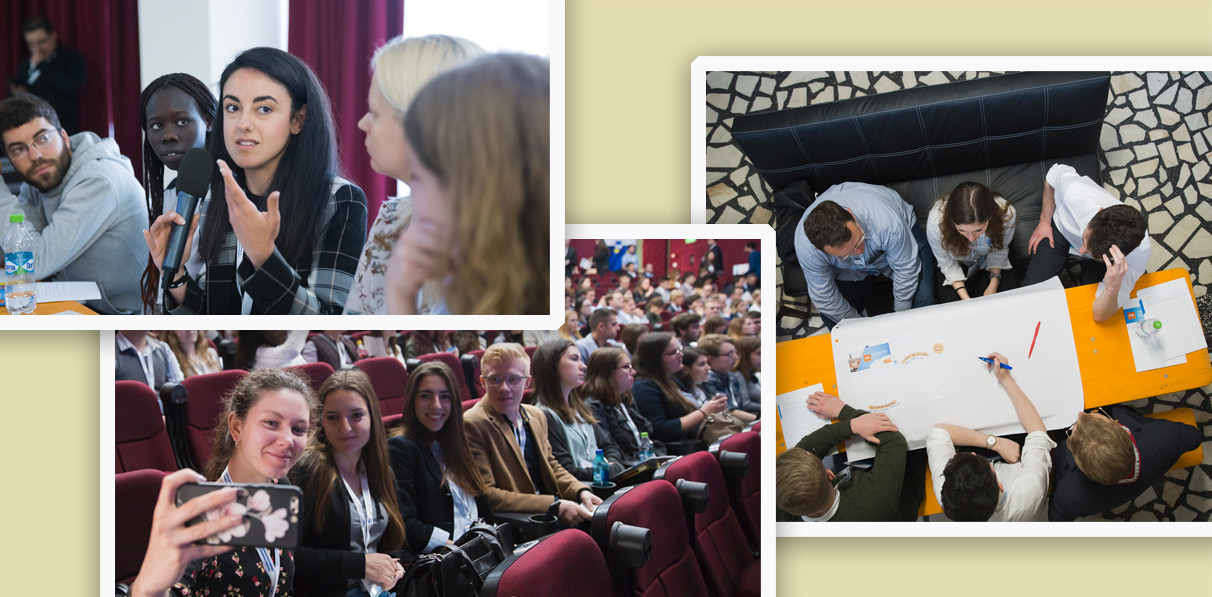
The Young Citizens’ Dialogue event during the Sibiu summit, Sibiu, Romania, 9 May 2019.
They also expected the EU to regulate and facilitate the transition to a more sustainable society and to encourage behavioural change in areas like the circular economy, food waste and the reduction of plastics.
Many Citizens’ Dialogues saw questions about the persisting gender pay gap and the need for the EU to implement measures to ensure gender equality in decision-making positions. There were also calls for a more social Europe, including an increase of the EU’s budget to deal with social issues and the reduction of inequalities between and within Member States.
The young Citizens’ Dialogue ‘Let’s shape the future of Europe together!’ took place on 8 May in Sibiu. More than 300 young people from all across Europe aged 18 to 25 attended to discuss the future of Europe with EU leaders ahead of the summit of 9 May. They brainstormed and discussed issues around five key topics: engagement, democracy, fairness, digital Europe and climate change. As regards the future of the EU, they demanded more influence in policymaking, especially in the light of the recent increase in youth activism related to the climate emergency.
Looking ahead
This report has described the many achievements of the EU in 2019 and the challenges that we still face. New leaders took the helm and, with citizens ever more engaged and participating in the democratic life of Europe, the EU is well equipped to meet those challenges with confidence.
As this report is published in spring 2020, the EU will be fully engaged in turning the European Green Deal into actions, making Europe fit for the digital age, working for social fairness and prosperity in an economy that works for people and preparing the Conference on the Future of Europe. These are just some of the raft of priorities and initiatives that will be described in the 2020 edition of the General Report.
Getting in touch with the EU
In person
All over the European Union there are hundreds of Europe Direct information centres. You can find the address of the centre nearest you at:
https://europa.eu/european-union/contact_en
On the phone or by email
Europe Direct is a service that answers your questions about the European Union. You can contact this service:
– by freephone: 00 800 6 7 8 9 10 11 (certain operators may charge for these calls),
– at the following standard number: +32 22999696, or
– by email via: https://europa.eu/european-union/contact_en
Finding information about the EU
Online
Information about the European Union in all the official languages of the EU is available on the Europa website at: https://europa.eu/european-union/index_en
EU publications
You can download or order free and priced EU publications from: https://op.europa.eu/en/publications
Multiple copies of free publications may be obtained by contacting Europe Direct or your local information centre (see https://europa.eu/european-union/contact_en).
EU law and related documents
For access to legal information from the EU, including all EU law since 1952 in all the official language versions, go to EUR-Lex at: https://eur-lex.europa.eu
Open data from the EU
The EU Open Data Portal (https://data.europa.eu/euodp/en) provides access to datasets from the EU. Data can be downloaded and reused for free, for both commercial and non-commercial purposes.
About
The EU in 2019 — General Report on the Activities of the European Union
European Commission
Directorate-General for Communication
Editorial Service & Targeted Outreach
1049 Brussels
BELGIUM
The EU in 2019 — General Report on the Activities of the European Union was adopted by the European Commission on 19 February 2020 under reference number C(2020) 860.
IDENTIFIERS
General Report on the Activities of the European Union
| ISBN 978-92-76-14817-3 | ISSN 1608-7321 | doi:10.2775/845355 | NA-AD-20-001-EN-C | |
| ISBN 978-92-76-14782-4 | ISSN 1977-3374 | doi:10.2775/335616 | NA-AD-20-001-EN-N | |
| EPUB | ISBN 978-92-76-14748-0 | ISSN 1977-3374 | doi:10.2775/66916 | NA-AD-20-001-EN-E |
| HTML | ISBN 978-92-76-14766-4 | ISSN 1977-3374 | doi:10.2775/87705 | NA-AD-20-001-EN-Q |
Highlights
| ISBN 978-92-76-14852-4 | ISSN 2443-9258 | doi:10.2775/157929 | NA-AP-20-001-EN-C | |
| ISBN 978-92-76-14854-8 | ISSN 2443-9487 | doi:10.2775/042908 | NA-AP-20-001-EN-N | |
| EPUB | ISBN 978-92-76-14833-3 | ISSN 2443-9487 | doi:10.2775/771456 | NA-AP-20-001-EN-E |

The Commission is not liable for any consequence stemming from the reuse of this publication.
Luxembourg: Publications Office of the European Union, 2020
© European Union, 2020
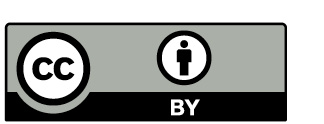
The reuse policy of European Commission documents is based on Commission Decision 2011/833/EU of 12 December 2011 on the reuse of Commission documents (OJ L 330, 14.12.2011, p. 39).
Except otherwise noted, the reuse of this document is authorised under a Creative Commons Attribution 4.0 International (CC-BY 4.0) licence (https://creativecommons.org/licenses/by/4.0/). This means that reuse is allowed provided appropriate credit is given and any changes are indicated.
For any use or reproduction of elements that are not owned by the European Union, permission may need to be sought directly from the respective rightholders.
CREDITS
All photos © European Union unless otherwise stated.
On the cover

- Ursula von der Leyen, President of the European Commission, presents the European Green Deal at the European Council, Brussels, Belgium, 12 December 2019. (© European Union, 2019)
- The EU-27 leaders gather for an informal meeting of the European Council to discuss the future of the European Union, Sibiu, Romania, 9 May 2019. (© European Union, 2019)
- DiscoverEU travellers at the very first DiscoverEU meet-up, Nijmegen, the Netherlands, 12 July 2019. (© European Union, 2019)
- A rugby match for young people organised at the European Commission Berlaymont headquarters as part of the European Week of Sport, Brussels, Belgium, 23 September 2019. (© European Union, 2019)
- The four new leaders of the European Union institutions: Christine Lagarde, President of the European Central Bank, David Sassoli, President of the European Parliament, Ursula von der Leyen, President of the European Commission, and Charles Michel, President of the European Council, Brussels, Belgium, 1 December 2019. (© European Union, 2019)
- An installation promotes the EU’s ‘This time I’m voting’ campaign to encourage electoral participation in the European parliamentary elections inside the Brussels-Luxembourg railway station, Brussels, Belgium, 24 May 2019. (© European Union, 2019)
- Children participate in the Our Forests, Our Future conference tree-planting event to demonstrate the EU’s commitment to a sustainable forestry sector, Brussels, Belgium, 26 April 2019. (© European Union, 2019)
- Antonio Tajani, former President of the European Parliament, shakes hands with David Sassoli, current President of the European Parliament. (© European Union, 2019)
- Charles Michel, current President of the European Council, shakes hands with Donald Tusk, former President of the European Council. (© European Union, 2019)
- Ursula von der Leyen, President of the European Commission, and Jean-Claude Juncker, former President, at the unveiling of his portrait in the Presidents’ Gallery of the European Commission Berlaymont headquarters, Brussels, Belgium, 3 December 2019. (© European Union, 2019)
- EU civil protection staff during an operational meeting with local Albanian authorities in the wake of the 6.4-magnitude earthquake and its aftershocks, Krujë, Albania, 4 December 2019. (© European Union, 2019)
 The EU in 2019
The EU in 2019


